Grandstream Networks GXV3275V3 IP Multimedia Phone User Manual
Grandstream Networks, Inc. IP Multimedia Phone
Contents
- 1. User manual
- 2. User Manual
User Manual
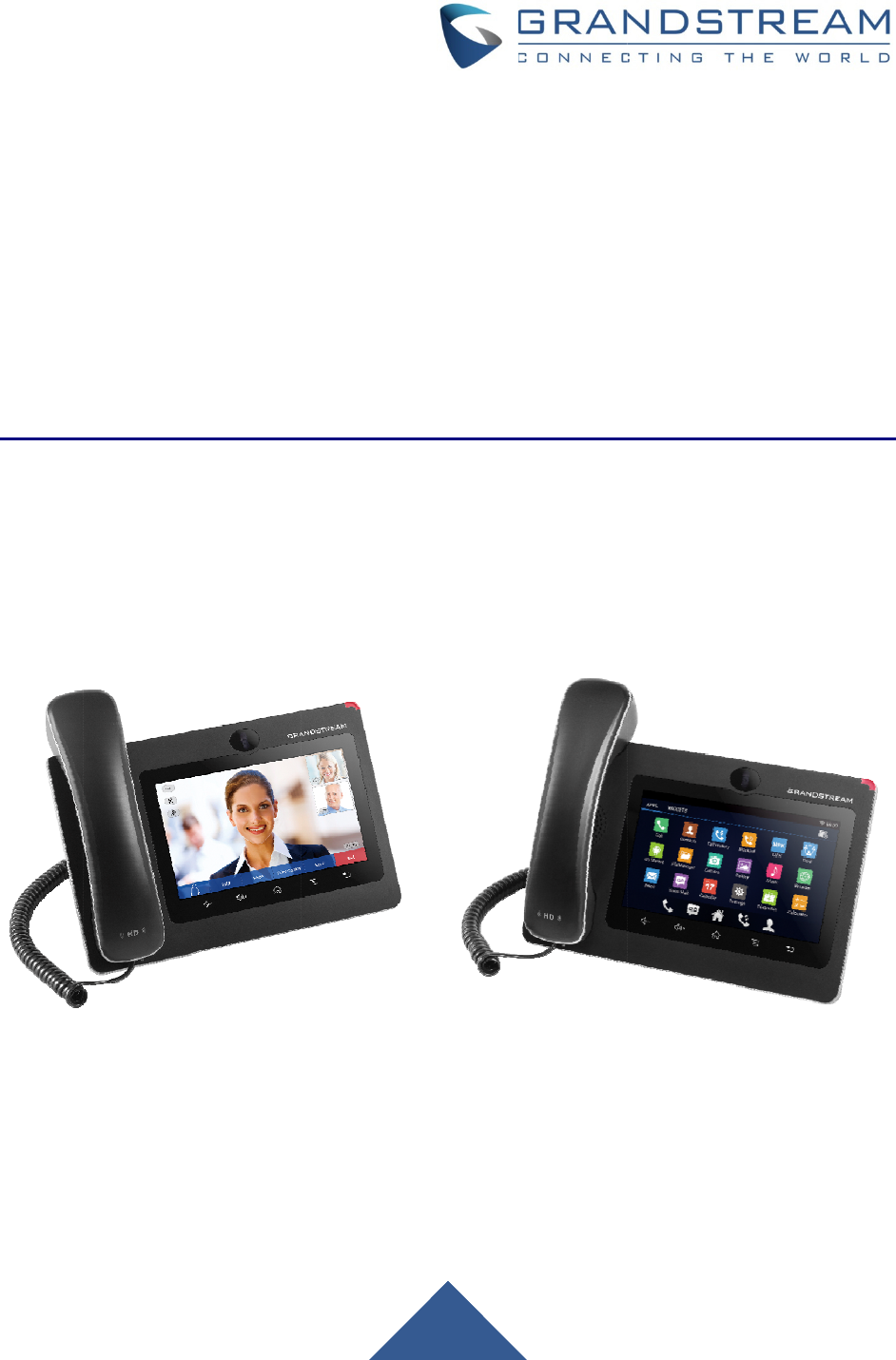
Gra
n
GXV
3
IP M
u
Adm
i
n
dstr
e
3
275
u
ltimedi
a
i
nistra
t
e
am
N
a
Phon
e
t
ion Gu
N
etwo
e
for A
n
ide
rks, I
n
n
droid
T
M
n
c.
M

GXV3275 Administration Guide
Version 1.0.3.186
Page |2
COPYRIGHT
©2017 Grandstream Networks, Inc. http://www.grandstream.com
All rights reserved. Information in this document is subject to change without notice. Reproduction or
transmittal of the entire or any part, in any form or by any means, electronic or print, for any purpose
without the express written permission of Grandstream Networks, Inc. is not permitted.
The latest electronic version of this guide is available for download here:
http://www.grandstream.com/support
Grandstream is a registered trademark and Grandstream logo is trademark of Grandstream Networks, Inc.
in the United States, Europe and other countries.
CAUTION
Changes or modifications to this product not expressly approved by Grandstream, or operation of this
product in any way other than as detailed by this guide, could void your manufacturer warranty.
WARNING
Please do not use a different power adaptor with devices as it may cause damage to the products and void
the manufacturer warranty.

GXV3275 Administration Guide
Version 1.0.3.186
Page |3
FCCCaution
Any Changes or modifications not expressly approved by the party responsible for compliance could void
the user's authority to operate the equipment. This device complies with part 15 of the FCC Rules.
Operation is subject to the following two conditions: (1) This device may not cause harmful interference,
and (2) this device must accept any interference received, including interference that may cause undesired
operation.
Note: This equipment has been tested and found to comply with the limits for a Class B digital device,
pursuant to part 15 of the FCC Rules. These limits are designed to provide reasonable protection against
harmful interference in a residential installation. This equipment generates uses and can radiate radio
frequency energy and, if not installed and used in accordance with the instructions, may cause harmful
interference to radio communications. However, there is no guarantee that interference will not occur in a
particular installation. If this equipment does cause harmful interference to radio or television reception,
which can be determined by turning the equipment off and on, the user is encouraged to try to correct the
interference by one or more of the following measures:
- Reorient or relocate the receiving antenna.
- Increase the separation between the equipment and receiver.
- Connect the equipment into an outlet on a circuit different from that to which the receiver is connected.
- Consult the dealer or an experienced radio/TV technician for help.
FCC Radiation Exposure Statement:
This equipment complies with FCC radiation exposure limits set forth foran uncontrolled environment.
This transmitter must not be co-located or operating in conjunction with any other antenna or transmitter.
This equipment should be installed and operated with minimum distance 20cm between the radiator& your
body.
This transmitter must not be co-located or operating in conjunction with any other antenna or transmitter.
Hereby, Grandstream declares that this device is in compliance with the essential requirements and other
relevant provisions of Directive 2014/53/EU.
GNUGPLINFORMATION
GXV3275 firmware contains third-party software licensed under the GNU General Public License (GPL).
Grandstream uses software under the specific terms of the GPL. Please see the GNU General Public
License (GPL) for the exact terms and conditions of the license.
Grandstream GNU GPL related source code can be downloaded from Grandstream web site from:
http://www.grandstream.com/sites/default/files/Resources/gxv32xx_gpl.zip

GXV3275 Administration Guide
Version 1.0.3.186
Page |4
Table of Contents
DOCUMENT PURPOSE ............................................................................................... 10
CHANGE LOG .............................................................................................................. 11
Firmware Version 1.0.3.186 .................................................................................................................... 11
Firmware Version 1.0.3.180 .................................................................................................................... 11
Firmware Version 1.0.3.177 .................................................................................................................... 11
Firmware Version 1.0.3.171 .................................................................................................................... 11
Firmware Version 1.0.3.162 .................................................................................................................... 11
Firmware Version 1.0.3.158 .................................................................................................................... 12
Firmware Version 1.0.3.144 .................................................................................................................... 12
Firmware Version 1.0.3.131 .................................................................................................................... 12
Firmware Version 1.0.3.92 ...................................................................................................................... 13
Firmware Version 1.0.3.75 ...................................................................................................................... 13
Firmware Version 1.0.3.62 ...................................................................................................................... 13
Firmware Version 1.0.3.55 ...................................................................................................................... 14
Firmware Version 1.0.3.46 ...................................................................................................................... 14
Firmware Version 1.0.3.37 ...................................................................................................................... 14
Firmware Version 1.0.3.30 ...................................................................................................................... 14
Firmware Version 1.0.3.22 ...................................................................................................................... 15
Firmware Version 1.0.3.6 ........................................................................................................................ 16
Firmware Version 1.0.1.54 ...................................................................................................................... 16
Firmware Version 1.0.1.39 ...................................................................................................................... 16
Firmware Version 1.0.1.29 ...................................................................................................................... 16
WELCOME ................................................................................................................... 17
PRODUCT OVERVIEW ................................................................................................ 18
Feature Highlights ................................................................................................................................... 18
GXV3275 Technical Specifications .......................................................................................................... 19
GETTING STARTED ..................................................................................................... 21
Equipment Packaging .............................................................................................................................. 21
GXV3275 Phone Setup ........................................................................................................................... 22
Using the Phone Stand ........................................................................................................................ 22
Using the Slots for Wall Mounting ........................................................................................................ 22
Connecting the GXV3275 ........................................................................................................................ 22
GXV3275 LCD SETTINGS ........................................................................................... 24
Access LCD Settings ............................................................................................................................... 26
Personalized Account .............................................................................................................................. 26
Wireless & Network ................................................................................................................................. 27

GXV3275 Administration Guide
Version 1.0.3.186
Page |5
Ethernet Settings ................................................................................................................................. 27
Wi-Fi Settings ....................................................................................................................................... 28
Bluetooth Settings ................................................................................................................................ 28
VPN ...................................................................................................................................................... 30
Proxy Settings ...................................................................................................................................... 30
Additional Network Settings ................................................................................................................. 30
Tethering & Portable Hotspot ............................................................................................................... 31
Sound ...................................................................................................................................................... 32
Display ..................................................................................................................................................... 32
Storage .................................................................................................................................................... 33
Applications ............................................................................................................................................. 34
View Applications ................................................................................................................................. 34
Manage Applications ............................................................................................................................ 34
Security Settings ...................................................................................................................................... 35
Screen Security .................................................................................................................................... 35
Passwords ........................................................................................................................................... 35
Device Administration .......................................................................................................................... 35
Credentials Storage ............................................................................................................................. 35
Language & Keyboard ............................................................................................................................. 36
Accounts .................................................................................................................................................. 36
Register to Failover SIP Server ............................................................................................................... 38
Date & Time ............................................................................................................................................. 38
About Phone ............................................................................................................................................ 38
Advanced Settings ................................................................................................................................... 38
Multicast Paging ...................................................................................................................................... 40
GXV3275 WEB GUI SETTINGS ................................................................................... 41
Access GXV3275 Web GUI ..................................................................................................................... 41
Saving Changes ...................................................................................................................................... 42
Definitions ................................................................................................................................................ 42
Toolbar ..................................................................................................................................................... 43
Click-To-Dial ............................................................................................................................................ 43
Status Page Definitions ........................................................................................................................... 44
Status/Account Status ......................................................................................................................... 44
Status/Network Status ......................................................................................................................... 44
Status/System Info ............................................................................................................................... 45
Account Page Definitions ........................................................................................................................ 46
Account/General Settings .................................................................................................................... 46
Account/Network Settings .................................................................................................................... 47
Account/SIP Settings ........................................................................................................................... 48
Account/Codec Settings ...................................................................................................................... 54
Account/Call Settings ........................................................................................................................... 57

GXV3275 Administration Guide
Version 1.0.3.186
Page |6
Advanced Settings Page Definitions ....................................................................................................... 64
Advanced Settings/General Settings ................................................................................................... 64
Advanced Settings/Call Features ........................................................................................................ 65
Advanced Settings/Video Settings ....................................................................................................... 69
Advanced Settings/Tone Generator ..................................................................................................... 69
Advanced Settings/Multicast Paging ................................................................................................... 70
Advanced Settings/GDS Settings ........................................................................................................ 71
Advanced Settings/MPK General Settings .......................................................................................... 71
Advanced Settings/MPK LCD Settings ................................................................................................ 71
Maintenance Page Definitions ................................................................................................................. 72
Maintenance/Network Settings ............................................................................................................ 72
Maintenance/Wi-Fi Settings ................................................................................................................. 75
Maintenance/Time Settings ................................................................................................................. 76
Maintenance/Web/SSH Access ........................................................................................................... 76
Maintenance/Upgrade ......................................................................................................................... 77
Maintenance/Syslog ............................................................................................................................ 81
Maintenance/Logcat ............................................................................................................................ 82
Maintenance/Debug ............................................................................................................................. 82
Maintenance/Language ....................................................................................................................... 82
Maintenance/Event Notification ........................................................................................................... 83
Maintenance/TR-069 ........................................................................................................................... 84
Maintenance/Contacts ......................................................................................................................... 84
Maintenance/LDAP Book ..................................................................................................................... 86
Maintenance/Broadsoft Directories...................................................................................................... 88
Maintenance/Broadsoft IM&P .............................................................................................................. 89
Maintenance/Device Manager ............................................................................................................. 90
Reboot ..................................................................................................................................................... 94
UPGRADING AND PROVISIONING ............................................................................ 95
Upgrade and Provisioning Configuration ................................................................................................. 95
Upload Firmware Locally ......................................................................................................................... 96
Upgrade via SD Card .............................................................................................................................. 97
No Local Firmware Servers ..................................................................................................................... 98
Provisioning and Configuration File Download ....................................................................................... 98
BACKUP ....................................................................................................................... 99
Generate Backup File .............................................................................................................................. 99
Restore from Backup File ...................................................................................................................... 100
Automatic Backup .................................................................................................................................. 101
DATA WIPING ............................................................................................................. 102
FACTORY RESET ...................................................................................................... 104

GXV3275 Administration Guide
Version 1.0.3.186
Page |7
Restore to Factory Default via LCD Menu............................................................................................. 104
Restore to Factory Default via the Web GUI ......................................................................................... 105
Restore to Factory Default via Hard Keys ............................................................................................. 105
SAFE MODE ............................................................................................................... 107
EXPERIENCING THE GXV3275 APPLICATION PHONE .......................................... 108

GXV3275 Administration Guide
Version 1.0.3.186
Page |8
Table of Tables
Table 1: GXV3275 Features in a Glance .................................................................................................... 18
Table 2: GXV3275 Technical Specifications ................................................................................................ 19
Table 3: Equipment Packaging ................................................................................................................... 21
Table 4: GXV3275 LCD Settings ................................................................................................................. 24
Table 5: GXV3275 Storage Category and Actions ...................................................................................... 33
Table 6: GXV3275 Web Access .................................................................................................................. 43

GXV3275 Administration Guide
Version 1.0.3.186
Page |9
Table of Figures
Figure 1: GXV3275 Package Content ......................................................................................................... 21
Figure 2: Built In Stand And Mounting Slots On The GXV3275. ................................................................. 22
Figure 3: Tab on the Handset Cradle .......................................................................................................... 22
Figure 4: GXV 3275 Back / Side View ........................................................................................................ 23
Figure 5: GXV3275 System Settings .......................................................................................................... 26
Figure 6: GXV3275 Bluetooth Settings ....................................................................................................... 29
Figure 7: GXV3275 Bluetooth Paired Device Settings ............................................................................... 30
Figure 8: GXV3275 Wi-Fi Hotspot .............................................................................................................. 32
Figure 9: GXV3275 Storage ........................................................................................................................ 33
Figure 10: Erase SD Card ........................................................................................................................... 34
Figure 11: GXV3275 Accounts Sync Up Settings - Google Account Signed In .......................................... 36
Figure 12: GXV3275 Accounts Sync Up Settings - Google Account Synced Up ....................................... 37
Figure 13: GXV3275 Accounts Sync up Settings - Select Browser, Calendar and Contacts ..................... 37
Figure 14: GXV3275 Google Play Account ................................................................................................. 37
Figure 15: GXV3275 UCM Auto Config Number – Select Registering Numbers ....................................... 39
Figure 16: GXV3275 UCM Auto Config Number – Enabling Registering Number ..................................... 39
Figure 17: GXV3275 Web GUI - Login ....................................................................................................... 41
Figure 18: GXV3275 Main Screen - IP Address ......................................................................................... 41
Figure 19: GXV3275 Web UI Tool Bar ........................................................................................................ 43
Figure 20: Click to Dial Feature .................................................................................................................. 43
Figure 21: Click to Dial Menu and Calls Status ........................................................................................... 44
Figure 22: Reboot Button ............................................................................................................................ 94
Figure 23: GXV3275 Upgrade Configuration via LCD ................................................................................ 95
Figure 24: GXV3275 Upgrade Configuration via Web GUI ........................................................................ 96
Figure 25: Firmware Upgrade ..................................................................................................................... 97
Figure 26: GXV3275 Backup ...................................................................................................................... 99
Figure 27: Select Backup Applications ........................................................................................................ 99
Figure 28: Select Backup Applications to Be Restored ............................................................................ 100
Figure 29: Restore Process ...................................................................................................................... 100
Figure 30: Automatic Backup Settings ...................................................................................................... 101
Figure 31: Data Wiping ............................................................................................................................. 102
Figure 32: Reboot Confirmation Message ................................................................................................ 103
Figure 33: GXV3275 LCD - Factory Reset ............................................................................................... 104
Figure 34: GXV3275 LCD - Confirm Factory Reset .................................................................................. 105
Figure 35: GXV3275 Web GUI - Factory Reset ........................................................................................ 105
Figure 36: GXV3275 Web GUI - Confirm Factory Reset .......................................................................... 105

GXV3275 Administration Guide
Version 1.0.3.186
Page |10
DOCUMENTPURPOSE
This document describes how to configure the GXV3275 via phone's LCD menu and web UI menu to fully
manipulate phone's features. The intended audiences of this document areVoIPadministrators. To learn
the basic functions of GXV3275, please visit http://www.grandstream.com/support to download the latest
“GXV3275User Guide”.
This guide covers following topics:
Product Overview
Getting Started
GXV3275 LCD Settings
GXV3275 Web GUI Settings
Upgrading and provisioning
Backup
Data Wiping
Restore factory default settings
Safe Mode
Experiencing the GXV3275 applications

GXV3275 Administration Guide
Version 1.0.3.186
Page |11
CHANGELOG
This section documents significant changes from previous versions of administration guide for GXV3275.
Only major new features or major document updates are listed here. Minor updates for corrections or
editing are not documented here.
FirmwareVersion1.0.3.186
Added Bluetooth patch for BlueBorne vulnerability.
Added the option Play warning tone for Auto Answer Intercom. [Play warning tone for Auto Answer
Intercom]
Supported TLSv1.1 and TLSv1.2.
Added option to allow device to ring when “Auto Preview” is enabled. [Auto Preview]
Added support for auto downloading firmware/config randomly in time window. [Automatic Upgrade]
Added support fordisplaying more Programmable keys in call interface. [Programmable Keys]
Removed icon for reboot from web UI Advanced Settings General Settings “STUN Server”,
“Use NAT IP” and “SIP TLS Private Key” settings.[General Settings]
Added support for removing previous upgrade notification bar when doing manual upload
upgrading.[Upload Firmware Locally]
Added admin authentication for factory reset if Configuration via Keypad Menu is set to “Basic settings
only” or “Constraint mode”. The input will take effect after about 10 seconds of input. [Configuration via
Keypad Menu]
FirmwareVersion1.0.3.180
Added the option to remove the Register's Authorization header after the first successful register [Add
Auth Header On RE-REGISTER].
Supported new config file format: cfggxv3275.xml.
Updated that previewing an incoming video call will display DTMF programmable key.
FirmwareVersion1.0.3.177
Added support for Syslog over SSL/TLS. [Syslog Protocol]
Added option for DNS SRV Failover mode [DNS SRV Fail-over Mode]
Added option to set call forward when phone is set to DND. [Forward when DND]
Updated to enable automatically trim the account name and display name on web UI. [Account Name]
FirmwareVersion1.0.3.171
Added sending SIP INFO message with “record” header when record key is pressed. [Record Mode]
Added “Record Mode” to specify the location for saving call recording. [Record Mode]
Added support for displaying the account name on Click-To-Dial page. [Click-To-Dial]
FirmwareVersion1.0.3.162
Added “Ignore Alert-Info header”. [Ignore Alert-Info header]

GXV3275 Administration Guide
Version 1.0.3.186
Page |12
Added support for GDS3710 integration. [Advanced Settings/GDS Settings]
Added “Disable RJ9 Headset Auto Detect”. [Disable RJ9 Headset Auto Detect]
Added support for HTTP URL authentication when challenged by camera for getting MJPEG stream.
[Special Feature]
Added support to SIP register to failover SIP server. [Register to Failover SIP Server]
Added support to user secondary SIP server for guest login. [Guest Login]
FirmwareVersion1.0.3.158
Added Account Call Settings Intercom barging. [Intercom Barging]
Added support ‘{‘, ‘}’ as valid character in Maintenance Contacts Download Server. [Download
Server]
Added “Constraint Mode” in Maintenance Upgrade Configuration via Keypad Menu.
Updated preview function before answering the call would keep playing ringback on caller side.[Enable
Function for Incoming Call]
Improving changing syslog level does not need reboot to take effect. [Syslog]
Added “Data Wiping” in LCD Settings.[Data Wiping]
Added support of SNI extension for TLS. [SNI]
Updated the default NTP server. [Assign NTP Server Address]
FirmwareVersion1.0.3.144
Improved web UI security by avoiding reading/writing cookie.
Improved the utility of “Use # as Dial Key” to dial out. [Use # as DialKey]
Added new option “Dial Prefix” under MPK Ext Settings Key Mode. [Key Mode]
Added support of “Click to Dial” feature on web GUI.
Set DHCP VLAN Override to "Encapsulated in DHCP Option 43" by default. [DHCP VLAN Override]
Added support of sending only SIP log under syslog settings. [Syslog]
Added “Enable Enterprise Contacts Timeout Auto Search”. [Enable Enterprise Contacts Timeout Auto
Search]
Removed “Jitter Buffer Maximum (ms)” option from codec settings.
Added option “Custom Alert-Info for Auto Answer”. [Custom Alert-Info for Auto Answer]
Set default value for option “Handset TX gain(dB)” to “-6”. [Handset TX Gain ]
Set default value for option “Handset Equalizer RX” to “Fidelity”. [Handset Equalizer RX]
Added “Attended Transfer Only” to Default Transfer Mode. [Default Transfer Mode]
FirmwareVersion1.0.3.131
Added options “Enable Video FEC”, “Video FEC Mode”, and “FEC Payload Type. [Account/Codec
Settings]
Added option “Enable MPK Auto Arrangement”.
Added support IPv6 on GXV32xx. [Maintenance/Network Settings]
Added an option “Enable 3.5mm Headset Control”. [Maintenance/Device Manager]
Added ability to configure the provisioning/firmware URL with variable.[Maintenance/Upgrade]
Added ability to configure timeout on phone LCD for on-hook dialing.[Advanced Settings/Call

GXV3275 Administration Guide
Version 1.0.3.186
Page |13
Features]
Added option “Enable CDP”. [Maintenance/Network Settings]
Added options “GUI Customization File Download Mode”, “GUI Customization File URL”, “GUI
Customization File HTTP/HTTPS Username”, “GUI Customization File HTTP/HTTPS Password”, and
“Use Configuration of Config File Server”. [Maintenance/Upgrade]
Added option “Disable Web GUI”. [Maintenance/Web/SSH Access]
Added an option to mute the touch screen clicks only. [Sound]
Added ability for “Users” to check/edit the MPK Extension when connectedwith user privilege.
Added "Different Networks for Data and VOIP Calls" option.[Maintenance/Network Settings]
Adjusted the RX/TX options for headsets.
Added the RX/TX gain options for Virtual Sound Card. [Maintenance/Device Manager]
Added support for RFC3605.
Added the ability to connect to the nearest Wi-Fi Access Point.
Added validation check for Multicast Address.
Added "Dial DTMF Button Size" and "Dial DTMF Button Color" options.[Advanced Settings/Call
Features]
Added options “Show Dial DTMF Softkey” and “CID to Show Dial DTMF Softkey”. [Account/Call
Settings]
Added support for DHCP Option 132 and 133 tunneled through DHCP Option 43.
[Maintenance/Network Settings]
Added "Attended Conference", "Use 3rd Party App as Basic Phone", and "Auto UnHold When Press
the Line Key" options. [Advanced Settings/Call Features]
FirmwareVersion1.0.3.92
Changed default config file update method to HTTPS for security purpose.[Maintenance/Upgrade]
Added H.263 support and RTCP packets loss tolerance.[Account/Codec Settings]
Added option “Use First Matching Vocoder in 200OK SDP”. [Account/Codec Settings]
Added option “Authentication Type”for Broadsoft XSI feature.[Maintenance/Broadsoft Directories]
Added IEEE-48-addr and IEEE-EUI-64 support in PEI (P-Emergency-Info) header.
FirmwareVersion1.0.3.75
Add Codec Negotiation Priority. [Account/Codec Settings]
Add Video Display Mode. [Advanced Settings/Video Settings]
Add Phonebook Key Function. [Maintenance/Contacts]
Add Firmware HTTP/HTTPS User Name. [Maintenance/Upgrade]
Add Firmware HTTP/HTTPS Password. [Maintenance/Upgrade]
Update the “Upgrade” configuration options, “Firmware Upgrade Via” and “Config Via” have been
separate to two options. [Maintenance/Upgrade]
FirmwareVersion1.0.3.62
Add Configure Door System. [Account/Call Settings]
Add Disable Video Call Feature. [Advanced Settings/Call Features]

GXV3275 Administration Guide
Version 1.0.3.186
Page |14
FirmwareVersion1.0.3.55
Add Use H.264 Constrained Profiles. [Account/Codec Settings]
Add HTTP/HTTPS User-Agent. [Maintenance/Network Settings]
Add SIP User-Agent. [Maintenance/Network Settings]
Add Allow DHCP Option 242 (Avaya IP Phones). [Maintenance/Upgrade]
Add Authentication Type. [Maintenance/Broadsoft Directories]
FirmwareVersion1.0.3.46
Add RTP IP Filter. [Account/SIP Settings]
FirmwareVersion1.0.3.37
Add Allow Unsolicited REFER. [Account/SIP Settings]
Add Allow SIP Reset. [Account/SIP Settings]
Add Opus Payload Type. [Account/Codec Settings]
Add Trusted CA Certificates. [Advanced Settings/General Settings]
Add Import Trusted CA Certificates. [Advanced Settings/General Settings]
Add Enable DHCP VLAN. [Maintenance/Network Settings]
Add Layer 2 QoS 802.1Q/VLAN Tag (Wi-Fi). [Maintenance/Network Settings]
Add Layer 2 QoS 802.1p Priority Value (Wi-Fi). [Maintenance/Network Settings]
Add Upload Device Configuration.[Maintenance/Upgrade]
FirmwareVersion1.0.3.30
Add Re-register before Expiration. [Account/SIP Settings]
Add Enable SIP OPTIONS Keep Alive. [Account/SIP Settings]
Add SIP OPTIONS Keep Alive Interval. [Account/SIP Settings]
Add OPTIONS Keep Alive Maximum Tries. [Account/SIP Settings]
Add Validate Certification Chain. [Account/SIP Settings]
Update Domain Certificate to Trusted CA Certificates. [Account/SIP Settings]
Add G726-32 ITU Payload. [Account/Codec Settings]
Add G726-32 Dynamic PT. [Account/Codec Settings]
Add Packetization Mode. [Account/Codec Settings]
Add Enable SRTP Key Life Time. [Account/Codec Settings]
Add Disable Presentation. [Account/Call Settings]
Add Don’t Prompt Missed Call under Call Log. [Account/Call Settings]
Add NEC / WorldStone / Baudisch Door System under Special Feature. [Account/Call Settings]
Add Enable BroadSoft Call Park. [Account/Call Settings]
Add Multicast Paging under Programmable Keys. [Account/Call Settings]
Add SIP Domain.[Advanced Settings/General Settings]
Add Call Forward under Enable Function for Incoming Call. [Advanced Settings/Call Features]
Update Dialer Interface Priority to Always Display Dialer Interface. [Advanced Settings/Call Features]
Add the Desktop Menu as Hook Dial. [Advanced Settings/Call Features]

GXV3275 Administration Guide
Version 1.0.3.186
Page |15
Add Call Function Buttons. [Advanced Settings/Call Features]
Add Auto Config CPT by Region. [Advanced Settings/Tone Generator]
Add Force BLF Call-pickup by Prefix.
Add Show IP Address on Account Widget. [Maintenance/Network Settings]
Add 802.1x Secret under EAP-MD5 and EAP-PEAP. [Maintenance/Network Settings]
Add Validate Server Certificate.[Maintenance/Upgrade]
Add Disable SIP NOTIFY Authentication. [Maintenance/Upgrade]
Add Send SIP Log. [Maintenance/Syslog]
Add EVENT NOTIFY. [Maintenance/Event Notif]
Add HTTP/HTTPS User Name for downloading phonebook file. [Maintenance/Contacts]
Add HTTP/HTTPS Password for downloading phonebook file. [Maintenance/Contacts]
Update BroadSoft Directory Hits option under BroadSoft Directories. [Maintenance/Broadsoft
Directories]
Update BroadSoft Directory Order option under BroadSoft Directories. [Maintenance/Broadsoft
Directories]
Add LDAP Dialing Default Account. [Maintenance/LDAP Book]
Add BroadSoft Directory User ID. [Maintenance/Broadsoft Directories]
Add Handset TX Gain. [Maintenance/Device Manager]
Add Handset RX Gain. [Maintenance/Device Manager]
Add Handset Equalizer RX. [Maintenance/Device Manager]
FirmwareVersion1.0.3.22
Update Wi-Fi Settings. [Wi-Fi Settings]
Update Display. [Display]
Update Status/System Info. [Status/System Info]
Update General Settings. [Account/General Settings]
Update Codec Settings. [Account/Codec Settings]
Update Call Settings. [Account/Call Settings]
Update Call Features. [Advanced Settings/Call Features]
Update Tone Generator. [Advanced Settings/Tone Generator]
Add Multicast Paging. [Advanced Settings/Multicast Paging]
Update MPK General Settings.
Update MPK LCD Settings. [Advanced Settings/MPK LCD Settings]
Update Network Settings. [Maintenance/Network Settings]
Update WIFI Settings. [Maintenance/Wi-Fi Settings]
Update Contact Settings. [Maintenance/Contacts]
Update LDAP Book Settings. [Maintenance/LDAP Book]
Update BroadSoft Directories. [Maintenance/Broadsoft Directories]
Add BroadSoft IM&P. [Maintenance/Broadsoft IM&P]
Update Device Manager Settings. [Maintenance/Device Manager]

GXV3275 Administration Guide
Version 1.0.3.186
Page |16
FirmwareVersion1.0.3.6
Add Full-screen Video Calling. [Personalized Account]
Add ICE Contacts. [Maintenance/Contacts]
Add Session Expiration. [Account/SIP Settings]
Add Caller ID display. [Account/SIP Settings]
Add SIP timer D interval. [Account/SIP Settings]
Add Check Domain Certificate. [Account/SIP Settings]
Add Disable DialPlan. [Account/Call Settings]
Add Multiply Server Mode Group. [Account/Call Settings]
Add DND Call Feature On. [Account/Call Settings]
Add DND Call Feature Off. [Account/Call Settings]
Add Programmable keys. [Account/Call Settings]
Add Display Soft Keyboard. [Advanced Settings/Call Features]
Add BS Contacts Hits. [Maintenance/Broadsoft]
Add BS Contacts Order. [Maintenance/Broadsoft]
Delete Handset TX Gain (dB). [Maintenance/Device Manager]
Delete Handset RX Gain (dB). [Maintenance/Device Manager]
FirmwareVersion1.0.1.54
Add Hide LDAP Contacts.
Add Hide Local Call History.
Add BS Call Log Update Interval.
Add SRTP Encryption Bit.
Add BroadWorks Xsi features.
Add Enable Function for Incoming Call.
FirmwareVersion1.0.1.39
Add Check SIP User ID for Incoming INVITE setting.
Add Only Accept SIP Requests from Known Servers setting.
Add Configuration via Keypad Menu setting.
Delete Configuration via LCD Menu setting.
FirmwareVersion1.0.1.29
This is the initial version.

GXV3275 Administration Guide
Version 1.0.3.186
Page |17
WELCOME
Thank you for purchasing Grandstream GXV3275 IP Multimedia Phone for AndroidTM. The powerful
GXV3275 combines a comprehensive 6-line IP video phone, a multi-platform video conferencing solution
and the user experience of anAndroid tablet to offer an all-in-one voice, video, data, and mobility solution.
The GXV3275 is a 6-line IP multimedia phone with a 7” capacitive touchscreen that runs on Android™ OS
version 4.2, offering access to the hundreds of thousands of Android apps in the Google Play Store
-including business productivity apps such as Skype™, Microsoft Lync™, Salesforce1™, and
GoToMeeting™. The phone features dual Gigabit ports, HD audio and HD video, a built-in web browser,
integrated Wi-Fi (802.11b/g/n) for network flexibility, PoE, and a tiltable CMOS camera. The GXV3275’s
integrated Bluetooth allows users to sync calendars and contacts between their mobile phone and the
GXV3275, use hands-free Bluetooth headsets and to transfer calls between the GXV3275 and their mobile
phone. By combining a state-of-the-art IP phone, an advanced video conferencing solution, and the
functionality of a tablet, businesses throughout the world can now use the GXV3275 for all communication
and productivity needs.
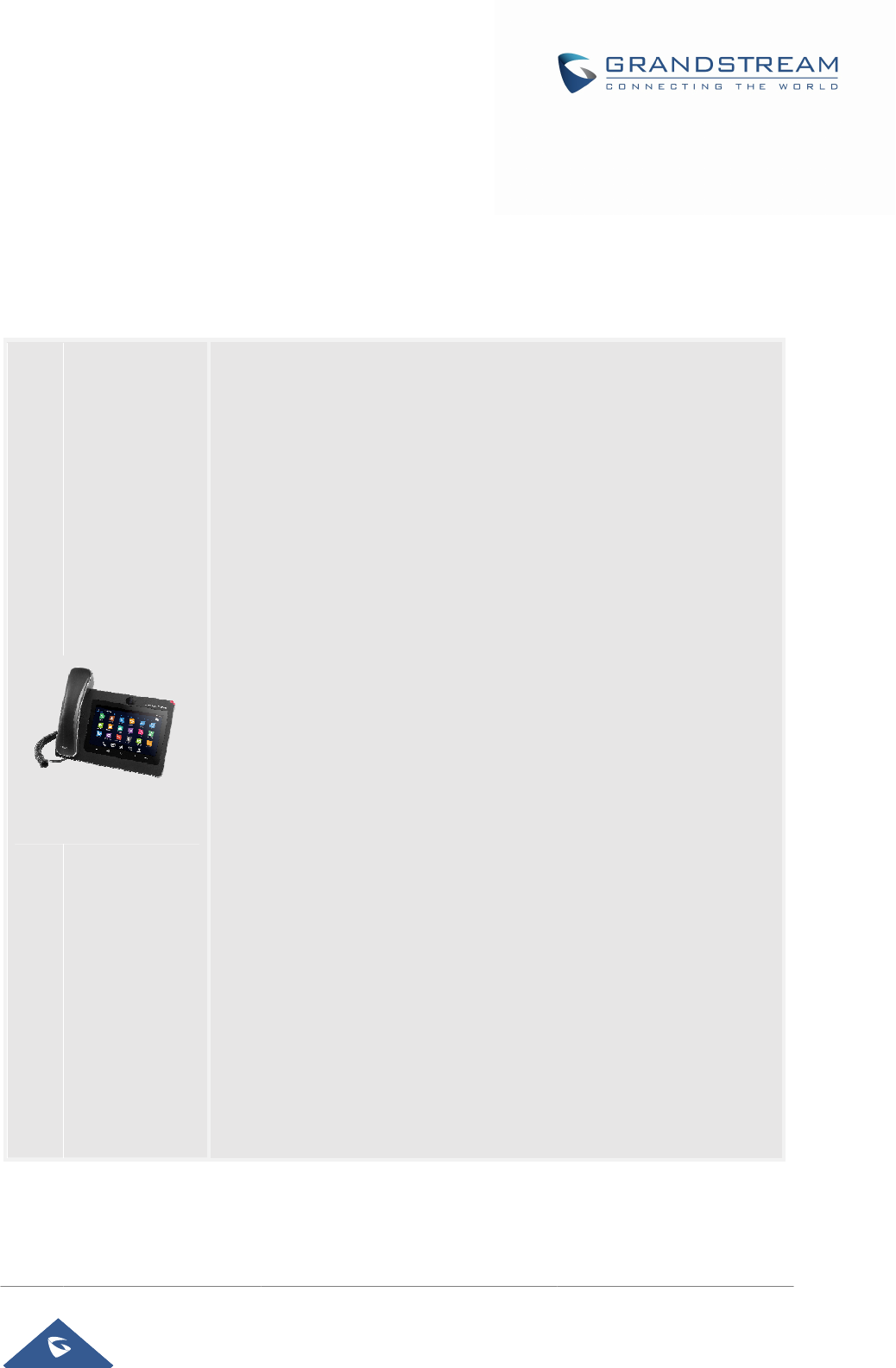
PROD
Featur
e
The follo
w
UCTOV
E
e
Highligh
t
w
ing table co
n
GXV3275
E
RVIE
W
t
s
n
tains the ma
j
6
a
c
vi
w
D
(
8
S
7
"
p
i
H
a
d
R
t
h
p
r
G
I
n
c
a
I
P
O
F
r
C
G
GXV3275
A
Ver
s
j
or features
o
Table 1: GXV3
2
lines with
u
c
count with
v
deo confere
n
w
ith up to 100
0
ual switched
8
02.11b/g/n),
D, HDMI, EH
"
(1024x600)
i
xel CMOS s
e
D wideband
d
vanced aco
u
R
uns the
A
nd
r
h
e Google
P
r
oductivity a
p
G
o
T
oMeeting
n
tegrate with
a
meras to vi
e
P
cameras in
s
O
ffers a multi
-
r
ee IPVideo
Ta
reate
A
ndro
G
XV3275 usin
A
dministratio
n
s
ion 1.0.3.18
6
o
f the GXV32
7
2
75 Features i
n
u
p to 6 SIP
v
ideo mail, u
p
n
ce, phoneb
o
0
records
auto-sensin
g
PoE+, Blue
t
S with Plantr
o
capacitive (
e
nsor camer
a
audio, full
-
u
stic echo ca
r
oid™ Opera
t
P
lay Store -
p
ps such a
s
Grandstrea
m
e
w live came
r
s
talled on the
-
platform vid
e
Ta
lk, Skype,
M
id applicatio
g Google's A
n
Guide
6
7
5:
n
a Glance
accounts i
n
p
to 6-way
a
o
ok with up t
o
g
10/100/10
0
t
ooth with Bl
u
o
nics heads
e
5 points) to
u
a
with privacy
-
duplex han
d
ncellation
t
ing System
4
which inclu
d
s
Skype, Mi
c
m
's GXV ser
i
r
a feeds and
t
same netwo
r
e
o conferenc
M
icrosoft Lyn
c
ns for any
PI and Gran
d
n
cluding FR
E
a
udio confere
o
1000 cont
a
0
0Mbps net
w
u
eBorne vul
n
e
ts support
u
ch screen T
shutter
d
s-free spe
a
4
.2 and offer
s
d
es thousan
d
c
rosoft Lync
i
es of IP vid
e
t
o receive al
e
r
k
ing solution
(
c
, and more)
business n
e
d
stream's SD
K
Pa
g
E
E IPVideoT
a
nce and 3-
w
a
cts, call hist
o
w
ork ports,
W
n
erability, U
S
FT LCD, me
g
a
kerphone
w
s
full access
d
s of busin
e
, SalesForc
e
e
o surveillan
e
rts/alarms fr
o
(
Grandstrea
m
e
ed to run
o
K
toolkit
g
e |18
a
lk
w
ay
o
ry
W
iFi
S
B,
g
a
w
ith
to
e
ss
e
1,
ce
o
m
m
's
o
n
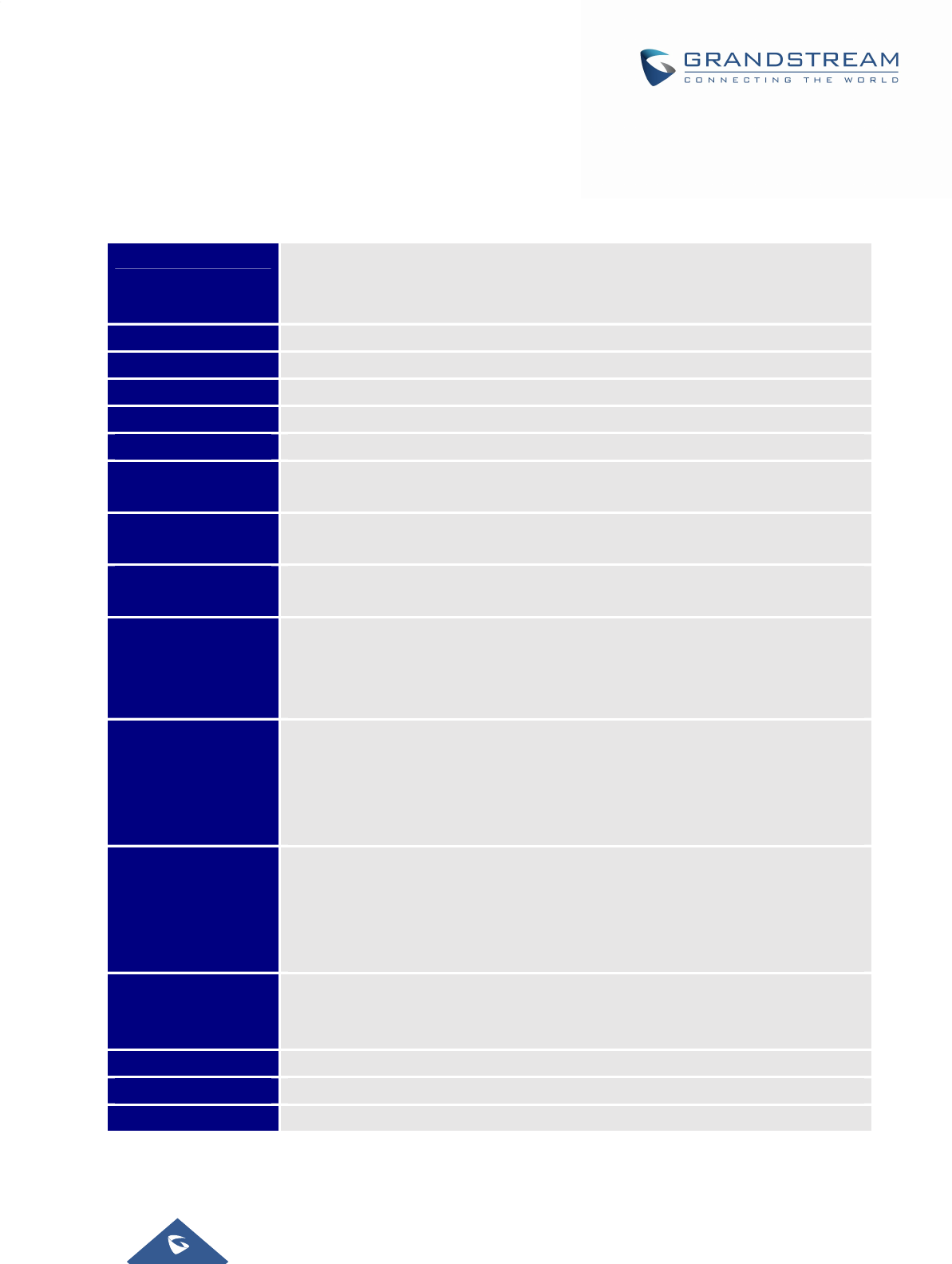
GXV3275 Administration Guide
Version 1.0.3.186
Page |19
GXV3275TechnicalSpecifications
The following table resumes all the technical specifications including the protocols / standards supported,
voice codecs, telephony features, languages and upgrade/provisioning settings for the phone GXV3275.
Table 2: GXV3275 Technical Specifications
Protocols/Standards SIP RFC3261, TCP/IP/UDP, RTP/RTCP, HTTP/HTTPS, ARP, ICMP, DNS (A
record, SRV, NAPTR), DHCP, PPPoE, SSH, TFTP, NTP, STUN, SIMPLE,
LLDP-MED, LDAP, TR-069, 802.1x, TLSv1.1, TLSv1.2, SRTP, RFC3605
Network Interfaces Dual switched 10/100/1000 Mbps ports with integrated PoE
Graphic Display 7"(1024×600)capacitive(5points)touch screen TFT LCD
Camera Tiltable mega pixel CMOS camera privacy shutter
Bluetooth Yes, integrated. Bluetooth 3.0, Bluetooth patch for BlueBorne vulnerability.
Wi-Fi Yes, integrated. 802.11b/g/n
Auxiliary Ports RJ9 headset jack (allowing EHS with Plantronics headsets), 3.5mm stereo
headset with microphone,dual USB ports, SD, mini HDMI
Feature Keys 2 function keys VOLUME +/-, 3 dedicated Android keys for HOME, MENU, and
BACK
Voice Codec Support for G.711µ/a, G.722 (wide-band), G.726-32, G.729, iLBC,
OPUS,in-band and out-of-band DTMF (In audio, RFC2833, SIP INFO)
Video Codec and
Capabilities
H.264 BP/MP/HP,H263, video resolution up to 720p HD, frame rate up to 30 fps,
bit rate up to 2Mbps, 3-way video conference, anti-flickering, auto focus and auto
exposure, PIP (Picture-in-Picture), on-screen-display, camera block, still picture
capture/store, video recording, visual voice message indicator
Telephony Features Hold, transfer, forward (unconditional/no-answer/busy), call park/pickup, 6-way
audio conference, shared-call-appearance (SCA) / bridged-line-appearance
(BLA), virtual MPK, downloadable phone book (XML, LDAP), call waiting, call
history, boss-secretary virtual button, flexible dial plan, hot desking, personalized
music ringtones, server redundancy & fail-over
Sample Applications Skype, Google Hangouts, Microsoft Lync, Web browser, GoToMeeting,
Facebook, Twitter, YouTube, news, weather, stock, Internet Radio, Pandora,
Last.fm, Yahoo Flickr, Photo bucket, alarm clock, Google calendar, mobile phone
data import/export via Bluetooth, etc. API/SDK available for advanced custom
application development
Applications
Deployment
Allow various Android operating system 4.2 compliant applications to be
developed, downloaded and run in the embedded device with provisioning
control
HD Audio Yes, both handset and speakerphone support HD (wide-band) audio
Base Stand Yes, integrated stand with multiple adjustable angles. Wall mountable
QoS Layer 2 QoS (802.1Q, 802.1p) and Layer 3 (ToS, DiffServ, MPLS) QoS
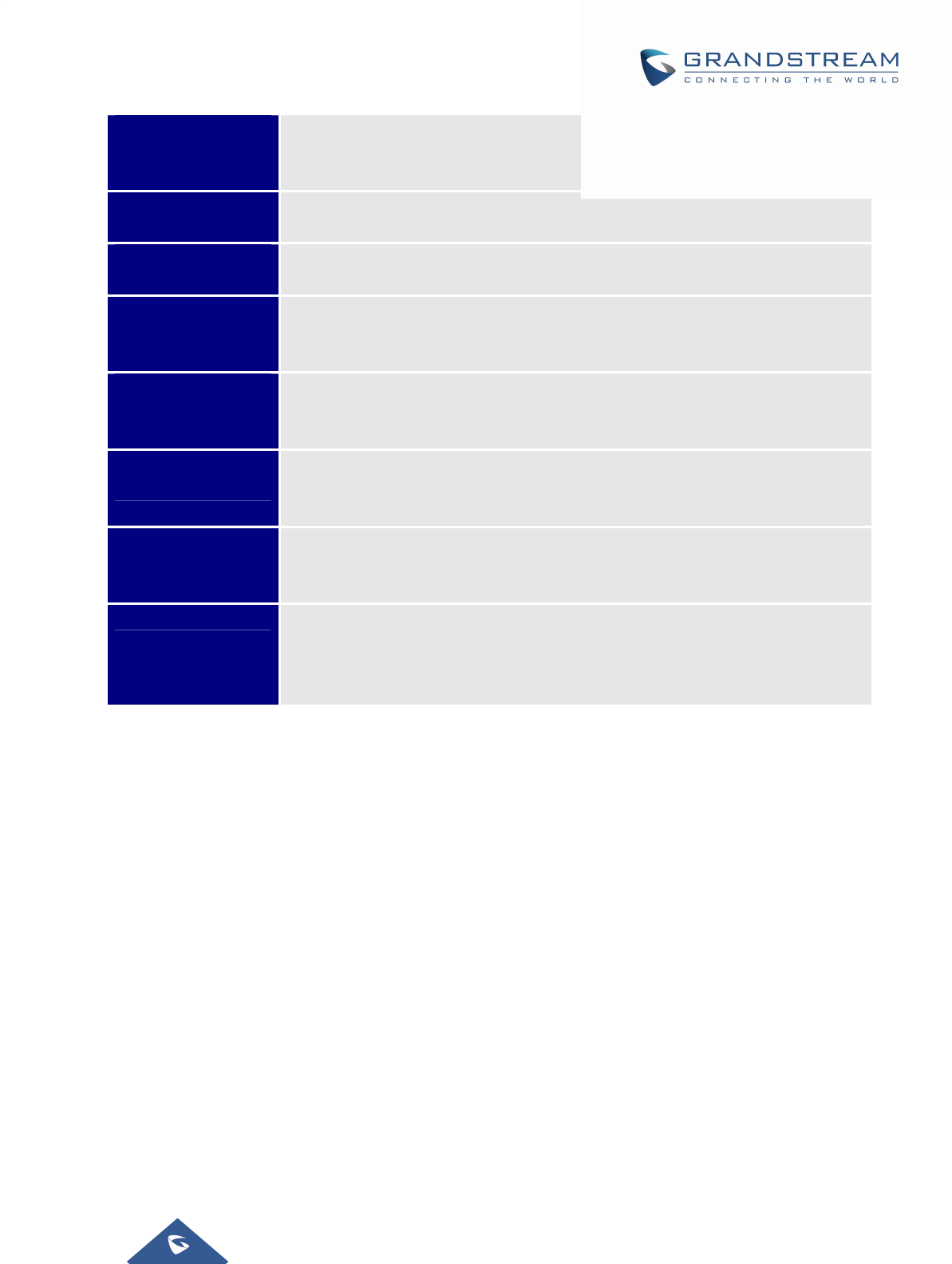
GXV3275 Administration Guide
Version 1.0.3.186
Page |20
Security User and administrator level access control, MD5 and MD5-sess based
authentication, 256-bit AES encrypted configuration file, TLS, SRTP, HTTPS,
802.1x media access control
Multi-language English, German, Italian, French, Spanish, Portuguese, Russian, Croatian,
Chinese, Korean, Japanese, and more
Upgrade/ Provisioning Firmware upgrade via TFTP / HTTP / HTTPS or local HTTP upload, mass
provisioning using TR-069 or AES encrypted XML configuration file
Power and Green
Energy Efficiency
Universal power adapter included: Input: 100-240VAC 50-60Hz; Output: 12VDC,
1.5A (18W);
Integrated PoE+ (Power-over-Ethernet) 802.3at, Class 4
Physical Dimension : 252mm (W) x 211mm (L) x 84mm (H)
Unitweight: 1.08kg
Packageweight: 1.77kg
Temperature and
Humidity
Operating: 0oC to 40oC
Storage: -10oC to 60oC
Humidity: 10% to 90% Non-condensing
Package Content GXV3275 phone, handset with cord, base stand, universal power supply,
network cable, lens cleaning cloth, quick installation guide, brochure, GPL
license
Compliance FCC: Part 15 (CFR 47) Class B; UL 60950 (power adapter)
CE : EN55022 Class B, EN55024, EN61000-3-2, EN61000-3-3, EN60950-1,
EN62479, RoHS
RCM: AS/ACIF S004; AS/NZS CISPR 22/24; AS/NZS 60950; AS/NZS 4268

GETT
I
This cha
p
informati
o
Equip
m
Note:Ch
e
administr
a
I
NGSTA
R
p
ter provides
o
n for obtaini
n
m
entPack
a
e
ck the pac
k
a
tor.
R
TED
basic install
a
n
g the best p
e
a
ging
k
age before
GXV3275
A
Ver
s
a
tion instructi
o
e
rformance
w
Table 3: E
q
Figure 1: GX
V
installation.
G
1 x GXV32
1 x Hands
e
1 x Phone
C
1 x Ethern
e
1 x 12V Po
1 x Wall M
o
1 x Screen
1 x Quick I
n
1 x GPL Li
c
A
dministratio
n
s
ion 1.0.3.18
6
o
ns includin
g
w
ith the GXV3
q
uipment Pack
a
V
3275 Package
If you fin
d
G
XV3275
75 Main Cas
e
e
t.
C
ard.
e
t Cable.
wer Adapter.
o
unt.
Cleaning Cl
o
n
stallation G
u
c
ense.
n
Guide
6
g
the list of t
h
275.
a
ging
Content
d
anything
m
e
.
o
th.
u
ide.
h
e packaging
m
issing, co
n
Pa
g
contents an
d
n
tact your s
y
g
e |21
d
also
y
stem
1X GXV3275 Main Case 1X Handset 1X Phone Cord
1X Ethemet Cable
1X 12V Power Adapter
1X Wall Mount
1 X Screnn Cleaning Cloth
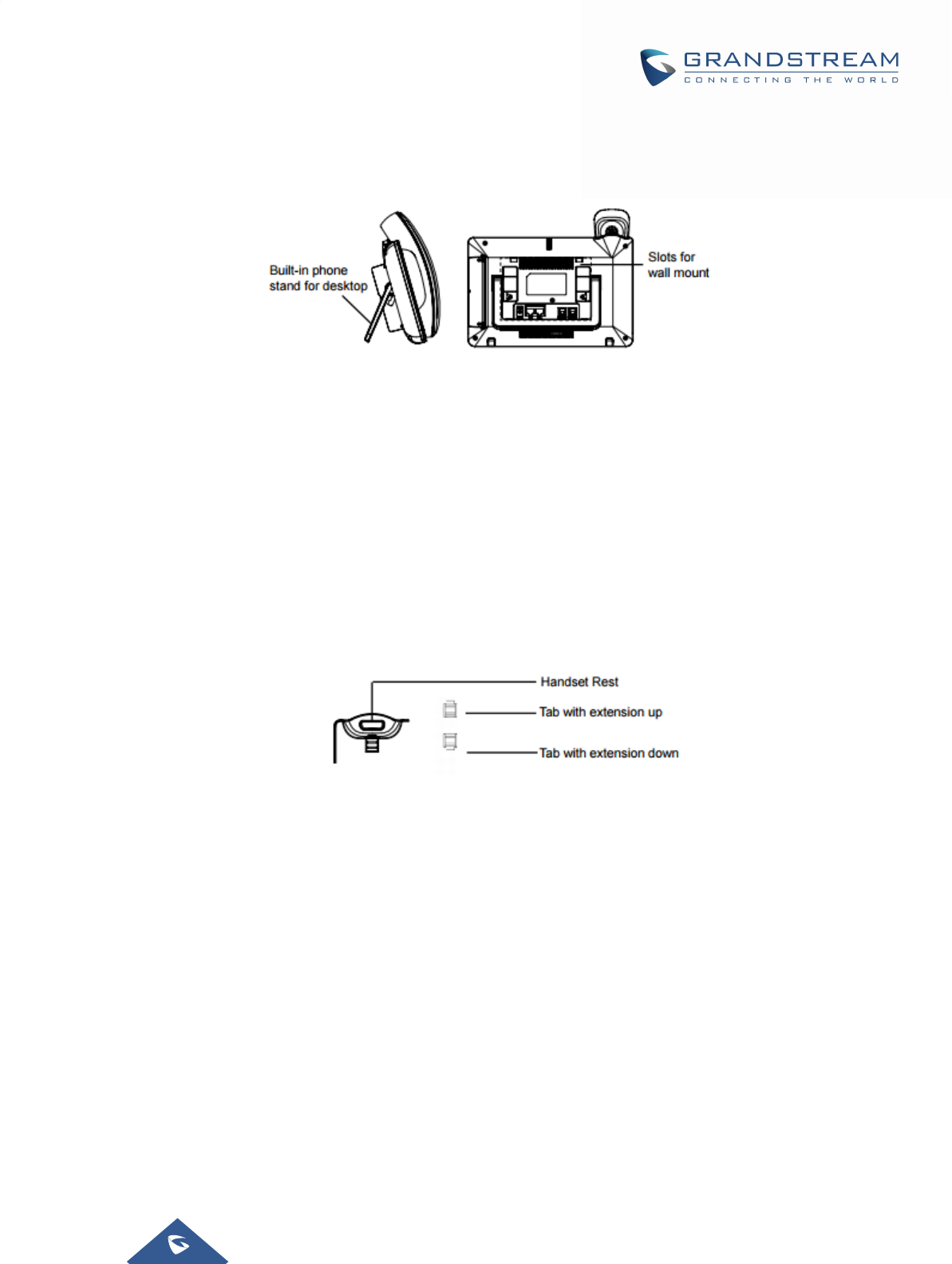
GXV3275 Administration Guide
Version 1.0.3.186
Page |22
GXV3275PhoneSetup
The GXV3275 can be installed on the desktop using the built-in stand or attached on the wall using the
slots for wall mounting.
Figure 2: Built In Stand And Mounting Slots On The GXV3275.
UsingthePhoneStand
The GXV3275 has a built-in phone stand. To use it, pull out the phone stand handle on the back of the
phone. Adjust the angle as preferred and make sure the phone stands still on the desktop
UsingtheSlotsforWallMounting
1. Attach the wall mount to the slots on the back of the phone;
2. Attach the phone to the wall via the wall mount hole;
3. Pull out the tab from the handset cradle (see figure below);
4. Rotate the tab and plug it back into the slot with the extension up to hold the handset while the
phone is mounted on the wall.
Figure 3: Tab on the Handset Cradle
ConnectingtheGXV3275
To setup your GXV3275, please follow the steps below:
1. Connect the handset and main phone case with the phone cord;
2. Connect the LAN port of the phone to the RJ-45 socket of a hub/switch or a router (LAN side of the
router) using the Ethernet cable;
3. Connect the 12V DC output plug to the power jack on the phone; plug the power adapter into an
electrical outlet. If PoE switch is used in step 2, this step could be skipped;
4. The LCD will display booting up or firmware upgrading information. Before continuing, please wait
for the main screen display to show up;
5. Using the web configuration interface or from the menu of the touch screen, you can further
configure network connection using static IP, DHCP and etc.

GXV3275 Administration Guide
Version 1.0.3.186
Page |23
Figure 4: GXV 3275 Back / Side View
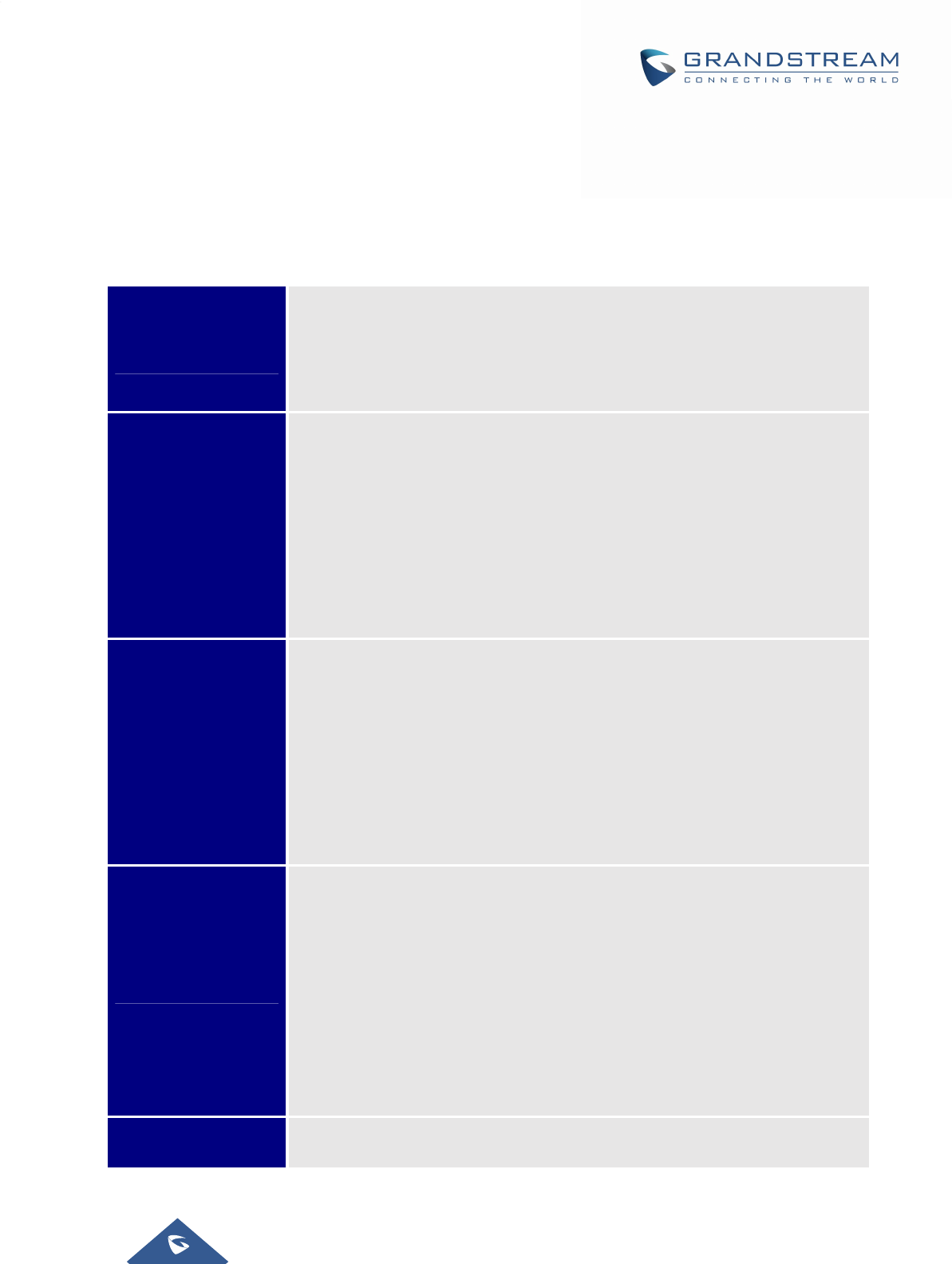
GXV3275 Administration Guide
Version 1.0.3.186
Page |24
GXV3275LCDSETTINGS
The GXV3275 LCD MENU provides an easy access to the settings on the phone. Some of the settings
from Web GUI could be configured via the LCD as well.The following table shows the LCD setting menu
options.
Table 4: GXV3275 LCD Settings
Personalized
Account
Ringtone
Auto-Answer
Shared call appearance (SCA)
Call forwarding
Full-screen video calling ON/OFF
Wireless & Network
Ethernet settings
Wi-Fi ON/OFF
Wi-Fi settings
Bluetooth ON/OFF
Bluetooth settings (available when Bluetooth is turned on)
VPN
Proxy settings
Additional network settings
Tethering & portable hotspot
Sound
General
Silent mode ON/OFF
HDMI ON/OFF
Line Order
Volumes
Incoming Calls
Ringtone
Notifications
Notification tone
Display
Brightness
Screen timeout
Screensaver timeout
Daydream
Font size
Landscape screen
HDMI control
HDMI output format
HDMI color mode
HDMI display settings
Storage
Display storage status for internal storage, SD card and USB flash drive
devices plugged into the phone
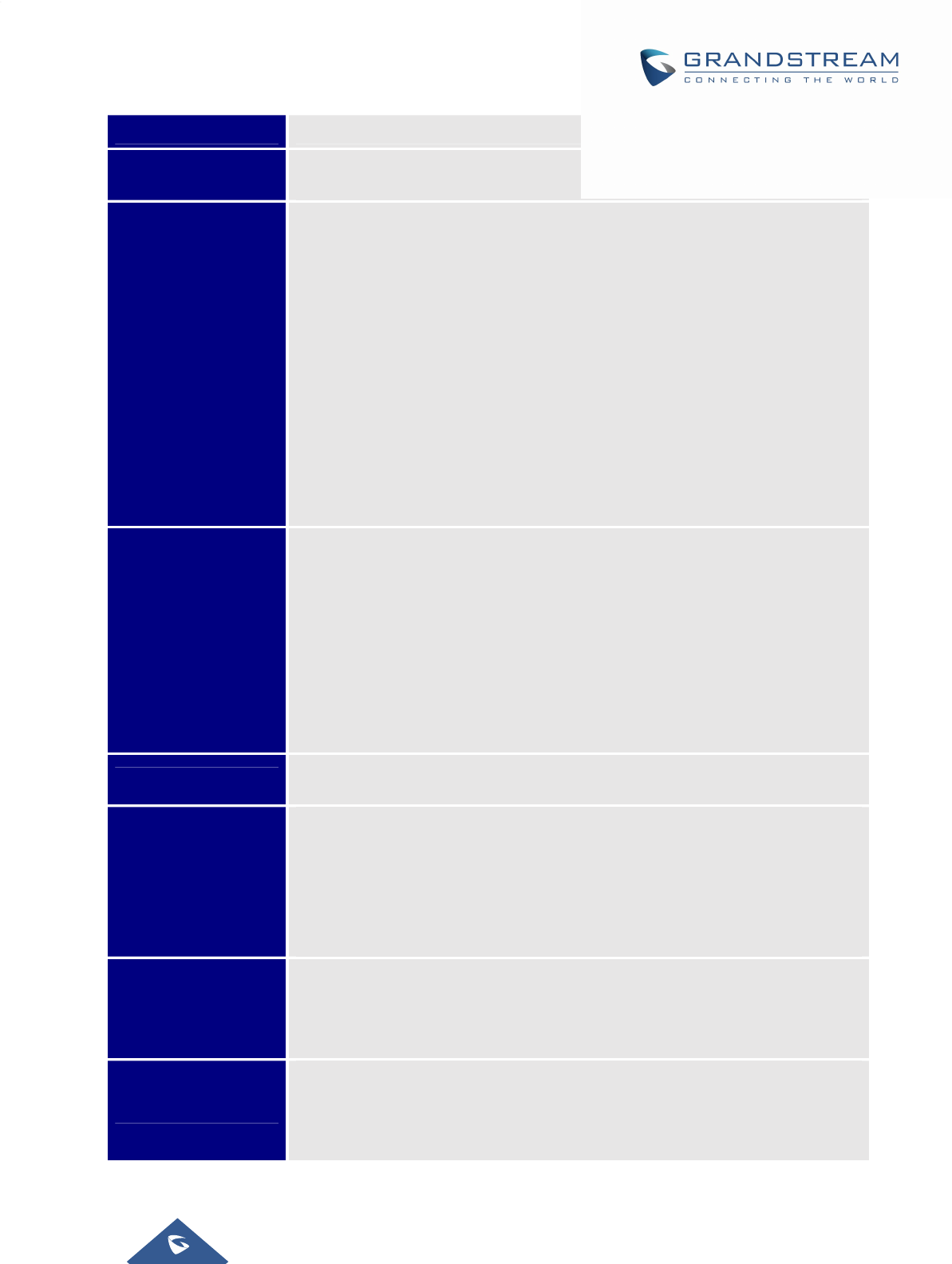
GXV3275 Administration Guide
Version 1.0.3.186
Page |25
Applications Manage applications installed on the phone
Location Access
Access to my location ON/OFF
Wi-Fi & mobile network location
Security Settings
Screen security
Screen Lock
Owner info
Passwords
Make passwords visible
Device administration
Device administrators
Unknown sources
Verify apps
Credential storage
Trusted credentials
Install from SD card
Clear credentials
Language &
Keyboard
Language
Spell checker
Personal dictionary
Keyboard & input methods
Default
Speech
Text-to-speech output
Mouse/Track pad
Pointer speed
Accounts
Add account to the phone to sync up contacts and Google Calendar, sign in
Google Play (if installed), sign in Email and etc
Date & Time
Enable and use specified NTP server address
Set date
Set time
Set time zone
Use 24-hour format
Choose date format
About Phone
Display phone's status. No configuration is necessary here
Account status
Network status
System info
Advanced Settings
Account. Configure SIP account registration information
Upgrade
Syslog
Factory Reset
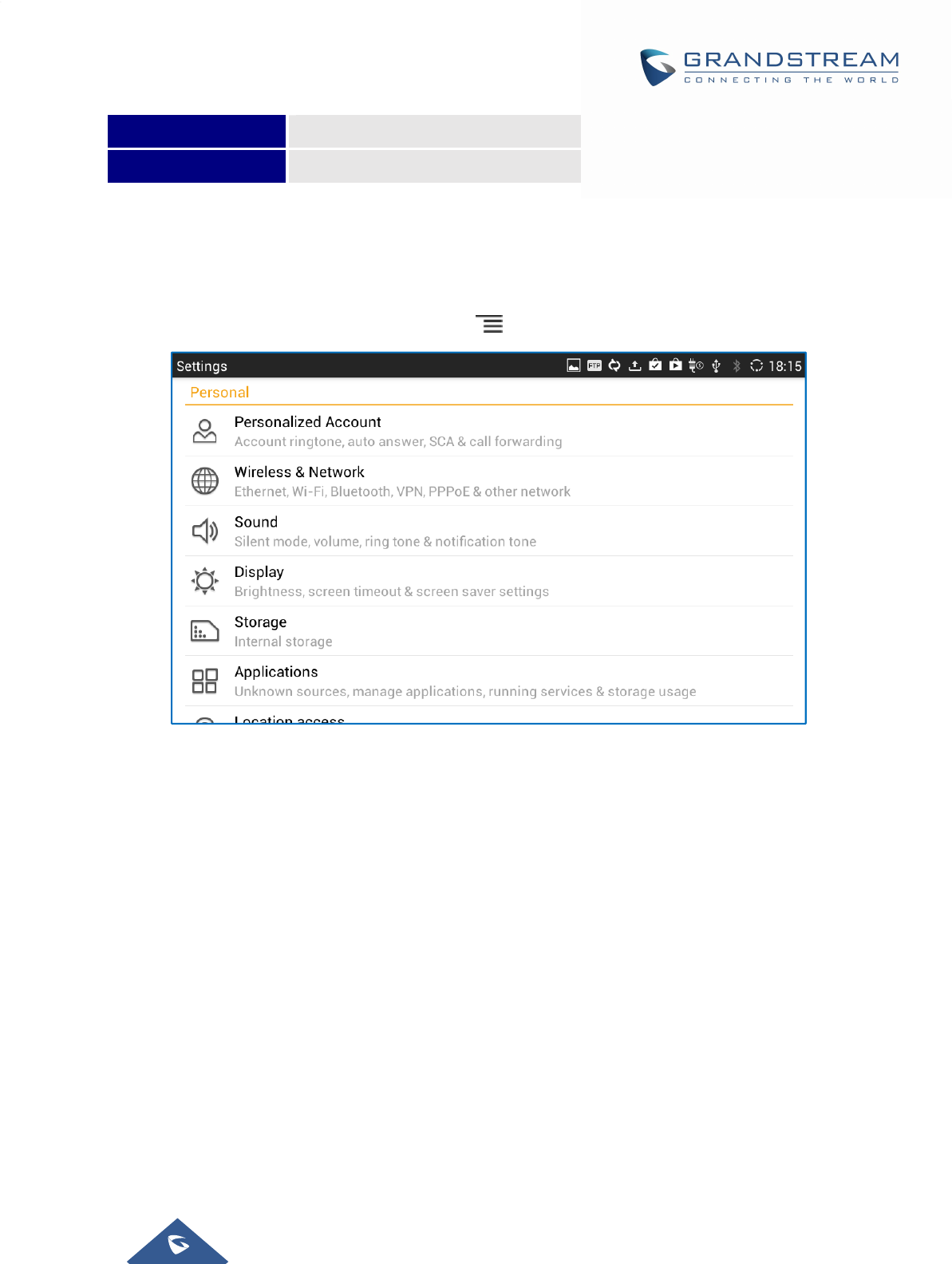
GXV3275 Administration Guide
Version 1.0.3.186
Page |26
Developer mode
Reboot Reboot the phone
AccessLCDSettings
To open the settings menu, you should:
Access to the LCD screen menu and then tap on Settings;
Or
On GXV3275 idle screen, press MENU button and then tap on System settings.
Figure 5: GXV3275 System Settings
PersonalizedAccount
In this menu, all the six SIP accounts will show up with registration status displayed. Tap to select the SIP
account to configure ring tone, auto answer, shared call appearance and call forwarding settings.
Ringtone
Select ring tone for the incoming call to this SIP account. If "Custom Ringtone" is selected, File
Manager will be opened for users to choose their own music file to be configured as the incoming call
ring tone. Users will see the music file name as the ring tone name in account ring tone settings in LCD
as well as in web GUI.
Auto-Answer
- If set to "Always",the phone will automatically turn on the speaker phone to answer all incoming
calls.
- If set to "Enable Intercom/Paging", the phone will answer the call based on the SIP info header
sent from the server/proxy.
- By default, it's turned off.

GXV3275 Administration Guide
Version 1.0.3.186
Page |27
Shared Call Appearance (SCA)
- Shared Call Appearance (SCA):Enable or disable SCA on the account.
- Enable Barge-in:If set to "Yes", the user could barge into an active call on a shared line.
- Auto Fill Call Park Code:If set to "Yes", the configured "Call Park Service Code" will be
automatically filled in on the phone's dial pad when picking up the parked call. This is used when
"Special Mode" is set to "BroadSoft" (from web UI or provisioning) and "Enable SCA" is set to
"Yes".
- Call Park Service Code: Configure the retrieving feature code for call parking. If "Auto Fill Call
Park Code" is set to "Yes", this call park service code will be automatically filled in on the phone's
dial pad when picking up the parked call. This is used when "Special Mode" is set to "BroadSoft"
(from web UI or provisioning) and "Enable SCA" is set to "Yes".
- Seize Line Timeout (s): Configure the time for the line can be seized (in seconds) when using
shared line. The default setting is 15 seconds. For Shared Call Appearance, phone will send a
SUBSCRIBE-request for the line-seize event package whenever a user attempts to take the
shared line off hook. “Line Seize Timeout” is the line-seize event expiration timer.
Call Forwarding
The incoming call to this SIP account can be forwarded to another account using different rules as
configured here.
- None:Call forwarding feature is disabled. This is the default setting.
- Unconditional: Forward all calls to a particular number.
- Time based: Set the time range and number to be forwarded to. In this time range, calls are
forwarded to the number specified in "In Time Forward To"; out of this time range, calls are
forwarded to the number specified in "Out Time Forward To".
- Others: When the phone is busy, calls are forwarded to the number specified in "Busy To"; when
incoming calls are not answered, the calls are forwarded to the number specified in "No Answer
To"; the waiting time for answering calls is specified in "No Answer Timeout (s)".Finally, when the
phone is set on DND mode the call will be forwarded to the number configured under the field
“DND To”.
Full screen video calling
Set to automatically enable the full screen video call mode for inbound and outbound video calls.
Wireless&Network
Users can configure Ethernet settings, Wi-Fi, Bluetooth, VPN, PPPoE and other advanced network
settings here.
EthernetSettings
Configure DHCP, Static IP or PPPoE to for the phone to access network via Ethernet settings.
If DHCP is selected, the phone will get an IP address automatically from the DHCP server in the
network. This is the default mode.
If Static IP is selected, manually enter the information for IP Address, Subnet Mask, Default Gateway,
DNS Server and Alternative DNS server.
If PPPoE is selected, type PPPoE Account ID and PPPoE Password provided from the PPPoE server

GXV3275 Administration Guide
Version 1.0.3.186
Page |28
to get authenticated for network access.
Wi‐FiSettings
Tap on "Wi-Fi" to turn on/off Wi-Fi connection. By default, it's turned off.
Tap on "Wi-Fi Settings" to set up and manage wireless access points. This option is available only
when Wi-Fi is turned on.
- WPS Push Button. Press MENU button and select "WPS Push Button" for an easy and
secure Wi-Fi network setup. Once selected, check your router and press the Wi-Fi Protected
Setup (WPS) button on the router so that the Wi-Fi connection and security can be automatically
set up between the phone and the router. The phone should get network connection shortly after
successfully setup.
- Add Network. If the Wi-Fi network SSID doesn't show up in the list, or users would like to set up
advanced options for the Wi-Fi network, press MENU button and select "Add Network". Then
Enter SSID, Security type, password and set up address type (DHCP/Static IP/PPPoE) in the
prompt dialog. The phone will reboot with Wi-Fi network connected.
- Scan. Press MENU button and select "Scan" to initiate scan for the Wi-Fi network within the
range.
- WPS Pin Entry. Press MENU button and select "WPS Pin Entry" for an easy and secure
Wi-Fi network setup. Once selected, a randomly generated PIN number will show on the phone for
you to enter it on your Wi-Fi router. The setup can take up to 2 minutes to complete and the phone
should get network connection once done.
- Wi-Fi Direct. This is to set up peer-to-peer connection between two Wi-Fi Direct devices so that
they can share data and sync files. Press MENU button button and select "Search for
devices". Then tap on the available peer device to initiate connection.
- Advanced Settings. Press MENU button and select "Advanced".
o Network notification: If enabled, the phone will show notification on the top status bar
indicating an open network is available. By default it's enabled.
o Avoid poor connections: If enabled, Wi-Fi network won't be used unless the connection
is good. By default it's disabled.
o MAC address: This shows the MAC address of the phone.
o IP address: This shows the IP address of the phone from Wi-Fi network.
For more information about how to use Wi-Fi on the GXV3275, please refer to the following link:
http://www.grandstream.com/sites/default/files/Resources/gxv3275_wifi_guide_0.pdf
BluetoothSettings
Tap on "Bluetooth" to turn on/off Bluetooth connection. By default, it's turned off.
Tap on "Bluetooth Settings" to set up and manage Bluetooth connections. This option is available
only when Bluetooth is turned on.
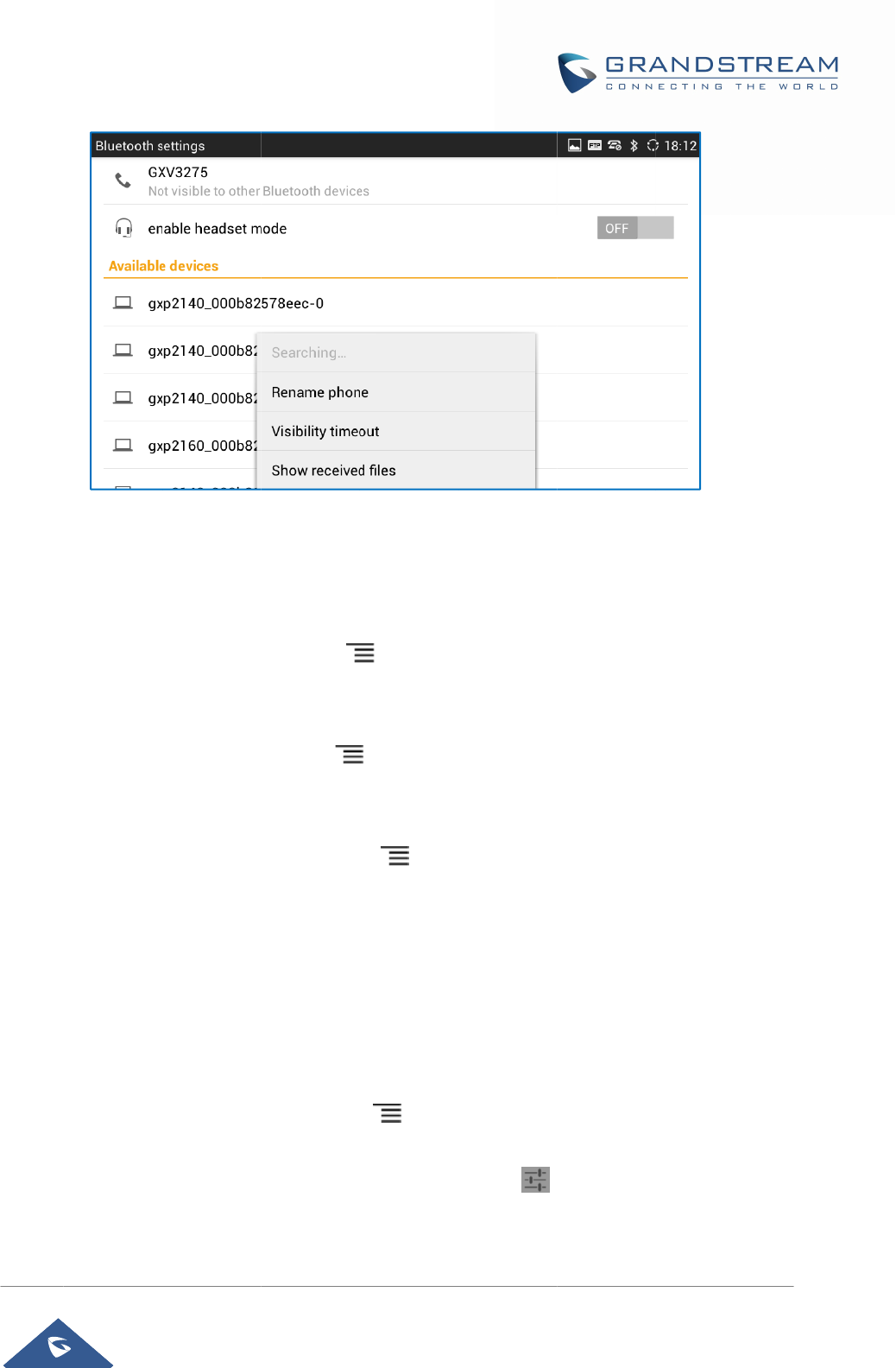
-
V
is
via
de
v
-
V
is
int
e
mi
n
- Re
n
GX
V
"G
X
- Se
a
pro
c
- En
a
ph
o
call
sh
o
- Pai
- Sh
o
file
- Pai
Blu
e
Ple
a
ibility. Tap o
Bluetooth. N
o
v
ices can dis
c
ibility timeo
u
e
rval among
"
n
utes.
n
ame phone
V
3275, whi
c
X
V3275" as s
a
rch for de
v
c
ess on the
G
a
ble headse
t
o
ne call to th
e
s on the mo
b
o
w as one lin
e
ring. Tap on
o
w received
transfer hist
o
red device
s
e
tooth devic
e
a
se note "He
a
n "GXV3275
"
o
rmally you
w
c
over the GX
V
u
t. Press ME
"
2 minutes",
"
. Press MEN
c
h is displa
y
hown on the
t
v
ices. Press
G
XV3275 to
d
t
mode. Whe
e
GXV3275
s
b
ile devices.
T
e
in the dial s
c
the Bluetoot
h
files. Press
o
ry and acces
s
ettings. If t
h
e
name to
a
a
dset audio"
GXV3275
A
Ver
s
Figure 6: GX
V
"
on the top
o
w
ould need t
o
V
3275.
NU button
"
5 minutes",
U button
y
ed on othe
r
t
op of the Bl
u
MENU butt
o
d
iscover the
B
n it's turned
o
s
o that users
T
he Bluetoot
h
c
reen for use
h
device nam
e
MENU butto
n
s received fil
e
h
e device is
a
ccess settin
g
can be turne
d
A
dministratio
n
s
ion 1.0.3.18
6
V
3275 Bluetoot
h
o
f the above
s
o
turn it on d
u
and selec
t
"1 hour" or "
and select
"
r
Bluetooth
d
u
etooth settin
g
o
n and
s
B
luetooth dev
o
n, the conne
c
can talk usi
n
h
Handsfree
p
rs to make c
a
e
in the scan
n
and s
e
e
s.
paired, tap
o
g
s including
d
on only if "
E
n
Guide
6
h
Settings
s
creen to swi
t
u
ring pairing
t
"Visibility ti
m
never". By d
e
"
Rename ph
o
d
evices wh
e
g
s screen.
s
elect "Sear
c
ices within th
e
c
ted mobile
d
n
g the GXV3
2
p
rofile for th
e
a
ll using the
G
result to pair
e
lect "Show
r
o
n icon
"Rename",
"
E
nable heads
t
ch visibility
s
process so t
h
m
eout". Tap t
o
e
fault, the vi
s
o
ne" to chan
g
e
n discovere
d
c
h for devic
e
e
range.
d
evices via Bl
2
75 handset
/
e
mobile pho
n
G
XV3275.
and connect
r
eceived files
"
on the right
"
Unpair" and
et mode" is s
Pa
g
s
tatus of the
p
h
at other Blu
e
o
select the ti
m
s
ibility timeo
u
g
e the name
d
. By defau
l
e
s" to initiate
uetooth can
s
/
speaker for
p
n
e number wi
to the devic
e
"
to view Blu
e
side of the
p
"Headset a
et to Yes.
g
e |29
p
hone
e
tooth
m
eout
u
t is 2
of the
l
t, it's
scan
s
witch
p
hone
ll also
e
.
e
tooth
p
aired
udio".
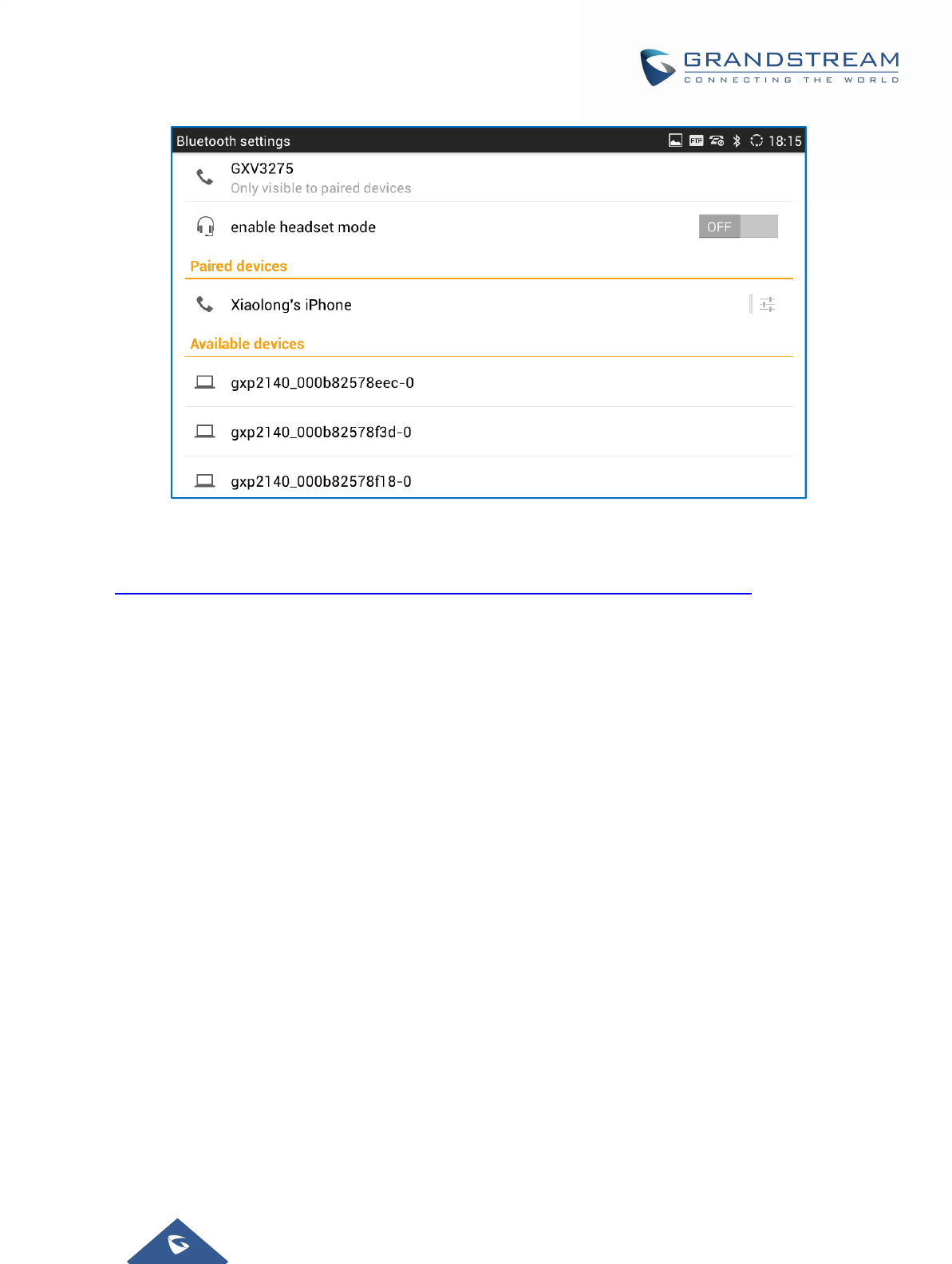
GXV3275 Administration Guide
Version 1.0.3.186
Page |30
Figure 7: GXV3275 Bluetooth Paired Device Settings
For more information about Bluetooth feature on the GXV3275, please refer to the following link:
http://www.grandstream.com/sites/default/files/Resources/gxv3275_bluetooth_guide_1.pdf
VPN
1. Tap on "Add VPN profile" to set up VPN connection.
The supported VPN type are "PPTP", "L2TP/IPSec PSK", "L2TP/IPSec RSA", "IPSec Xauth PSK",
"IPSec Xauth RSA" and "IPSec Hybrid RSA".
2. Once added, the profile will be displayed in the VPN list.
3. Touch and press it for about 2 seconds until a dialog box shows up. Users can select to edit this VPN
profile or delete it.
ProxySettings
For some network setup, it is required to connect to the Internet via proxy server. Manually configure
"Proxy hostname", "Proxy port" and "Bypass proxy for" in proxy settings for the phone to get Internet
connection successfully.
AdditionalNetworkSettings
LLDP
Turn on/off LLDP on the GXV3275. If turned on, the phone will be able to discover the LAN polices as
set up in the switch side to obtain network settings such as VLAN tag, Layer 2 QoS 802.1p priority and
Layer 3 QoS in a plug-and-play manner.
Layer 3 QoS for SIP
This field defines the layer 3 QoS parameter for SIP packets.

GXV3275 Administration Guide
Version 1.0.3.186
Page |31
This is the value used for IP Precedence, Diff-Serv or MPLS. The Default value is 48.
Layer 3 QoS for Audio
This field defines the layer 3 QoS parameter for audio packets. This is the value used for IP
Precedence, Diff-Serv or MPLS. The Default value is 48.
Layer 3 QoS for Video
This field defines the layer 3 QoS parameter for video packets. This is the value used for IP
Precedence, Diff-Serv or MPLS. The Default value is 48.
Layer 2 QoS 802.1Q/VLAN Tag
This field contains the value used for layer 2 VLAN tagging. The Default value is 0.
Layer 2 QoS 802.1p/Priority Value
This assigns the priority value of the Layer2 QoS packets. The Default value is 0.
802.1x mode
This option allows the user to enable/disable 802.1x mode on the phone. The default setting is
disabled. To enable 802.1x mode, select the 802.1x mode, enter the Identity and MD5 Password to be
authenticated to the network.
802.1x Identity
This filed is for inputting the identity information for the 802.1x EAP-MD5 mode.
802.1xPassword
This field is for inputting the password for the 802.1x EAP-MD5 mode.
Tethering&PortableHotspot
The GXV3275 can be served as a Wi-Fi access point for other devices to connect to wireless network if
hotspot is turned on.
1. Turn on hotspot by tapping on "Portable Wi-Fi hotspot". Icon will show on the top status bar.
2. Tap on "Set up Wi-Fi hotspot" to configure network SSID, security type and password. Please make
sure the password has at least 8 characters. Otherwise, users won't be able to save the setting.
3. On the other device that needs Wi-Fi access, turn on Wi-Fi, look for the SSID of the GXV3275 hotspot
and enter authentication information to get connected.
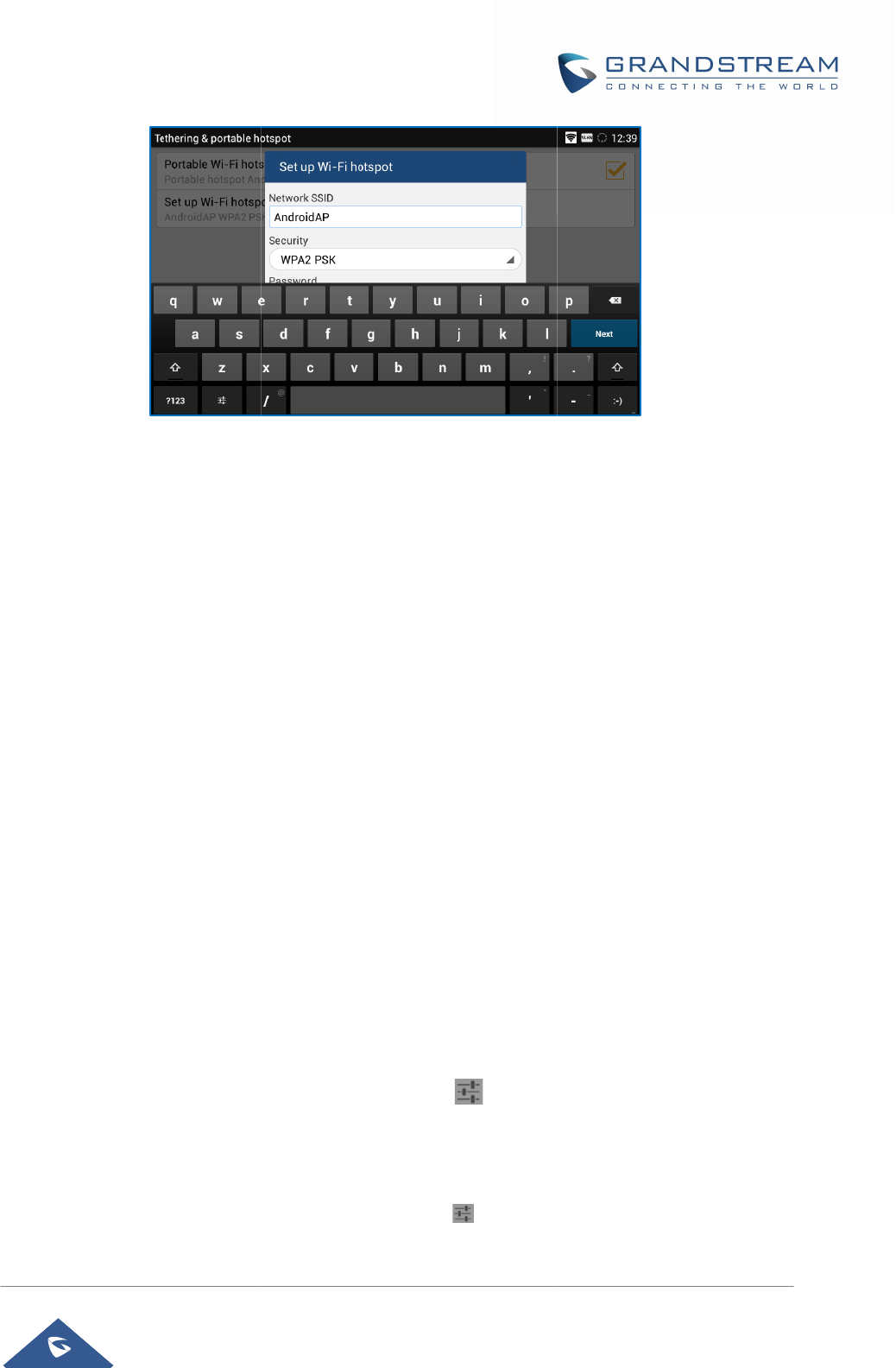
Sound
Use the
S
Silen
t
Touc
h
HDM
I
conn
e
spea
k
Line
o
the s
e
V
olu
m
Whe
n
Ring
t
Notif
i
Displa
y
Brig
h
Scre
e
Scre
e
Dayd
- Sc
r
im
a
- Cl
o
- Co
l
- Ph
o
ph
o
S
ound setting
s
t
mode. Tap
o
h
Sounds. T
a
I
. Tap on it to
e
cted. If it is
o
k
er, headset
o
o
rder. Tap o
n
e
lected optio
n
m
e. Tap on
V
n
adjusting th
e
t
one. Select
p
i
cation tone.
y
h
tness. Tap
o
e
n timeout.
T
e
nsaver tim
e
ream. Tap to
r
eensaver.
A
a
ge path and
a
o
ck. Display
a
l
ors. Display
o
to Frame.
A
o
to frame as
s
s
to configur
e
o
n it to turn
o
a
p on it to tur
n
switch the a
o
n, the audio
o
r other non-
H
n
it to select
3
n
is available
V
olume and
e
volume, th
e
p
hone's ringt
o
Select notifi
c
o
n Brightnes
s
T
ap to open t
h
e
out. Tap to
o
select the s
c
A
fter selectin
g
a
nimation int
e
a
nalog clock
a
color as scre
A
fter selectin
g
s
creen saver.
GXV3275
A
Ver
s
Figure 8: G
X
e
phone's so
u
o
n/off the sou
n
n
on/off the t
o
udio output
b
will be outp
u
H
DMI audio
c
3
.5mm earph
if the 3.5mm
scroll left/rig
h
e
tone will be
o
ne for inco
m
c
ation rington
s
and scroll l
e
h
e dialog to s
e
o
pen thedialo
g
c
reensaver o
n
g
"Screensa
v
e
rvals for scr
e
a
s screen sa
v
en saver.
g
"Photo Fra
m
A
dministratio
n
s
ion 1.0.3.18
6
X
V3275 Wi-Fi
H
u
nd mode, vo
l
n
d from spea
o
uch screen
s
b
etween the
H
u
t via the re
m
c
hannels.
one line ord
e
earphone is
p
h
t to adjust
t
played reflec
t
m
ing call.
e.
e
ft/right to ad
j
e
t the screen
g
to set the s
c
n
the phone.
v
er", tap on
e
en saver di
s
v
er.
m
e", tap on
n
Guide
6
H
otspot
l
ume, ring to
n
ker when the
s
ound.
H
DMI and lo
c
m
ote HDMI d
e
e
r "CTIA" or "
O
p
lugged in.
t
he volume f
o
t
ing the volu
m
j
ust the LCD
b
timeout inte
r
c
reensaver ti
m
to confi
g
s
play.
to select l
n
e and notific
a
re is an inco
m
c
al channels
w
e
vice. Or it wi
O
MTP". Audi
o
r Ringtone,
m
e change.
b
rightness.
r
val.
m
eout interv
a
g
ure network
ocal pictures
Pa
g
a
tion tone.
m
ing call.
w
hen HDMI
d
ll output fro
m
o loopback t
e
Media and
A
a
l.
image path,
to be displa
y
g
e |32
d
evice
m
local
e
st for
A
larm.
local
y
ed in
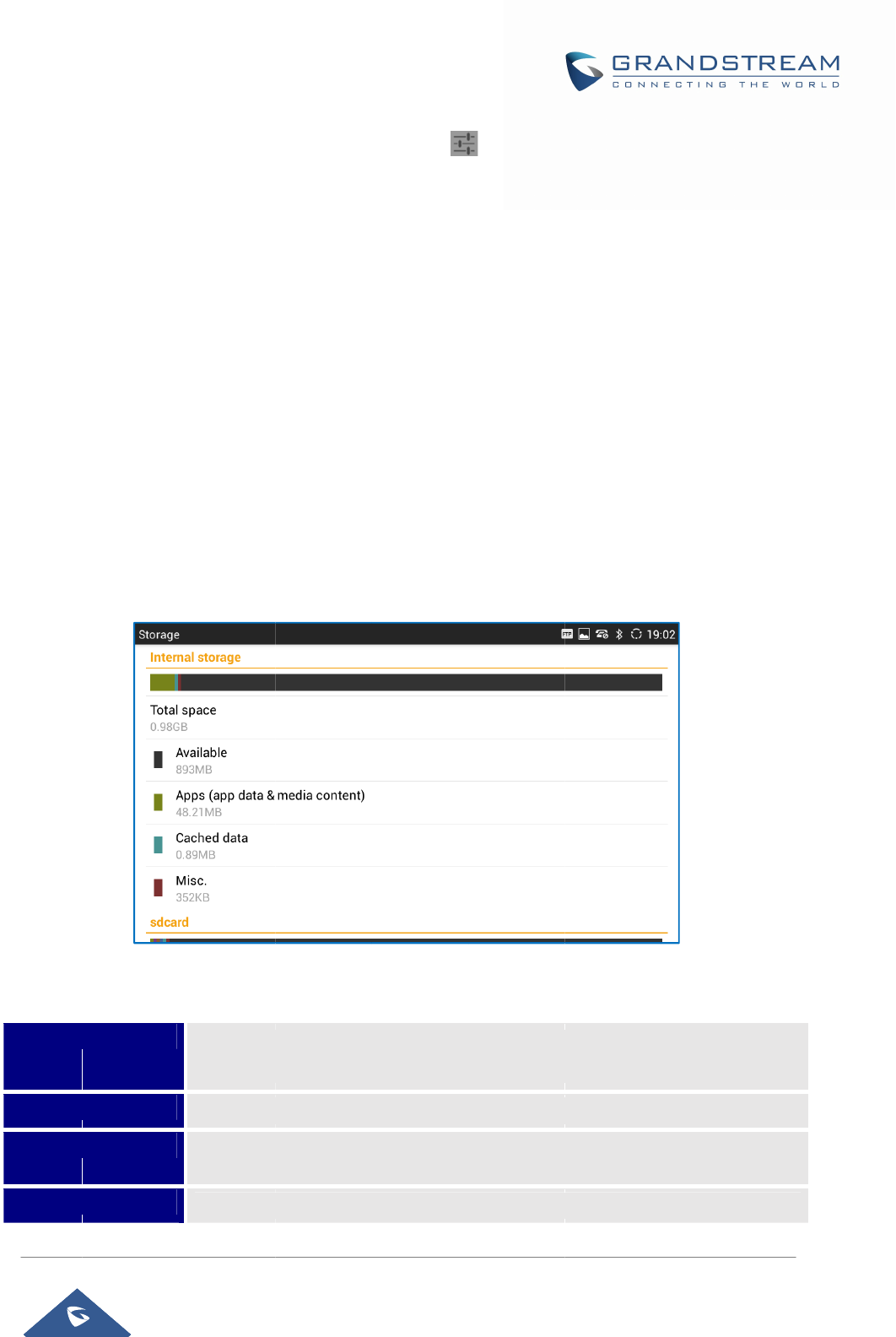
- Ph
o
ph
o
Font
Land
s
optio
n
scree
HDM
I
“Clos
e
sync
h
be s
a
displ
a
size
m
Storag
e
The stora
categorie
s
Apps
Cached
d
Misc.
Picture,
v
o
to Table. A
f
o
to table as s
c
size. Tap on
s
cape scree
n
is usually u
s
n. If it is ena
b
I
control. Ta
p
e
HDMI out
p
h
ronization w
i
a
me as the lo
a
y the same
p
m
ode during
a
e
ge status for
s
. Users can
d
ata
v
ideos
f
ter selecting
c
reen saver.
it to adjust th
e
n. Tap on th
e
s
ed when the
b
led, it may c
a
p
on it to en
a
p
ut” is sele
c
i
th LCD” is s
e
cal LCD dis
p
p
icture with t
h
a
video call.
phone's inte
r
tap on the c
a
Tab
l
Tap on it t
o
tap on the
a
Tap on it t
o
Tap on it t
o
select the
f
Tap on it t
o
GXV3275
A
Ver
s
"Photo Tabl
e
e
font size fo
r
e
checkbox to
3rd party ap
p
a
use some a
p
a
ble and sele
c
ted, the HD
e
lected, the
p
p
lay. If “Show
h
e phone’s L
C
r
nal and exte
r
a
tegory to ma
n
Figure 9
l
e 5: GXV3275
S
o
access runn
a
pp to stop t
h
o
clear cache
d
o
open the fil
f
olders to be
c
o
open album
s
A
dministratio
n
s
ion 1.0.3.18
6
e
", tap on
r
LCD scree
n
enable/disa
b
p
lication disp
l
p
ps disabled.
ct HDMI out
p
MI output f
e
p
ictures displ
a
remote scre
e
C
D screen un
r
nal storage
d
n
age the cor
r
: GXV3275 Sto
r
S
torage Catego
r
ing apps, do
w
h
e process.
d
data for all
a
e system of
t
c
leaned up.
s
in Gallery.
n
Guide
6
to select l
o
n
.
b
le landscap
e
l
ays verticall
y
p
ut content
w
e
ature will b
e
a
yed on the
r
e
n” is select
e
less displayi
n
d
evices is so
r
r
esponding d
a
r
age
r
y and Actions
w
nloaded ap
p
a
pps.
t
he storage i
n
o
cal pictures
e
display on a
l
y
when runni
n
w
hen HDMI d
e
e
turned off.
r
emote HDMI
e
d, the remot
e
n
g the remot
e
r
ted and disp
l
a
ta (see tabl
e
p
s, all apps a
n
n
FileManag
e
Pa
g
to be displa
y
l
l the screen
s
n
g on the GX
V
e
vice connec
t
If “HDMI d
device will a
e
HDMI devi
c
e
side’s video
l
ayed with di
ff
e
below).
n
d etc. Users
e
r. Users ca
n
g
e |33
y
ed in
s
. This
V
3275
t
ed. If
isplay
lways
c
e will
in full
ff
erent
could
n
then
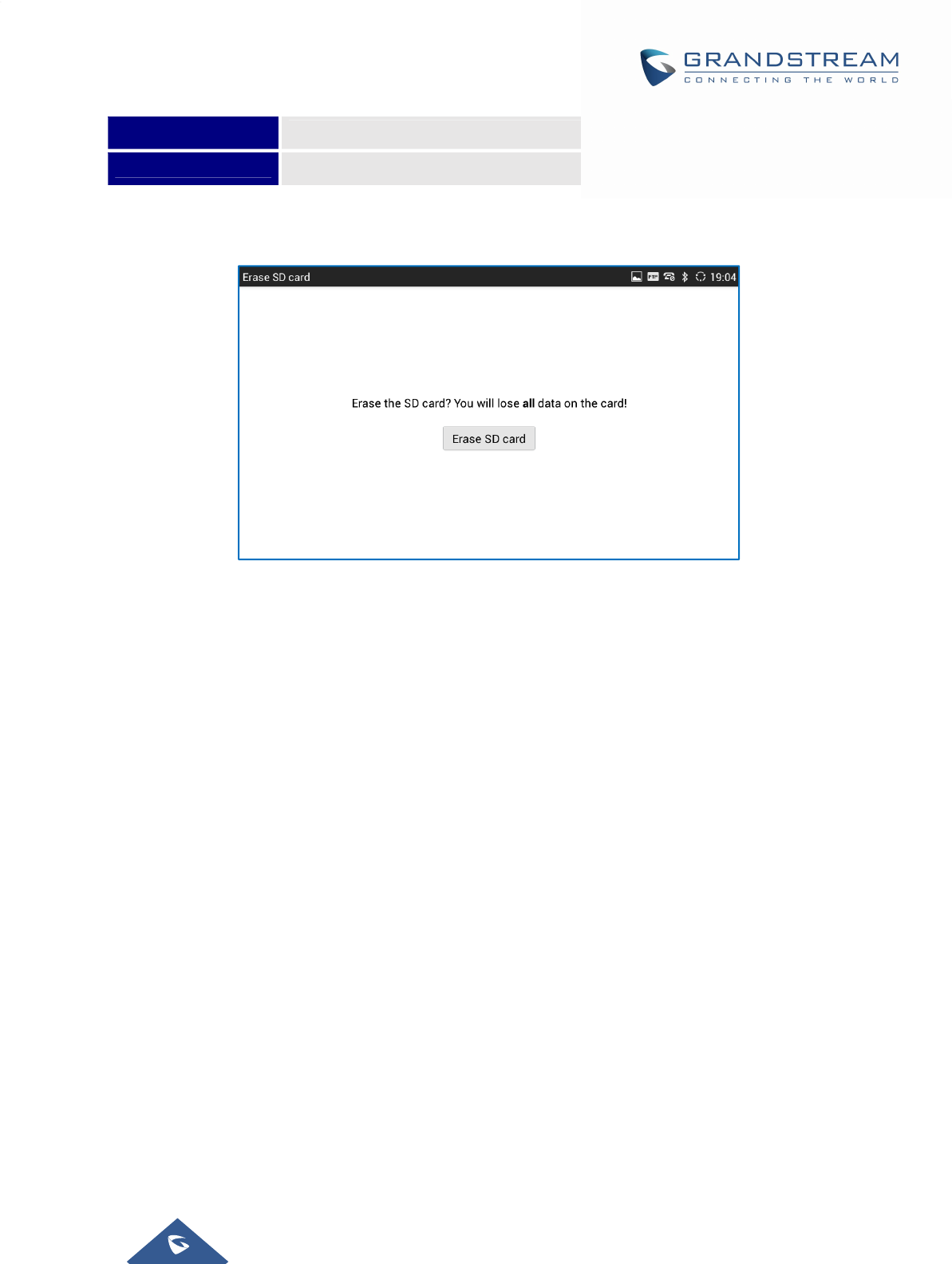
GXV3275 Administration Guide
Version 1.0.3.186
Page |34
Audio Tap on it to open the audio file using Music app or FileManager.
Downloads Tap on it to open download history.
Users can tap on "Erase SD card" to remove all the pictures, video and files from the SD card in the
phone's storage.
Figure 10: Erase SD Card
Applications
ViewApplications
Users can view the details and manage the applications installed on the GXV3275. There are four tabs,
with lists of applications and their components in each tab. At the bottom of each tab is the memory usage
information for the selected tab. The four tabs are:
Downloaded: To view the applications you’ve downloaded from GS Market or other sources.
On SD Card: To view the applications on the SD card of the phone's storage.
Running: To view the running or cached applications.
All: To view all the applications installed on the GXV3275.
User can swipe left/right on the screen to switch among the tabs.
ManageApplications
Tap on an application, process or service to open it. The Application Info screen for each application lists
its name, version, size, etc. Depending on the app, it may also include options for managing the
application's data, forcing the application to stop, and disabling the application. Usually the options are:
Tap the "Force stop" softkey to stop an application forcefully. This setting might valid for some
applications.
Tap the “Stop” softkey to stop an application gracefully. This setting might valid for some applications.
Tap the "Disable" softkey to disable the application. Users could tap on "Enable" to turn it back on
again. This usually applies to the built-in applications.

GXV3275 Administration Guide
Version 1.0.3.186
Page |35
Tap the "Uninstall" softkey to uninstall the applications from GS Market or other 3rd party source.
Storage provides storage information that an application uses on the phone.
Tap "Clear data" to delete an application setting and other data. This setting might valid for some
applications.
If the application stores data in a temporary space of the phone's memory, "Cache" lists how much
information is stored. Tap on "Clear cache" to clear the cache.
"Launch by default". If the application is configured to launch certain file type by default, tap on "Clear
defaults" to reset this.
"Permissions" lists information of the data that the app has access to. For example, the application
might access the location information, storage, phone calls and etc.
If an application is misbehaving, tap on "Report" softkey (if available) to send the developer
information for the application.
Note:
Stopping abuilt-in application, operating system processes or services might disable one or more
dependent functions on the phone. Users may need restart the phone to restore full functionality again.
SecuritySettings
ScreenSecurity
Screen lock. Set up pattern or password for screen lock. Wizard will be provided to set up the pattern.
The screen will be locked after booting up or the screen is off (i.e., screensaver screen activated, or
manually slide down Status BarSystem SettingsScreen Off to turn off LCD). Users will then
be required to enter password or pattern to login. When the screen is locked, users can still be able to
answer or reject incoming call.
Owner info. Display owner info on the lock screen. This can be useful if the device is lost.
Passwords
Make passwords visible. Check/uncheck to show/hide letters when user’s type screen lock
password instantly.
DeviceAdministration
Device administrators. View or deactivate device administrators.
Unknown sources. Check/uncheck to enable/disable permission to install applications that you
obtainfrom web sites, email, or other sources than GS Market and Google Play;
Verify apps. Disable or warn the users before installing the application.
CredentialsStorage
Trusted credentials. Display trusted CA certificates for system or user. Users can tap on the
certificate to check the credential details or disable it.
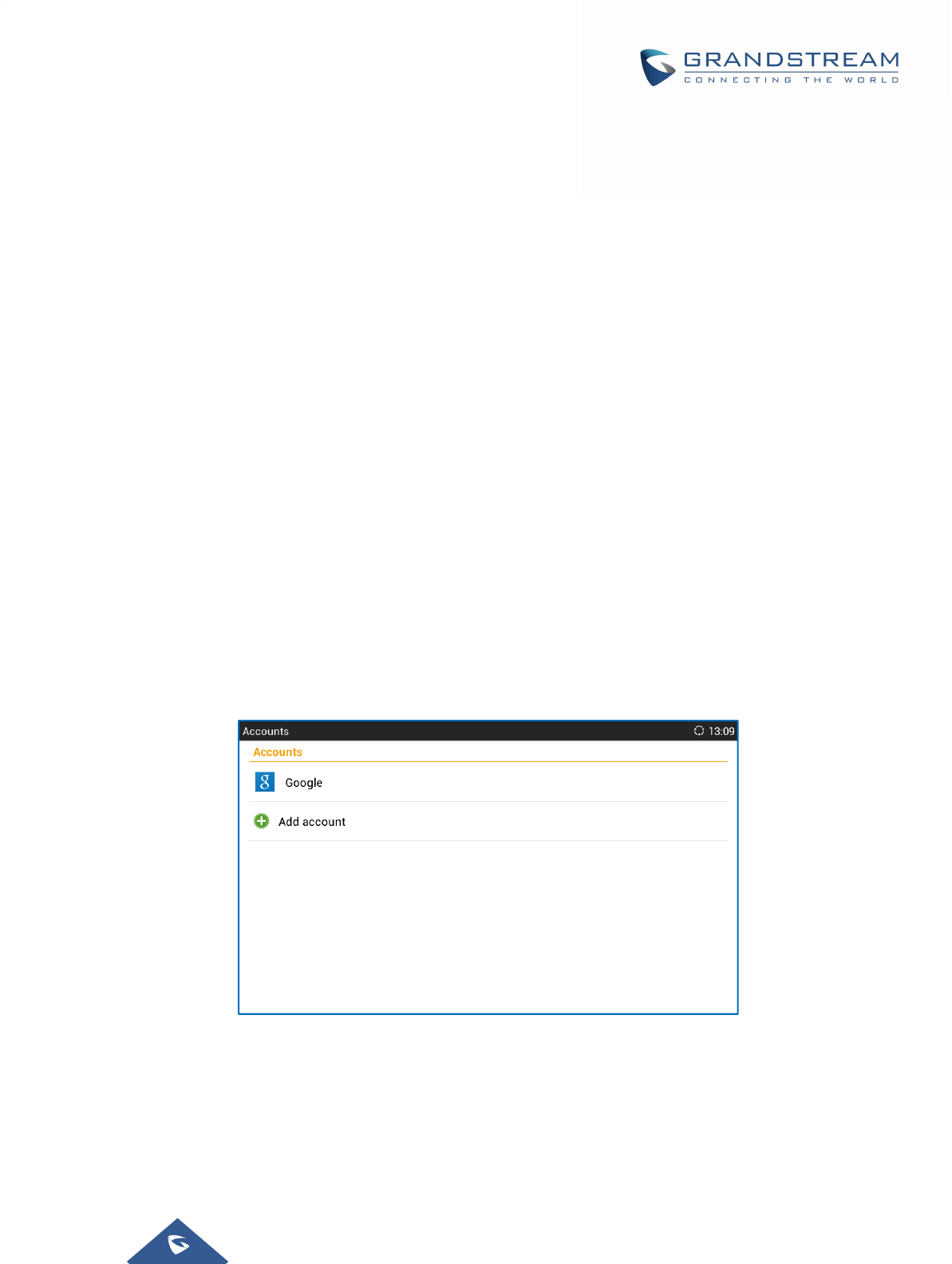
GXV3275 Administration Guide
Version 1.0.3.186
Page |36
Install from SD card. Install encrypted certificates from SD card;
Clear credentials. Clear credential storage of all contents and reset its password.
Language&Keyboard
Language. Tap to open a list of language options for the GXV3275 to display with.
Spell checker. Configure whether to check spellings and select the available spell-checker tool.
Personal dictionary. Add new words to user's dictionary so that they won't be displayed as error in
the text.
Keyboard & input methods. Set up default input method. The default input method is Android
Keyboard.
Default. Select input method
Android keyboard. Set up whether to use Android keyboard or not, and configure Android
keyboard including sound, auto-correction, word suggestion and so on.
Text-to-speech output. Set up and configure the text to speech settings.
Prefer engine. Select the engine type. The default engine is Pico TTS.
Speech rate. Adjust the speech rate.
Listen to an example. Play and listen the example of speech synthesis.
Pointer speed. Adjust the sensitivity of the mouse pointer in those devices.
Accounts
The GXV3275 allows users to add Google account, Email account and other 3rd party applications
account to the phone. Once the account is associated, the browser, calendar and contacts can be synced
up with the signed-in account on the GXV3275.
Figure 11: GXV3275 Accounts Sync Up Settings - Google Account Signed In
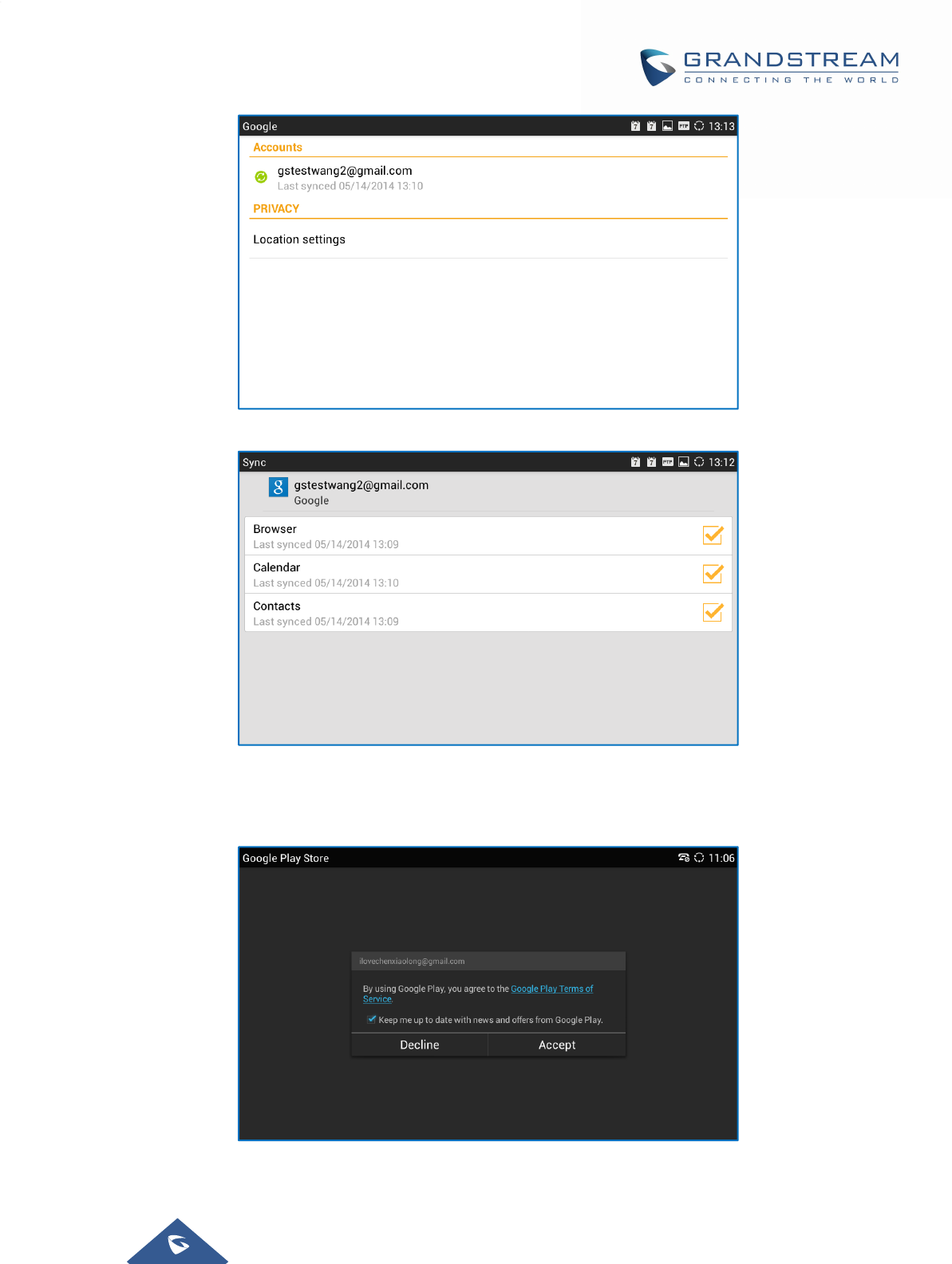
GXV3275 Administration Guide
Version 1.0.3.186
Page |37
Figure 12: GXV3275 Accounts Sync Up Settings - Google Account Synced Up
Figure 13: GXV3275 Accounts Sync up Settings - Select Browser, Calendar and Contacts
Additionally, if Google account is set up as the above figures show, users will be automatically signed in
after downloading Google Play from GS Market.
Figure 14: GXV3275 Google Play Account

GXV3275 Administration Guide
Version 1.0.3.186
Page |38
RegistertoFailoverSIPServer
The GXV3275 supports registration to failover SIP server, following steps need to be achieved in order to
make this configuration:
1. Configure Account 1, Account 2, etc.;with a SIP extension.
2. Under “Account XCallSettings” of each account, set the same “VirtualAccountGroup”, for
instance “VirtualAccountGroup 1”.
3. Navigate to “AdvancedSettingsCallFeatures” and check
“VirtualAccountGroupAvayaMode”.
4. Navigate to “AdvancedSettingsCallFeatures” and set
“VirtualAccountGroupConcurrenceRegister” to the same number as the virtual account, we set
it in our example to “1”.
5. Click on “Save” and “Apply” to apply the settings.
The phone will register to the first SIP server and only when the primary SIP server fail, the phone will send
the register request to the secondary SIP server.
Date&Time
Enable and use specified NTP server address. Assign the URL or IP Address of NTP Server.
Set date. Set the current date for the GXV3275.
Set time. Set the time on the GXV3275 manually.
Select time zone. Select time zonefor the GXV3275.
Use 24-hourformat. Check/uncheck to display the time using 24-hour time format or not. Forexample,
in 24-hour format, 13:00 will be displayed instead of 1:00 p.m.
Choose date format. Select the format of year, month and day for the date to be displayed.
AboutPhone
About phone lists the GXV3275's SIP account information, network status and system information.
Account status. Displays the account name and registration status on the GXV3275.
Network status. Displays MAC Address, Address Type, IP Address, Subnet Mask, Default Gateway,
DNS Server, Alternative DNS server, NAT Type and VPN IPif any.
System information. Displays the Android version, system version, recovery version, u-boot version,
kernel version, hardware version and CPE version of the GXV3275. The system version is the
firmware version for the GXV3275.
AdvancedSettings
Account
Configure SIP account's registration information. Tap on one account and fill in the necessary
information to register the account, which includes Account Active, Account Name, SIP Server, SIP
User ID, SIP Auth ID, SIP Auth Password, Voice Mail User ID and Display Name.
GXV3275 supports UCM Auto Config Number feature. This feature allows the Grandstream UCM,
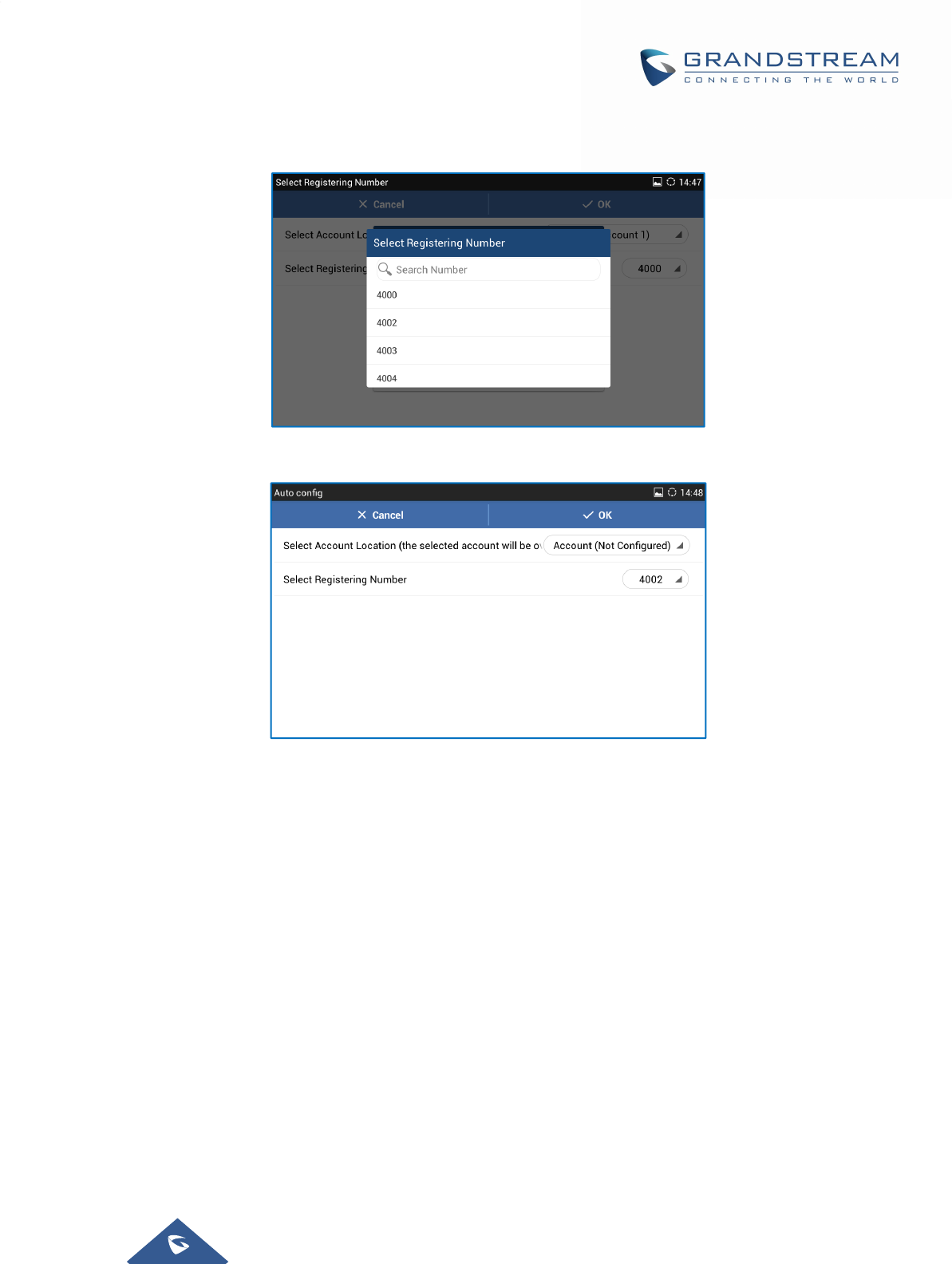
GXV3275 Administration Guide
Version 1.0.3.186
Page |39
located in the same network, automatically to assign accounts and to register them to GXV3275.
Figure 15: GXV3275 UCM Auto Config Number – Select Registering Numbers
Figure 16: GXV3275 UCM Auto Config Number – Enabling Registering Number
Upgrade
- Upgrade mode: This field allows the user to choose the firmware upgrade method:TFTP, HTTP
or HTTPS.
- Firmwareupgrade and provisioning. Defines the rules for automatic upgrade: Always Check at
bootup, when F/W pre/suffix changes, Skip the Firmware Check.
- HTTP/HTTPS user name.The user name for the HTTP/HTTPS server if set up on the server
side.
- HTTP/HTTS password.The password for the HTTP/HTTPS server if set up on the server side.
- Firmware server path.This defines the server path for the firmware server. It can be different
from the configuration server for provisioning.
- Config server path.This defines the server path for provisioning.It can be different from the
firmware server for upgrading.
Syslog
Syslog level

GXV3275 Administration Guide
Version 1.0.3.186
Page |40
Select the level of logging for syslog. The default setting is "None".There are 4 levels:DEBUG,
INFO, WARNING andERROR.
Syslog serveraddress
The URL/IP address for the syslog server. If the GXV3275 has network connection, the phone will
send the syslog packets to this server address.
Factory Reset. Open and tap on Factory Reset to restore the GXV3275 to factory default settings.
Developer mode.This mode can be used via ADB tool for advanced debugging purpose.
MulticastPaging
The GXV3275 supports the multicast paging which allows different SIP users to listen to a page from a
common multicast IP address.
Paging Barge
For the following we will assume that the option “Paging Priority Active” is not checked
- We suppose that we have 5 listening addresses filled on the GVX3275, from priority 1 to 5, and Paging
Barge is set to "2", only priority 1 and 2 multicasts will hold the call and play multicast. For the multicast
3/4/5 have no priority to "cover/override" the call.
- If Paging Barge is set to "Disable", no multicast can be prior to the call, which means the call is the highest
priority.
Paging Priority Active
- We suppose that we have 5 listening addresses filled on the GVX3275, from priority 1 to 5, and Paging
Priority Active is set to "Yes", low priority multicast will be "covered/overridden" by higher priority ones.
- For example, the GXV3275 is listening to a multicast from priority 2 address, only priority 1 multicast can
override the current multicast, but priority 3/4/5 multicast will be ignored.
- If we have 5 listening addresses filled in GXV3275, from priority 1 to 5, and Paging Priority Active is set to
"No", no new multicast can override the current one no matter what priority it has.
- For example, GXV3275 is listening to a multicast from address 4, priority 1/2/3/5 multicast will all be
ignored.
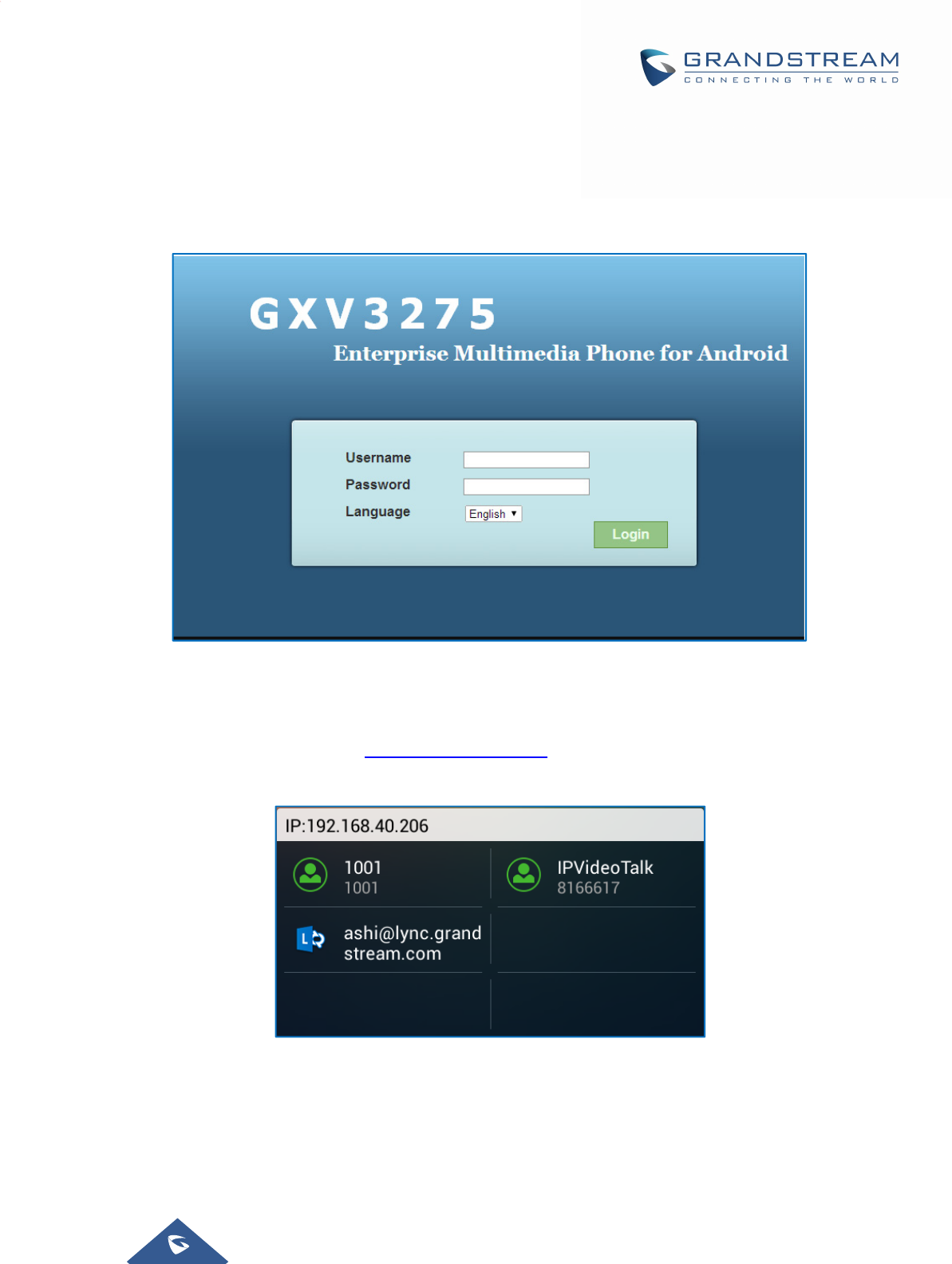
GXV3275 Administration Guide
Version 1.0.3.186
Page |41
GXV3275WEBGUISETTINGS
The GXV3275 embedded Web server responds to HTTP/HTTPS GET/POST requests. EmbeddedHTML
pages allowusersto configure the application phone through a Web browser such as Microsoft’s IE, Mozilla
Firefox, Google Chrome and etc.
Figure 17: GXV3275 Web GUI - Login
AccessGXV3275WebGUI
The GXV3275Web GUI URLishttp://Phone-IP-Address,where the Phone-IP-Addressis the IP
addressdisplayed on the GXV3275 desktop account widget.
Figure 18: GXV3275 Main Screen - IP Address
To access the GXV3275 Web GUI:
1. Connect the computer to the same network as the phone.
2. Make sure that the phone is turned on and shows its IP addresson the account widget of the desktop.

GXV3275 Administration Guide
Version 1.0.3.186
Page |42
3. Opena Web browser on your computer.
4. Enter the phone’s IP address in the address bar of the browser.
5. Enter the administrator’s login and password to access the Web Configuration Menu. The default login
name and password for the administrator is "admin" and"admin".The default loginname and password
for the end-user is "user" and "123".
Note:
Thecomputer has to be connected to the same sub-network as the phone. This can be easily done
byconnecting the computer to the same hub or switch as the phone connected to. In absence of a
hub/switch (or free ports on the hub/switch), please connect the computer directly to the PC port on the
back of the phone.
If the phone is properly connected to a working Internet connection, the phone will display its
IPaddress.This address has the format: xxx.xxx.xxx.xxx, where xxx stands for a number from 0-255.
Users will need this number to accessthe Web GUI. For example, if the phone shows 192.168.40.154,
please enter "http://192.168.40.154" in the address bar of the browser.
SavingChanges
When changing any settings on the web UI, always SUBMIT them by pressing the Save button on the
bottom of the page, and then clicking the Apply button on the top of the page to apply the configuration
changes. For those optionswith next to it in the Web page, users must reboot the phone for the
changes to take effect.
Definitions
This section describesthe options in the GXV3275 Web GUI. As mentioned,youcanlog in as an
administrator or an end user.
Status: Displays the Account Status,Network Status, and System Info of the phone.
Account (1-6): To configure each of the SIP accounts.
Advanced Settings: To configure GeneralSettings, Call Features, Video Settings, Tone Generator
and MPK Settings for MPK App.
Maintenance: To configure Network Settings,Wi-Fi Settings, Time Settings,Web/SSHAccess,
Upgrade, Syslog, Logcat, Debug, Language, TR-069, Contacts, Device Manager, etc.
The following table shows the web pages accessible by end user and administrator, respectively.
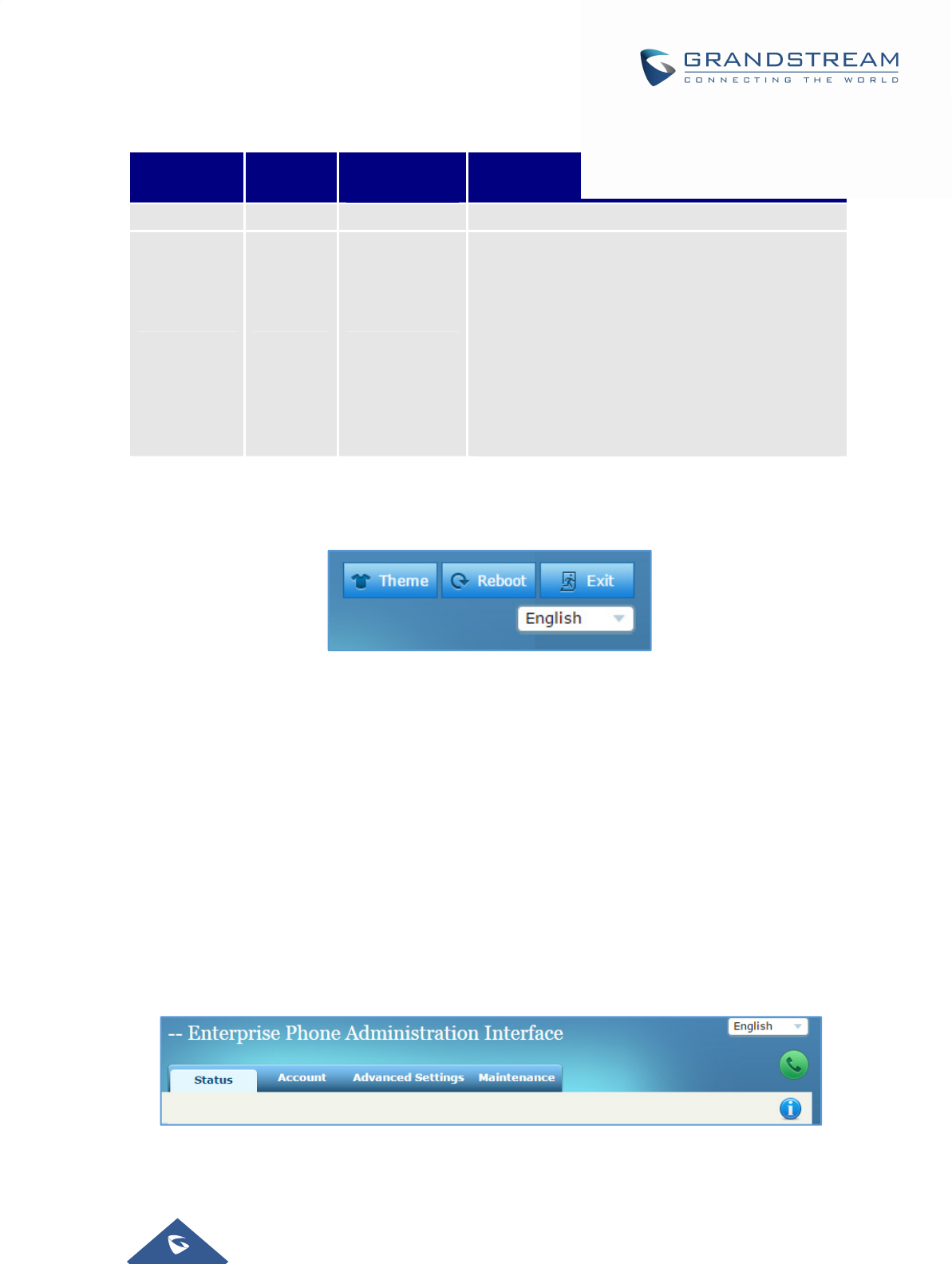
GXV3275 Administration Guide
Version 1.0.3.186
Page |43
Table 6: GXV3275 Web Access
User Type Username Default
Password Accessible Web Pages
Administrator admin admin All pages
End User user 123
Status: Account Status, Network Status,
System Info.
Advanced Settings: Tone Generator, MPK
General Settings, MPK LCD Settings, and MPK
EXT Settings.
Maintenance: Network Settings, Wi-Fi Settings,
Time Settings, Web/SSH Access, Logcat,
Debug, Language, Contacts, LDAP Book,
Broadsoft, Device Manager.
Toolbar
The web UI tool bar is on the upper right corner of the web UI page.
Figure 19: GXV3275 Web UI Tool Bar
Theme: Select the web UI style to display the web page.
Reboot: Reboot the phone.
Exit: Log out from the web UI.
English: Select the display language for the web UI.
Click‐To‐Dial
The GXV3275 allows users to manage their call using the Click to Dial feature which permits to initiate and
receive the call using the Web GUI. To user the Click to Dial feature, please refer the following steps:
1. Access the Web GUI using the administrator username and password (the default username /
password is: admin/admin).
2. Press the Click to Dial button to access the call menu as displayed on the following screenshot.
Figure 20: Click to Dial Feature
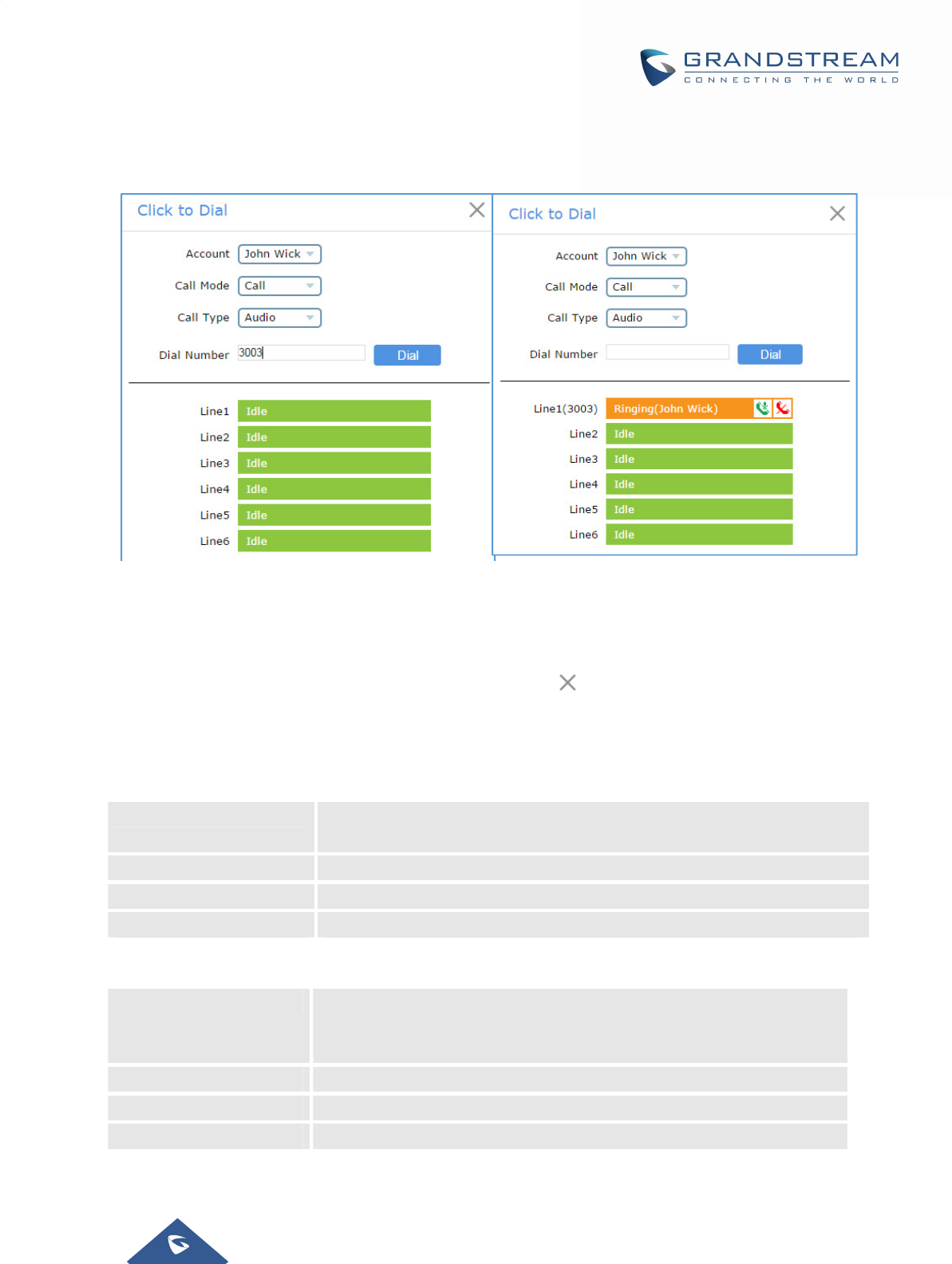
GXV3275 Administration Guide
Version 1.0.3.186
Page |44
3. Select the account to be used, call mode (call, paging or IP call), call type (audio or video).
4. Type the number to call under “Dial Number” field and press Dial button or answer an incoming
call by pressing on Answer / Reject buttons as displayed on the following screenshots:
Figure 21: Click to Dial Menu and Calls Status
Note:
- The Click to Dial menu display also the status of the ongoing calls with a detailed information
about the account such the name, account number, line used …
- To leave the Click to Dial menu press on exit button .
StatusPageDefinitions
Status/AccountStatus
Account 6 SIP accounts on the phone. By default, the 6th SIP account is the
IPVideoTalk account built-in with the phone.
Number SIP User ID for the account.
SIP Server URL or IP address, and port of the SIP server.
Status Registration status for the SIP account.
Status/NetworkStatus
MAC Address Global unique ID of device, in HEX format. The MAC address will be used
for provisioning and can be found on the label coming with original box
and on the label located on the back of the device.
NAT Type Type of NAT connection used by the phone.
Address Type Configured address type: DHCP, Static IP or PPPoE.
IPv4 Address IP address of the phone.

GXV3275 Administration Guide
Version 1.0.3.186
Page |45
Subnet Mask Subnet mask of the phone.
Default Gateway Default gateway of the phone.
DNS Server 1 DNS Server 1 of the phone.
DNS Server 2 DNS Server 2 of the phone.
IPv6 AddressType Configured address type: DHCP, Static IP or PPPoE.
IPv6 Address IPv6 address of the phone.
IPv6 DNS Server 1 IPv6 DNS Server 1 of the phone.
IPv6 DNS Server 2 IPv6 DNS Server 2 of the phone.
Status/SystemInfo
Product Model Product model of the phone.
Hardware Revision Hardware version number.
Part Number Product part number.
System Version Firmware version ID. This is the main software release version, which is
used to identify the software system of the phone.
Recovery Version Recovery image version.
Boot Version Booting code version.
Kernel Version The kernel version.
AndroidTM Version The AndroidTM OS version: 4.2.2.
TP Firmware Version Touch panel LCD screen firmware version
System Up Time System up time since the last reboot.

GXV3275 Administration Guide
Version 1.0.3.186
Page |46
AccountPageDefinitions
GXV3275has six lines that can be configured to accommodate6 independent SIP accounts. Each SIP
account has an individual configuration page.
Account/GeneralSettings
Account Active Indicates whether the account is active. The default value for the
IPVideoTalk account (Account 6) is "Yes" and the default value for the first
five accounts is "No".
Account Name Configures the name associated with each account to be displayed on the
LCD.
Note: the account name will be trimmed automatically to remove
whitespaces and tabulations at the begging and end of the string, for ex if
the account name set to “account1 “ it will be automatically corrected to
“account1”.
SIP Server Specifies the URL or IP address, and port of the SIP server. This should be
provided by VoIP service providers (ITSP).
SIP User ID Configuresuser account information provided by your VoIP service provider
(ITSP). It's usually in the form of digits similar to phone number or actually a
phone number.
SIP Authentication ID Configures the SIP service subscriber's Authenticate ID used for
authentication. It can be identical to or different from the SIP User ID.
SIP Authentication
Password
Configures the account password required for the phone to authenticate with
the ITSP (SIP) server before the account can be registered. After saving, it
will appear as hidden for security purpose.
Voice Mail Access
Number
Sets if the phone system allows users to access the voice messages by
pressing the MESSAGE key on the phone. This ID is usually the VM portal
access number. For example, in UCM6100 IPPBX, *97 could be used.
Name Specifies the SIP server subscriber's name (optional) that will be used for
Caller ID display. The configured content will be included in the From,
Contact and P-Preferred-Identity headers of SIP INVITE message.
Show Account Name
Only
Enables to display the account name; if it is checked, the user ID will be
hidden and the account name will be displayed only.
Tel URI Indicates E.164 number in “From” header by adding “User=Phone”
parameter or using “Tel:” in SIP packets, if the phone has an assigned PSTN
Number.
Disabled: Will use “SIP User ID” information in the Request-Line and
“From” header.
User=Phone:“User=Phone” parameter will be attached to the
Request-Line and “From” header in the SIP request to indicate the
E.164 number. If set to "Enable".

GXV3275 Administration Guide
Version 1.0.3.186
Page |47
Enabled: "Tel:" will be used instead of "sip:" in the SIP request.
Please consult your carrier before changing this parameter. Default is
“Disabled”.
Account/NetworkSettings
Outbound Proxy Configures the IP address or the domain name of the primary outbound
proxy, media gateway or session border controller. It's used by the phone for
firewall or NAT penetration in different network environments. If a symmetric
NAT is detected, STUN will not work and only an outbound proxy can
provide a solution
Secondary Outbound
Proxy
Sets IP address or domain name of the secondary outbound proxy, media
gateway or session border controller. The phone system will try to connect
the Secondary outbound proxy only if the primary outbound proxy fails.
DNS Mode Defines which DNS service will be used to lookup IP address for SIP
server’s hostname. There are three modes:
A Record
SRV
NATPTR/SRV
To locate the server by DNS SRV set this option to "SRV" or
"NATPTR/SRV". Default setting is "A Record".
DNS SRV Fail-over Mode The option will decide which IP is going to be used in sending subsequent
SIP packets (ex: Register refresh requests) after the list of IPs for SIP server
host is resolved with DNS SRV.
Default (prefer server with lowest SRV priority):
The phone will always prefer to send SIP requeststo the available server
having the lowest priority, and in case it’s down it contacts the next one, but
once the server having lowest priority is UP again, the phone will switch over
to this one.
Saved one until DNS TTL (Stay on responding IP until DNS timeout):
On this mode, the phone will resolve DNS SRV records and tries to send the
request to the server having lowest priority and if it doesn’t respond, it will
move on to the next IP until one of the servers responds, once this happen
the phone will keep contacting this responding IP until DNS timeout (30
minutes) before starting over.
Saved one until no response (Stay on responding IP until its failure):
On this mode, the phone will send SIP requests to the last responding IP,and
it doesn’t failover/switchover to the next one until this responding server is
down.

GXV3275 Administration Guide
Version 1.0.3.186
Page |48
NAT Traversal Specifies which NAT traversal mechanism will be enabled on the phone
system. It can be selected from the dropdown list:
NAT NO
STUN
Keep-alive
UPnP
Auto
VPN
If the outbound proxy is configured and used, it can be set to “NAT NO”.
If set to "STUN" and STUN server is configured, the phone system will
periodically send STUN message to the SUTN server to get the public IP
address of its NAT environment and keep the NAT port open. STUN will not
work if the NAT is symmetric type.
If set to “Keep-alive”, the phone system will send the STUN packets to
maintain the connection that is first established during registration of the
phone. The “Keep-alive” packets will fool the NAT device into keeping the
connection open and this allows the host server to send SIP requests
directly to the registered phone.
If it needs to use OpenVPN to connect host server, it needs to set it to
“VPN”. If the firewall and the SIP device behind the firewall are both able to
use UPNP, it can be set to “UPNP”. The both parties will negotiate to use
which port to allow SIP through. The default setting is "Keep-alive".
Proxy-Require Adds the Proxy-Required header in the SIP message. It is used to indicate
proxy-sensitive features that must be supported by the proxy. Do not
configure this parameter unless this feature is supported on the SIP server.
Account/SIPSettings
SIP Registration Allows the phone system to send SIP REGISTER messages to the
proxy/server. The default setting is "Yes".
Unregister Before New
Registration Controls whether to clear SIP user’s information by sending un-register
request to the proxy server. When set to "All",the un-registration is
performed by sending a REGISTER message with “Contact” header set to
* and Expires=0 parameters to the SIP serverwhen the phone starts
pre-registration after rebooting. If set to "Instance", the phone only cleans
the current SIP user's info by sending REGISTER message with “Contact”
header set to concerned SIP user’s info and Expires=0 parameters to the
SIP server. The default setting is "Instance".

GXV3275 Administration Guide
Version 1.0.3.186
Page |49
Register Expiration (m) Configures the time period (in minutes) in which the phone refreshes its
registration with the specified registrar. The default setting is 60. The
maximum value is 64800 (about 45 days).
Re-register before
Expiration (s)
Specifies the time frequency (in seconds) that the phone sends
re-registration request before the Register Expiration. The default setting
is 0. The range is from 0 to 64,800.
Registration Retry Wait
Time (s)
Configures the time period (in seconds) in which the phone will retry the
registration process in the event that is failed. The default setting is 20.
The maximum value is 3600 (1 hour).
Local SIP Port Determines the local SIP port used to listen and transmit. The default
setting is 5060 for Account 1, 5062 for Account 2, 5064 for Account 3,
5066 for Account 4, 5068 for Account 5, and 5070 for Account 6. The valid
range is from 5 to 65535.
SUBSCRIBE for MWI Configures the phone system to subscribe voice message service. If it is
set to "Yes", the phone system will periodically send SIP SUBSCRIBE
message for Message Waiting Indication service. GXV3275 phone
system supports both synchronized and non-synchronized MWI. The
default setting is "No".
Enable SIP OPTIONS
Keep Alive
Enables SIP OPTIONS to track account registration status so the phone
will send periodic OPTIONS message to server to track the connection
status with the server. The default setting is "No".
SIP OPTIONS Keep Alive
Interval (s)
Configures the time interval when the phone sends OPTIONS message to
SIP server. The default setting is 30 seconds, which means the phone will
send an OPTIONS message to the server every 30 seconds. The default
range is 1-64800.
SIP OPTIONS Keep Alive
Maximum Tries
Configures the maximum times of sending OPTIONS message
consistently from the phone to server. Phone will keep sending OPTIONS
messages until it receives response from SIP server. The default setting is
"3", which means when the phone sends OPTIONS message for 3 times,
and SIP server does not respond this message, the phone will send
RE-REGISTER message to register again.
The valid range is 3-10.
Enable Session Timer Allows the phone system to use the session timer, when set to “Yes”, it will
be added in the SIP INVITE message to notify the server.

GXV3275 Administration Guide
Version 1.0.3.186
Page |50
Session Expiration (s) Configures the phone system’s SIP session timer. It enablesSIP sessions
to be periodically "refreshed" via a SIP request (UPDATE, or re-INVITE). If
there is no refresh via an UPDATE or re-INVITE message, the session will
be terminated once the session interval expires. Session Expiration is the
time (in seconds) where the session is considered timed out, provided no
successful session refresh transaction occurs beforehand.
The default setting is 180. The valid range is from 90 to 64800.
Min-SE (s) Determines the minimum session expiration timer (in seconds) if the
phone act as a timer refresher.
The default setting is 90. The valid range is from 90 to 64800.
UAC Specify Refresher Sets which party will refresh the active session if the phone makes
outbound calls. If it is set to “UAC” and the remote party does not support
Refresher feature, the phone system will refresh the active session.
If it is set to “UAS”, the remote party will refresh it. If it is set to “Omit”, the
header will be omitted so that it can be selected by the negotiation
mechanism. The default setting is "Omit".
UAS Specify Refresher Specifies which party will refresh the active session if the phone receives
inbound calls. If it is set to “UAC”, the remote party will refresh the active
session. If it is set to “UAS” and the remote party does not support refresh
feature, the phone system will refresh it. The default setting is "UAC".
Force INVITE Sets the SIP message type for refresh the session. If it is set to “Yes”, the
Session Timer will be refreshed by using the SIP INVITE message.
Otherwise, the phone system will use the SIP UPDATE or SIP OPTIONS
message. Default is "No".
Caller Request Timer Sets the caller party to act as refresher by force. If set to "Yes" and both
party support session timers, the phone will enable the session timer
feature when it makes outbound calls. The SIP INVITE will include the
content “refresher=uac”. The default setting is "No".
Callee Request Timer Sets the callee party to act as refresher by force. If set to "Yes" and the
both parties support session timers, the phone will enable the session
timer feature when it receives inbound calls. The SIP 200 OK will include
the content “refresher=uas”. The default setting is "No".
Force Timer Configures the session timer feature on the phone system by force.
If it is set to "Yes", the phone will use the session timer even if the remote
party does not support this feature.
If it is set to "No", the phone will enable the session timer only when the
remote party supports this feature. To turn off the session timer, select
"No".
The default setting is "No".

GXV3275 Administration Guide
Version 1.0.3.186
Page |51
Enable 100rel Actives PRACK (Provisional Acknowledgment) method. PRACK improves
the network reliability by adding an acknowledgement system to the
provisional Responses (1xx). It is set to “Yes”, the phone system will
response to the 1xx response from the remote party. The default setting is
"No".
Caller ID Display Specifies which header tag will be used from the SIP INVITE message for
the Caller ID display. If it is set to Auto, the phone system will use the one
of the available headers in the priority hierarchy of P-Asserted Identify
Header, Remote-Party-ID Header and FROM Header. If it is set to “From
Header”, it will use the FROM header information for the Caller ID. If it is
set to “Disabled”, all the incoming calls Caller ID will be displayed with
“Unavailable”. The default setting is “Auto”.
Use Privacy Header Determines if the Privacy header will be presented in the SIP INVITE
message and if it includes the caller info in this header. If it is set to
"Default", the Privacy Header will be omitted in INVITE when "Huawei
IMS" special feature is active. If set to "Yes", it will always be presented. If
set to "No", it will always be omitted.The default setting is "Default".
Use P-Preferred-Identity
Header
Specifies if the P-Preferred-Identity Header will be presented in the SIP
INVITE message. If set to “default", the P-Preferred-Identity Header will
be omitted in SIP INVITE message when "Huawei IMS" special feature is
active. If set to "Yes", the P-Preferred-Identity Header will always be
presented. If set to "No", it will be omitted. The default setting is "Default".
Ignore Alert-Info header Configures the default ringtone. If set to “yes”, the incoming alert info
header from the SIP server will be ignored and default configured ringtone
will be played. The default setting is “No”.
SIP Transport Determines which network protocol will be used to transport the SIP
message. It can be selected from TCP/UDP/TLS. Default setting is "UDP".
SIP URI Scheme When
Using TLS
Defines which SIP header, "sip" or "sips", will be used if TLS is selected
for SIP Transport. The default setting is "sip".
Use Actual Ephemeral
Port in Contact with
TCP/TLS
Determines the port information in the Via header and Contact header of
SIP message when the phone system use TCP or TLS. If set to No, these
port numbers will use the permanent listening port on the phone.
Otherwise, they will use the ephemeral port for the particular connection.
The default setting is "No".
Symmetric RTP Configures if the phone system enables the symmetric RTP mechanism.
If it is set to “Yes”, the phone system will use the same socket/port for
sending and receiving the RTP messages. The default setting is "No".

GXV3275 Administration Guide
Version 1.0.3.186
Page |52
RTP IP Filter Receives the RTP packets from the specified IP address and Port by
communication protocol. If it is set to “IP Only”, the phone only receives
the RTP packets from the specified IP address based on the
communication protocol; If it is set to “IP and Port”, the phone will receive
the RTP packets from the specified IP address with the specified port
based on the communication protocol. The default setting is “Disable”.
Support SIP Instance ID Determines if the phone system will send SIP Instance ID. The SIP
instance ID is used to uniquely identify the device. If set to “Yes”, the SIP
Register message Contact header will include +sip.instance tag. The
default setting is "Yes".
Validate Incoming SIP
Messages
Specifies if the phone system will check the incoming SIP messages
caller ID and CSeq headers. If the message does not include the headers,
it will be rejected. The default setting is "No".
Check SIP User ID for
Incoming INVITE
Configures the phone system to check the SIP User ID in the Request
URI of the SIP INVITE message from the remote party.If it doesn't match
the phone's SIP User ID, the call will be rejected.The default setting is
“No”.
Authenticate Incoming
INVITE
Configures the phone system to authenticate the SIP INVITE message
from the remote party. If set to "Yes", the phone will challenge the
incoming INVITE for authentication with SIP 401 Unauthorized response.
The default setting is "No".
Allow Unsolicited
REFER
It is used to configure whether to dial the number carried by Refer-to after
receiving SIP REFER request actively. If it is set to "Disabled", the phone
will send error warning and stop dialing. If it is set to "Enabled/Force
Auth", the phone will dial the number after sending authentication, if the
authentication failed, then the dialing will be stopped. If it is set to
"Enabled", the phone will dial up all numbers carried by SIP REFER. The
default is "Disabled".
Only Accept SIP
Requests from Known
Servers
Answers the SIP request from saved servers when set to “Yes”, only the
SIP requests from saved servers will be accepted; and the SIP requests
from the unregistered server will be rejected. The default setting is “No”.
Add Auth Header On
RE-REGISTER
Configure if the SIP account needs to add Auth header in RE-REGISTER.
If the option is checked, device will always add authentication
header in REGISTER.
If the option is unchecked, device will only send authentication for
the first REGISTER.
Note: The P-value is 2359, 2459, 2559, 2659, 2759, 2859 for account
1/2/3/4/5/6. 0 - No, 1 - Yes.
Allow SIP Reset It is used to configure whether to allow SIP Notification message to
perform factory reset on the phone. The default setting is "No".

GXV3275 Administration Guide
Version 1.0.3.186
Page |53
SIP T1 Timeout Defines an estimate of the round-trip time of transactions between a client
and server. If no response is received in T1, the figure will increase to
2*T1 and then 4*T1. The request re-transmit retries would continue until a
maximum amount of time define by T2.The default setting is 0.5 sec.
SIP T2 Interval Specifies the maximum retransmit time of any SIP request messages
(excluding the SIP INVITE message). The re-transmitting and doubling of
T1 continues until it reaches the T2 value.
The default setting is 4 sec.
SIP Timer D Interval Defines the amount of time that the server transaction can remain when
unreliable response (3xx-6xx) received. The valid value is 0-64 seconds.
The default value is 0.
Remove OBP from
Route
Configures the phone system to remove the outbound proxy URI from the
Route header. This is used for the SIP Extension to notify the SIP server
that the device is behind a NAT/Firewall. If it is set to “Yes”, it will remove
the Route header from SIP requests. The default setting is "No".
Check Domain
Certificate
Setsthe phone system to check the domain certificates if TLS/TCP is used
for SIP Transport. The default setting is "No".
Validate Certification
Chain
Configures whether to validate certification chain, when TLS/TCP is
configured for SIP Transport. If this is set to “Yes”, phone will validate
server against the new certificate list. The default setting is “No”.
Enable SCA (Shared Call
Appearance)
Enables/disables the Shared Call Appearance (the Broadsoft Standard)
feature for this account. If it is set to “Yes”, the phone system can update
and share account status with another device. The default setting is "No".
Enable Barge-In Enables/disables the Barge-In feature. If it is set to "Yes", the user could
tap the SCA account to barge into an active session with another shared
line. The default setting is "No".
Auto-filling Pickup
Feature Code
Sets if the phone system will add the configured feature code to retrieve
parked calls. If it is set to "Yes", the "Pickup Feature Code" configured will
be automatically prepended on the phone's dial pad when retrieving the
parked call. The default setting is "Yes". This option will be active only if
"Special Mode" is set to "Broadsoft" and "Enable SCA" is set to "Yes".
Pickup Feature Code Configures the pickup feature code for call park. If "Auto-filling Pickup
Feature Code" is set to "Yes", this feature code will be automatically filled
in on the dial pad when picking up the parked call. This is used when
"Special Mode" is set to "Broadsoft" and "Enable SCA" is set to "Yes".
Line-seize Timeout Defines line-seize expiration timer. For Shared Call Appearance, the
phone must send a SUBSCRIBE request for the line-seize event package
whenever a user attempts to take the shared line off hook. The default
value is 15 seconds. The valid range is from 15 to 60.

GXV3275 Administration Guide
Version 1.0.3.186
Page |54
Account/CodecSettings
DTMF Specifies the mechanism to transmit DTMF (Dual Tone Multi-Frequency)
signals. There are 3 supported modes: in audio, RFC2833, or SIP INFO.
• In audio, which means DTMF is combined in the audio signal (not very
reliable with low-bit-rate codecs);
• RFC2833, which means to specify DTMF with RTP packet. Users could
know the packet is DTMF in the RTP header as well as the type of DTMF.
• SIP INFO, which uses SIP INFO to carry DTMF. The defect of this mode
is that it's easily to cause desynchronized of DTMF and media packet if
the SIP and RTP messages are required to transmitted respectively.
The default setting is "RFC2833".
DTMF Payload Type Configures the RTP payload type that indicates the transmitted packe
t
contains DTMF digits. Valid range is from 96 to 127. Default value is 101.
Preferred Vocoder Lists the available and enabled Audio codecs for this account. Users can
enable the specific audio codecs by moving them to the selected box and
set them with a priority order from top to bottom. This configuration will be
included with the same preference order in the SIP SDP message.
Preferred Video Codec Lists the available and enabled Video codecs for this account. Users can
enable the specific video codecs by moving them to the selected box and
set them with a priority order from top to bottom. This configuration will be
included with the same preference order in the SIP SDP message.
Codec Negotiation
Priority
Configures the phone to use which codec sequence to negotiate as the
callee. When set to “Caller”, the phone negotiates by SDP codec
sequence from received SIP Invite; When set to “Callee”, the phone
negotiates by audio codec sequence on the phone. The default setting is
“Callee”.
Use First Matching
Vocoder in 200OK SDP
Configures the phone to use the first matching codec in the 200OK
message. The default value is 0.
ILBC Frame Size Sets the ILBC (Internet Low Bitrate Codec) frame size if ILBC is used.
Users can select it from 20ms or 30ms. The default setting is 30ms.
G726-32 ITU Payload Configures G726-32 payload type for ITU packing mode. Payload 2 is
static and payload dynamic is dynamic. The default setting is “2”.
G726-32 Dynamic PT Specifies the G726-32 payload type, and the valid range is 96 to 127. The
default setting is “126”.
Opus Payload Type Defines the desired value (96-127) for the payload type of the Opus
codec. The default value is 123.
Enable RFC5168
Support
Enables/disables RFC5168 mechanism for video calls. RFC5168 allows
SIP party to request the sender to refresh its video frame in H.264, or
refresh the full picture in VP8.The default setting is “No”.

GXV3275 Administration Guide
Version 1.0.3.186
Page |55
Enable Video FEC When enabled, the video sender will temporarily allocate part of the
bandwidth to one data channel to send FEC data to system, thus to
improve the video quality the receiver gets. Enabling this function will take
up part of bandwidth and reduce call rate. The default setting is "Yes".
Video FEC Mode If set to 0, FEC is not sent by separate port. If set 1, FEC is sent by
separate port. Default setting is 0.
FEC Payload Type Configures FEC payload type. The range is 96-127.Default setting is 120.
Packetization Mode Configures the packetization mode (0 or 1) for the video packets during
the video calls. The default setting is “1”.
H.264 Image Size Sets the H.264 image size. It can be selected from the dropdown list.
720P
4CIF
VGA
CIF
QVGA
QCIF
Note: For some network environment, the default setting “720P” might be
too high that causes no video or video quality issue during video call. In
this case, please change “H.264 Image Size” to “VGA” or “CIF” and
change “Video Bit Rate” to “384kbps” or lower. The default setting is 720P.
Use H.264 Constrained
Profiles
Configures that whether to set H.264 constrained profiles.
The default setting is “No”.
H.264 Profile Type Selects the H.264 profile type from the dropdown list.
Baseline Profile (Default Setting)
Main Profile
High Profile
BP/MP/HP
Note: Lower levels are easier to decode, but higher levels offer better
compression. Usually, for the best compression quality, choose “High
Profile”; for playback on low-CPU machines or mobile devices, choose
“Baseline Profile”. If “BP/MP/HP” is selected, all three profiles “Baseline
Profile” “Main Profile” and “High Profile” will be used for negotiation during
video decoding to achieve the best result. This is usually used in video
conference when there is higher requirement on the video.
Video Bit Rate Configures the bit rate for video call. It can be selected from the dropdown
list. The default setting is 2048 kbps. The valid range is from 32 – 2048
kbps.
Note: The video bit rate can be adjusted based on the network
environment. Increasing the video bit rate may improve video quality if the
bandwidth is permitted. If the bandwidth is not permitted, the video quality
will decrease due to packet loss. For some network environment, the

GXV3275 Administration Guide
Version 1.0.3.186
Page |56
default setting “720P” might be too high that causes no video or video
quality issue during video call. In this case, please change “H.264 Image
Size” to “VGA” or “CIF” and change “Video Bit Rate” to “384kbps” or lower.
SDP Bandwidth Attribute Sets the SDP bandwidth attribute. It can be selected from the drop-down
list. The default setting is “Media Level”.
Standard: use AS format in session level; use TIAS format in media
level
Media Level: use AS format in media level.
Session Level: use AS format in session level.
None: no modifications in the session format.
Note:Please do not modify this setting without knowing the session format
supported by the server. Otherwise, it might cause video decoding failure.
H.264 Payload Type Specifies the H.264 codec message payload type format. The default
setting is 99. The valid range is from 96 to 127.
H.263 Encoder
Resolution
Configures the H263 encoder resolution which it will be used. Default
setting is CIF.
SRTP Mode Sets if the phone system will enable the SRTP (Secured RTP) mode. It
can be selected from dropdown list:
Disable
Enabled but not forced
Enabled and forced
SRTP uses encryption and authentication to minimize the risk of denial of
service. (DoS). If the server allows to use both RTP and SRTP, it should
be configured as “Enabled but not forced”. The default setting is “Disable”.
SRTP Key Length Configures all the AES (Advanced Encryption Standard) key size within
SRTP. It can be selected from dropdown list:
AES128&256 bit
AES 128 bit
AES 256 bit
If it is set to “AES 128&256 bit”, the phone system will provide both AES
128 and 256 cipher suite for SRTP. If set to “AES 128 bit”, it only provides
128-bit cipher suite; if set to “AES 256 bit”, it only provides 256-bit cipher
suite. The default setting is “AES128&256 bit”.
Enable SRTP Key Life
Time
Defines the SRTP key life time. When this option is set to be enabled,
during the SRTP call, the SRTP key will be valid within 231 SIP packets, and
phone will renew the SRTP key after this limitation. Default setting is “Yes”.
Silence Suppression Enables the silence suppression/VAD feature. If it is set to “Yes”, when
silence is detected, a small quantity of VAD packets (instead of audio
packets) will be sent during the period of no talking. If set to “No”, this
feature is disabled. The default setting is “No”.

GXV3275 Administration Guide
Version 1.0.3.186
Page |57
Voice Frames Per TX Configures the number of voice frames transmitted per packet. When
configuring this, it should be noted that the “ptime” value for the SDP will
change with different configurations here. This value is related to the
codec used and the actual frames transmitted during the in payload call.
For end users, it is recommended to use the default setting, as incorrect
settings may influence the audio quality. The default setting is 2.
RTCP Destination Configures a remote server URI where the RTCP messages will be sent to
during an active call.
Account/CallSettings
Start Video
Automatically
Permits the phone system to enable the video feature automatically when it makes
an outbound call. If set to “Yes”, the video codec attributes will be included in the SIP
INVITE message. Or the attributes will not be included. The default setting is “Yes”.
Video Layout Sets the phone to enable the full-screen mode or just display the remote video in full
screen mode while answering a video call. The default setting is “No”.
Remote Video
Request
Configures the preference to handle video request from the remote party during an
audio call. It can be selected from the dropdown list.
“Prompt”: A message will be prompted if a video request is received. Users can
select “Yes” to establish video or “No” to reject the request.
“Accept”: Video request will be accepted automatically and video will be
established.
“Deny”: Video request will be rejected automatically.The default is “prompt”.
Disable
Presentation
Configures whether to receive presentation information during conference with
GVC3200. If set to “Yes”, the device will disable receiving presentation during
conference. The default setting is “Yes”.
Dial Plan Prefix Configures the digits prepended to the dialed number.
Disable Dial Plan Enables/disables the Dial plan mechanism for different cases. If the specific case is
checked, the Dial plan mechanism will be disabled.
Dial Page: It controls the pattern of dialing numbers from the keypad, phone
app and account widget.
Contact: It controls the pattern of dialing numbers from local, LDAP and
Broadsoft contacts.
Incoming call history: It controls the pattern of dialing numbers from inbound
call logs.
Outgoing Call History: It controls the pattern of dialing numbers from
outbound call logs.
MPK&Click2Dial: It controls the pattern of dialing numbers from MPK app and
the link on the webpage.
The default setting is unchecking all the cases.
Dial Plan Configures the dial plan to establish the expected number and pattern of digits for a
telephone number. This parameter configures the allowed dial-plan for the phone.

GXV3275 Administration Guide
Version 1.0.3.186
Page |58
Note: Starting from firmware 1.0.3.92, dial plan logic has been improved allowing
the phone to dial out directly when there is only one rule perfectly matched.
Dial Plan Rules:
1. Accepted Digits: 1,2,3,4,5,6,7,8,9,0 , *, #, A,a,B,b,C,c,D,d,+
2. Grammar: x – any digit from 0-9;
a) xx+ or xx. – at least 2-digit numbers
b) xx – only 2-digit numbers
c) ^ - exclude
d) [3-5] – any digit of 3, 4, or 5
e) [147] – any digit of 1, 4, or 7
f) <2=011> - replace digit 2 with 011 when dialing
g) | - the OR operand
h) \+ - add + to the dialing number
Example 1: {[369]11 | 1617xxxxxxx}
Allow 311, 611, and 911 or any 10 digit numbers with leading digits 1617
Example 2: {^1900x+ | <=1617>xxxxxxx}
Block any number of leading digits 1900 or add prefix 1617 for any dialed 7 digit
numbers
Example 3: {1xxx[2-9]xxxxxx | <2=011>x+}
Allow any number with leading digit 1 followed by a 3 digit number, followed by any
number between 2 and 9, followed by any 7 digit number OR allow any length of
numbers with leading digit 2, replacing the 2 with 011 when dialed.
3. Default: Outgoing – { x+ | \+x+ | *x+ | *xx*x+ }
Allow any number of digits, OR any number with a leading +, OR any number with a
leading *, OR any number with a leading * followed by a 2 digits number and a *. To
dial + from keypad, press on 0 until + appears on LCD.
Example of a simple dial plan used in a Home/Office in the US:
{^1900x. | <=1617>[2-9]xxxxxx | 1[2-9]xx[2-9]xxxxxx | 011[2-9]x. | [3469]11 }
Explanation of example rule (reading from left to right):
^1900x. – prevents dialing any number started with 1900
<=1617>[2-9]xxxxxx – allow dialing to local area code (617) numbers by dialing
7 numbers and 1617 area code will be added automatically
1[2-9]xx[2-9]xxxxxx |- allow dialing to any US/Canada Number with 11 digits
length
011[2-9]x. – allow international calls starting with 011
[3469]11 – allow dialing special and emergency numbers 311, 411, 611 and 911
Note:In some cases, where the user wishes to dial strings such as *123 to activate
voice mail or other applications provided by their service provider, the * should be
predefined inside the dial plan feature. An example dial plan will be: {*x+} which
allows the user to dial * followed by any length of numbers.

GXV3275 Administration Guide
Version 1.0.3.186
Page |59
Refer-To Use
Target Contact
Sets the phone system to use the target’s Contact header tag to the Refer-To
header in the SIP REFER message during an attended transfer. The default setting
is “No”.
Auto Answer Sets the phone system to allow to answer an incoming call automatically. If it is set
to “Yes”, the phone will automatically enable the speaker phone to answer all the
incoming calls after a short reminding beep. If set to “Enable Intercom/Paging”, it will
automatically answer the incoming calls whose SIP INVITE includes auto-answer
tag in the info header. Default setting is “Yes”.
Play warning
tone for Auto
Answer Intercom
When this option is enabled, the phone will play a warning tone When
auto-answering intercom. The default setting is “yes”.
Intercom Barging Configures whether to answer the incoming intercom call when there is already an
active call on the phone. When” Intercom Barging” is enabled, and if the current
active call is an intercom call, the incoming intercom call will be automatically
rejected; otherwise if the current active call is not an intercom call, the current active
call will be put on hold and the incoming intercom will be automatically answered.
When “Intercom Barging” is disabled, a prompt will show up indicating the incoming
intercom call without interrupting the current active call. Default setting is disabled.
Custom
Alert-Info for
Auto Answer
Configures the Alert-info contents. The phone will answer the paging call
automatically only when the info or the header matches this content.The default
setting is blank, which means answer all paging calls automatically.
Auto Preview Configures whether to turn on video to preview the video of the caller.If set to "Yes",
the user can view the video and hear the caller on the incoming page when there is
an incoming call.If set to "Yes with Ringing", the caller can view the video of the
caller and hear the ringtone on the incoming page, but cannot hear the caller.
Note: If Auto Answer function has been enabled, this function does not take
effect.Default Value:"No".
Send
Anonymous
Sets the phone system to make an anonymous outgoing call. If it’s set to “Yes”, the
“From” header in the SIP INVITE messages will be set to anonymous, essentially
blocking the Caller ID to be displayed. The default setting is “No”.
Anonymous Call
Rejection
Rejects the calls whose SIP INVITE message includes Anonymous information in
from header when enabled. The default setting is “No”.
Call Log Categorizes the call logs saved for this account. If it is set to “Log All”, all the call
logs of this account will be saved. If set to “Log Incoming/Outgoing Calls (Missed
Calls Not Record)”, the whole call history will be saved other than missed call. If it is
set to “Disable Call All”, none of the call history will be saved. If it is set to “Don’t
Prompt Missed Call”, the phone will log the missed call histories, but there is no
prompt to indicate the missed calls on phone LCD. The default setting is “Log All”.
Special Feature Configures phone’s settings to meet different vendors’ server requirements.
Users can choose from Standard, BroadSoft, CBCOM, RNK, China Mobile, ZTE

GXV3275 Administration Guide
Version 1.0.3.186
Page |60
IMS, Mobotix, ZTE NGN, Huawei IMS, NEC, WorldStone, or Baudisch Door System,
depending on the server type. The default setting is “Standard”.
Note: When set “Special Feature” to “Baudisch Door System”, a groups of door
system URL and User ID will show up for users.
Baudisch Door System URL: This is used to input IP address or URL of the
system to make sure the account could identify the call from door system.
Users can set HTTP authentication credentials on the URL for Door Systems
that require authentication to send HTTP stream. The URL format will be the
following:
http://username:password@192.168.1.150/goform/stream?cmd=get&channel=4
Baudisch Door System SIP User ID: This is used to configure the User ID of
door system. Once configured, only the call from this User ID would use door
system while other calls use standard mode.
Configure Door
System
Specifies which calls from specific ID will be using door system; others will use
standard mode. Click on “Configure” to access the configuration page, fill in IP
address or URL and user ID.
Feature Key
Synchronization
Synchronizes the BroadSoft standard call feature. If it is enabled, the phone will
send SIP SUBSCRIBE message to the server and receive SIP NOTIFY message
from the server to synchronize the DND, Call Forwarding and Call Center features.
The default setting is “Disable”.
Enable
BroadSoft Call
Park
Configures whether to send SUBSRCIRBE message to BroadSoft server to obtain
Call Park notifications. The default setting is “No”.
Enable Call
Features
Configures the local start command feature. If it is set to “Yes”, the feature will be
enabled to recognize the local star code command. Otherwise, it will be disabled.
The default setting is “No”.
No Key Entry
Timeout (s)
Determines the expiration timer (in seconds) for no key entry. The dialed digit will be
send out if no other digits entered within the set period. The default value is 4
seconds. The valid range is from 1 to 15. This feature does not work if the dialer
page is entered via the Account Widget on the phone.
Ring Timeout (s) Defines the expiration timer (in seconds) for the rings with no answer. The default
setting is 60. The valid range is from 10 to 300.
Virtual Account
Group
It is used to set to categorize accounts in server mode groups, the accounts in the
same group will be combined as one and the account widget will display the Caller
ID in the account with lowest ID. The phone can answer any incoming calls to each
account in groups.
If user makes an outbound call, the phone system will use the lowest ID account by
default. If the account fails or SIP INVITE message is timeout, the phone system will
failover to the next account in the group with higher account ID.
If all the accounts are not available in the group, the phone system will traverse all

GXV3275 Administration Guide
Version 1.0.3.186
Page |61
the accounts in the group and notify the end users the session is failed.
Transfer on
3-wayConference
Hang up
Transfers conference from hosted party when hang up, thus other parties can
continue the conference without interruption. The default setting is unchecked.
Use # as DialKey Treats “#” as the “Send” (or “Dial”) key when set to “Yes”. If set to “No”, this “#” key
can be included as part of the dialed number or it will be used as redial keywhen the
input area has no number (please make sure the dial plan is properly configured to
allow dialing # out). Default setting is “Yes”.
DND Call Feature
On
Configures the feature code to enable the DND (Do Not Disturb) feature for this
account. If it is configured, the phone will dial the feature code automatically when
the DND feature is enabled.
DND Call Feature
Off
Configures the feature code to disable the DND (Do Not Disturb) feature for this
account. If it is configured, the phone will dial the feature code automatically when
the DND feature is disabled.
Conference URI Configures the network based conference URI (the BroadSoft Standard). If it is
configured, end user needs to tap the N-way key during the conference to transfer
the host to the remote media server.
BroadSoft Call
Center
Enables the BroadSoft Call center feature for this account. If set to “Yes”, the soft
key “CallCenter” is displayed on LCD dial screen for the BroadSoft account. User
can access different BroadSoft Call Center agent features via this softkey. Please
note that “Feature Key Synchronization” will be enabled regardless of this setting.
The default setting is “No”.
Hoteling Event Enables or disables the BroadSoft Hoteling event feature. It must turn on the
BroadSoft call center feature before enabling this feature. With “Hoteling Event”
enabled, user can access the Hoteling feature option by tapping the “Call Center”
key in the Phone app. The default setting is “No”.
Call Center
Status
Obtains the BroadSoft Call center status, when set to “Yes”, the phone will send SIP
SUBSCRIBE message to the server to get call center status. It must turn on the
BroadSoft call center feature before enabling this feature. The default setting is “No”.
Account Ring
Tone
Configures the ringtone for the account. Users can set ringtones from the dropdown
list. User can also import customized ringtone from LCD Setting menu. The
customized ringtone file name will also be showed up in the dropdown list that
allows user to select.
Programmable
Keys
Configures the MPK keys in the Phone app. It must use unregister accounts to set
the programmable keys.Once this key is configured on the unregistered account,
the MPK key will be displayed on the account tab in the Phone app
Key Mode: It is used to setup the key features in the dropdown list.
Speed Dial: Press to dial the number in the UserID field.
Busy Lamp Field (BLF): Monitor other account status.
Call Transfer: Transfer the current active call to other party.

GXV3275 Administration Guide
Version 1.0.3.186
Page |62
Call Intercom: Initiate an Intercom/paging call.
Speed Dial via Active Account: It is similar to Speed Dial but it will use the
current active account. For example, if the phone is off-hook and Account 2
is active, it will make an outbound via Account 2.
Dial DTMF: Dial the DTMF digits in the User ID filed.
Call Park: Park a call to the specified parking orbit or retrieve a call from it.
Multicast Paging: This is an option for multicast sending. Enter the
corresponding programmable key description in Name field, and multicast
sending address in User ID field.
Account: It is used to bundle the programmable with selected account.
Name: It is used to name the programmable keys.
User ID: It is used to configure the parameter of the programmable key.
DTMF Content:When key mode is set to Dial DTMF it configures the UserID for the
corresponding MPK mode when the accounts being configured as MPK.
Dial DTMF Condition: When key mode is set to Dial DTMF it configures whether
the DTMF button display on incoming call interface, outgoing call interface or
previewing incoming video call interface. The default setting is "Incoming/Outgoing
Call".
Note: When using Dial DTMF, user can configure for each account a specific DTMF
Button and they all will be displayed during an audio or a video call.
Call Forward
Type
Sets the Call Forwarding feature for this account.
None: Disable call forwarding feature.
Unconditional: Set to forward all calls to a specified account.
Time based: Set the call forwarding rule based on time. The system can
forward the incoming calls to the accounts of In Time Forward to and Out Time
Forward to.
Others: Set the call forwarding rule based on following account status.
Forward when Busy: the call will be forward to number set under
“Busy To” when the account is busy.
Forward when No Answer: The call will be forwarded to the number
set under “No Answer To” after the configured timeout. (range 1- 120s)
Forward when DND: When the phone is on DND mode the call will be
forwarded to number configured under “DND To”.
Matching
Incoming Caller
ID
Specifies the rules for the incoming calls. If the incoming caller ID or Alert Info
matches the number, pattern or Alert Info text rules, the phone will play the selected
distinctive ringtone. The rule policy:
Specific caller ID number. For example, 8321123;
A defined pattern with certain length using x and + to specify, where x could be
any digit from 0 to 9. Samples:

GXV3275 Administration Guide
Version 1.0.3.186
Page |63
xx+ : at least 2-digit number;
xx : only 2-digit number;
[345]xx: 3-digit number with the leading digit of 3, 4 or 5;
[6-9]xx: 3-digit number with the leading digit from 6 to 9.
Alert Info text
Users could configure the matching rule as certain text (e.g., priority) and select
the custom ring tone mapped to it. The custom ring tone will be used if the
phone receives SIP INVITE with Alert-Info header in the following format:
Alert-Info: <http://127.0.0.1>; info=priority
Distinctive Ring
Tone
Selects the distinctive ring tone if the incoming caller ID matched the specified
Matching Incoming Caller ID rule. If so, the phone will play the selected ringtone.
Upload Local
MOH Audio File
Loads the MOH (Music on Hold) file to the phone. Click on “Browse” button to
upload the music file from local PC. The MOH audio file has to be in .wav or .mp3
format.
Note:
Please be patient while the audio file is being uploaded. It could take more than 3
minutes to finish the uploading especially the file size is large. The button will show
as “Processing” during the uploading. Once done, it will show as “Browse” again.
Click on “Save” on the bottom of the web page and “Apply” on the top of the web
page to save the change.
Enable Local
MOH Plays local MOH file if the call is being hold by the phone. Default setting is “No”.

GXV3275 Administration Guide
Version 1.0.3.186
Page |64
AdvancedSettingsPageDefinitions
AdvancedSettings/GeneralSettings
Local RTP Port Defines the local RTP-RTCP port pair used to listen and transmit.
If it is configured with X, in channel 0 the port X will be used for audio RTP
message, the port X+1 for audio RTCP message, the port X+2 for video
RTP message and the port X+3 for video RTCP. In Channel 1, each port
number will be incremented by 4 for each message. This increment rule
will apply to other channels and other port numbers.
By default, the Account 1 will use Channel 0, Account 2 Channel 1,
Account 3 Channel 2, Account 4 Channel 3, and Account 5 Channel 4 and
Account 6 Channel 5.
If an account needs to establish multiple session simultaneously, the
system will use the ports in the next available channels.
The default value is 5004. The valid range is from 1024 to 65400.
Use Random Port Forces the phone system to use random ports for both SIP and RTP
messages. This is usually necessary when multiple phones are behind the
same full cone NAT. The default setting is “No”.
Note: This parameter must be set to “No” for Direct IP Calling to work.
Disable in-call DTMF
display
Enables/disables the phone system to omit the DTMF digits displaying
from the LCD screen. The default setting is “No”.
Enable Enterprise
Contacts Timeout Auto
Search
Configures whether to display the matched content automatically in
search of the LDAP and Broadsoft Contacts when timeout. If set to “No”,
users need to click the “Search” button to search the matched contacts
mentioned above. The default setting is “Yes”.
Hide LDAP Contacts Enables/disables the phone system to omit the LDAP contacts will from
LCD screen. If it is enabled, end user is not allowed to use it in the Contact
app. The default setting is “No”.
Hide Local Call History Enables/disables the phone system to omit the Local Call History will from
LCD screen. It only valid when the BroadSoft Xsi call logs feature is
enabled. If it is enabled, end user will enter the BroadSoft Xsi call logs
directly from the Call History app from the LDC screen. The default setting
is “No”.
Keep-alive Interval (s) Specifies how the phone system will send a Binding Request packet to the
SIP server in order to keep the “ping hole” on the NAT router to open. The
default setting is 20 seconds.
The valid range is from 10 to 160.
STUN Server Configures the URI of STUN (Simple Traversal of UDP for NAT) server.
The phone system will send STUN Binding Request packet to the STUN
server to learn the public IP address of its network. Only non-symmetric

GXV3275 Administration Guide
Version 1.0.3.186
Page |65
NAT routers work with STUN. The default setting is “stun.ipvideotalk.com”.
Use NAT IP Configures the IP address for the Contact header and Connection
Information in the SIP/SDP message. It should ONLY be used if it’s
required by your ITSP. The default setting is keep the box blank.
Permission to
Install/Uninstall Apps
Allows users to set permission to install/uninstall apps via web browser,
SD card and GS Market. The default value is 0.
Guest Login Enables the desking mode. End users need to configure the SIP domain
or/and the SIP failover domain name before implementing this feature.
Users also should configure the SIP username and password of the
Primary server or secondary SIP server manually on LCD after reboot the
phone. The default setting is “No”.
Guest Login Timeout (m) Configures the timeout to quit the hot desking mode if there are not any
operations on the phone. The default setting is “Never”.
Guest Login PIN Code Defines PIN code for guest login. If the hot desking mode is enabled and
the guest login timeout set to Never, it needs end user to enter the PIN
code to login. The default setting is NULL
SIP Domain Configures the SIP domain under Avaya mode. Fill in the SIP server
address, in order to choose the registered server before login Avaya
server. This function should be used with Outbound Proxy option under
AccountNetwork Settings.
SIP TLS Certificate Specifies SSL certificate used for SIP over TLS in X.509 format.
SIP TLS Private Key Specifies TLS private key used for SIP over TLS in X.509 format.
SIP TLS Private Key
Password Specifies SSL Private key password used for SIP Transport in TLS/TCP.
Trusted CA Certificates Uses the certificate for Authentication if “Check Domain Certificates” is set
to “Yes” under “Account” “SIP Settings”.
Import Trusted CA
Certificates
Uploads certificate file from PC using BROWSE button. The certificate file
should be “.pem”, “.crt”, and “.cer” or “.der” format. The Browse button will
turn to “Processing” and back to “Browse” once the uploading finished.
AdvancedSettings/CallFeatures
Always Ring Speaker Determines if the speaker will play the ringtone if the speaker channel is
not set as default channel. If set to “Yes”, the phone will force to play the
ring speaker in speaker channel. The default setting is “No”.
End user might need this feature when the headset is connected.
Virtual Account Group
Avaya Mode
Combines the first three accounts as a virtual group to place and answer
calls.
This feature is designed for the Avaya customer.
Virtual Account Group
Concurrence Register
Configures the amount of concurrent accounts in virtual account group.
If the total amount of virtual group accounts is "N", the number of accounts

GXV3275 Administration Guide
Version 1.0.3.186
Page |66
the user sets is "N", then the phone will register the first n accounts.
Auto Conference Allows the phone system to invite all call parties into a conference by
pressing the Conf key. If it is disabled, the end user has to add each call
party to conference manually. The default setting is “No”.
Display Soft Keyboard Enables the QWERTY soft keyboard in the phone app/dialer page. If it is
set to “Yes”, the soft keyboard will pop up by tapping the input box. Default
setting is “No”.It is recommended to disable the dial plan of the dial page
on the Account Settings page, or the call may fail if dial characters not
conform to the dial plan.
Always Display Dialer
Interface
Forces the phone system to enter the dialer page on the LCD screen. If it
is enabled, the phone LCD will display the dialer interface automatically
from LCD screen idle mode (screen saver mode or screen sleep mode). It
needs coordinate with Dialer Interface Display Interval setting. The default
setting is “No”.
Dialer Interface Display
Interval (m)
Configures the timer for the Dialer Interface Priority Display. The timer will
be started from the LCD screen goes to idle mode (screen saver mode or
screen sleep mode). If the Dialer Interface Priority Display feature is
enabled, the phone LCD will display the dialer interface automatically from
LCD screen idle mode (screen saver mode or screen sleep mode) after
the timer expired.If it is configured with 0, the phone LCD screen will
display the dialer interface when user wakes up the phone from the
screensaver mode or screen sleep mode whatever the last apps is
running. It needs coordinate with Dialer Interface Display. The default
setting is 1.
The Desktop Menu as On
Hook Dial
Sets the dial-up type to on-hook dial or off-hook dial via the dialing button
on desktop. The default setting is “No”, which means click on the dialing
button to access dialing screen to initialize off-hook dialing.
Filter Characters Sets the characters for filter when dial out numbers. Users could set up
multiple characters. For example, if set to “[()-]”, when dial
(0571)-8800-8888, the character “()-“will be automatically filtered and dial
057188008888 directly.
Disable Call-Waiting Disables the call waiting feature. If it is checked, the phone system will
reject the second incoming call during an active session without user’s
knowledge. But this missed call record will be saved to remind users. The
default setting is “No”.
Disable Call-Waiting
Tone
Sets the phone system to play the call waiting tone if there is another
incoming call. If it is set to “Yes”, the phone will only display the indicator
on the LCD screen for another incoming call. The default setting is “No”.
Disable DND Reminder
Ring
Configures the phone system will play the DND reminder ringtone for the
incoming call if the DND feature is enabled. If it set to “Yes”, the phone will

GXV3275 Administration Guide
Version 1.0.3.186
Page |67
keep mute instead of playing a ring splash to indicate an incoming call
when DND is enabled. The default setting is “No”.
Disable Direct IP Call Configures the phone system to allows the end users to make an
outbound IP call. If it is set to “Yes”, the phone will hide the IP call feature
and end user will not be allowed to make an outbound IP call. Default
setting is “No”.
Use Quick IP-Call mode Sets the phone system to automatically fills in the first three octets to
make an outbound IP call. If it is set to “Yes”, users can dial an IP address
under the same LAN/VPN segment by entering the last octet in the IP
address. To dial quick IP call, offhook the phone and dial #XXX (X is 0-9
and XXX <=255), the phone will make direct IP call to aaa.bbb.ccc.XXX
where aaa.bbb.ccc comes from the local IP address REGARDLESS of
subnet mask. #XX or #X are also valid so leading 0 is not required (but
OK). No SIP server is required to make quick IP call. The default setting is
“No”.
Disable Video Call
Feature Disables the video call feature on GXV32xx. The default setting is “No”.
Disable Conference Disables the conference. When set to “Yes”, the phone will block the
conference application. The default setting is “No”.
Disable Transfer Disables the transfer feature. When set to “Yes”, the phone system will
block the TRANSFER key on the LCD screen. The default setting is “No”.
Default Transfer Mode Sets the default transfer mode for the phone system. If the Blind Transfer
or Attended Transfer mode is set, the phone system will use the specific
mode to transfer an active call. The users still have privilege to switch the
mode on the LCD screen when they tap the transfer key. The default
setting is “Blind Transfer”.
Escape # as %23 in SIP
URI
Determines which characters will be included in the SIP INVITE URI if end
users input #. If it is set to “Yes”, the phone system will replace the #
by %23. Otherwise, it will include # in the SIP INVITE message.
The default setting is “Yes”.
Offhook Auto Dial Configures the User ID/extension to dial automatically when the phone is
off-hook. The phone will use the first account to dial the configured
numbers out. The default setting is “No”.
Offhook Auto Dial Delay
(s)
Defines the timer for warm line dialing. After the timer expires, the phone
system will dial the configured number in Off-hook Auto Dial automatically.
If it is not configured, the configured number will be dialed immediately.
Offhook/OnHook
Timeout (s)
If configured, the phone will exit the dial-up screen when timeout after
Offhook or Onhook. default is 30s. The valid range is 10-60s.
Enable Function for
Incoming Call
Enables the preview feature for the incoming video calls. Defines the
function for the incoming video call. If it is set to “Preview”, the phone

GXV3275 Administration Guide
Version 1.0.3.186
Page |68
system will pop up the PREVIEW key on the LCD screen when there is an
incoming video call, and users could tap on it to check video caller without
answering the incoming video call (the call will keep playing ringback on
the caller side).The default setting is “None”.
Note: By pressing the preview button, the phone will send the SIP 183
message to the caller’s camera, based on SIP RFC3261; the caller’s
camera should start sending the stream to the phone upon receiving the
SIP 183.
At any time, the GXV32xx user can press the "Answer" button. If done
then the phone will send the SIP 200OK and call will be fully established.
Call Function Buttons Configures the buttons displayed on call screen. You can select three
options at most. If select less than three options, it will automatically
display the unchecked options in sequence behind the selected ones. The
default setting is “Hold”, “Mute” and “Keyboard”.
Note: The settings will not take effect immediately during the call.
Dial DTMF Button Size Configures the size of the DTMF button on call interface. Default setting is
“Large”.
Dial DTMF Button Color Configures the color of the DTMF button on call interface. Default setting
is “Red”.
Attended conference Configures whether to query the host when add conference members. If
check “Yes”, the meeting in process will be held when the host clicks the
Add Member button on the conference interface to invite members to
answer the call and agree to attend, the host would manually add the
members to conference and continue the conference.
If not check, the members will join meeting automatically after answer the
meeting. Default settings is “No”.
Use 3rd Party App as
Basic Phone
Enters the package and activity of the 3rd party app that substitutes GS
phone application, separated by "/".After input, when the user offhook or
click the phone application, it will automatically enable the configured app
to enter the corresponding interface. The default setting is blank, which
means use GS phone application.
Auto UnHold When
Press the Line Key
Configures when there are multiple lines, whether to UnHold the line
automatically when click the line being held, and hold the line in the
primary call. Note: the hold situation which is set manually will not be put
on hold automatically. The default setting is "No".
Record Mode Configures phone recording mode. Three modes are available:
1. Record Locally: The phone will use the local tape recorder for
call recording, and the audio file will be saved in accordance with
the tape recorder setup.
2. Record on PortaOne: The phone will send SIP INFO message
with “record” header to the server.

GXV3275 Administration Guide
Version 1.0.3.186
Page |69
3. Record on UCM: The phone will send the recording feature code
to the UCM server to request for recording and the recording
function will be executed by the UCM.
The default setting is “Record Locally”.
AdvancedSettings/VideoSettings
Video Frame Rate Configures video frame rate for SIP video call from “5 frames/second”, “15
frames/second”, “25 frames/second”, “30 frames/second” and “Variable
frames rate”. The default setting is 15 frames/second. The video frame
rate is adjustable based on network conditions. Increasing the frame rate
will significantly increase the amount of data transmitted, therefore
consuming more bandwidth. The video quality will be affected due to
packet loss if extra bandwidth is not allocated.
Video Display Mode Configures the video display mode to "Original proportion", "Equal
proportional cutting" or "Proportional add black edge". If set to "Original
proportion", the phone displays video in its original proportion. If the video
display proportion is different from the one of the phone, the phone will
stretch or compress video to display it; If set to "Equal proportional
cutting", the phone will cut video to meet its own display proportion; If set
to "Proportional add black edge", the phone will display video in its original
proportion. If it still exists spare space, the phone will add black edge on it.
The default setting is "Equal proportional cutting".
Enable Frame Skipping
in Video Decoder
Enables the phone system for frame skipping in video decoder. If it is
enabled, the video decoder will skip the P frame and start decoding from
the next I frame. Enabling this option will help reduce flickering in the
video when the bandwidth is limited in the network environment. The
default setting is "Yes".
AdvancedSettings/ToneGenerator
Auto Config CPT by
Region
Configures whether to choose Call Progress Tone automatically by region. If
set to "Yes", the phone will configure CPT (Call Progress Tone) according to
different regions automatically. If set to "No", you can manual configure CPT
parameters. The default setting is "No".
Call Progress Tones:
Dial Tone
Second Dial Tone
Ring Back Tone
Busy Tone
Reorder Tone
Confirmation Tone
Call-Waiting Tone
Configures tone frequencies according to user preference. By default, the
tones are set to North American frequencies. Frequencies should be
configured with known values to avoid uncomfortable high pitch sounds.
Syntax: f1=val,f2=val [,c=on1/off1[-on2/off2[-on3/off3]]];
(Frequencies are in Hz and cadence on and off are in 10ms)
ON is the period of ringing ("On time" in "ms") while OFF is the period of
silence. In order to set a continuous ring, OFF should be zero. Otherwise it
will ring ON ms and a pause of OFF ms and then repeats the pattern.

GXV3275 Administration Guide
Version 1.0.3.186
Page |70
PSTN Disconnect
Tone
Please refer to the document below to determine your local call progress
tones:http://www.itu.int/ITU-T/inr/forms/files/tones-0203.pdf
Call-Waiting Tone Gain Adjusts the call waiting tone volume. Users can select "Low", "Medium" or
"High".
The default setting is "Low".
Default Ring Cadence Defines the ring cadence for the phone. The default setting is: c=2000/4000.
AdvancedSettings/MulticastPaging
Paging Barge Sets the threshold of paging calls. If the paging call’s priority is higher than
the threshold, the existing call will be hold and the paging call will be
answered. Otherwise, the existing call does not be affected. If it is set to
Disable, any paging call will not be answered. The default setting is
“Disable”.
Paging Priority Active Determines if a new paging call whose priority is higher than the existing
paging call will be answered. If it is checked, this feature will be enabled.
The default setting is disabled.
Multicast Paging Codec Selects the codec type for the multicast paging call. This list includes
PCMU, PCMA, G726-32, G722, and G729A/B.
Enable Multicast Paging
Video
Enables the video feature to establish a multicast paging call. The default
setting is disabled.
Multicast Paging Video
Codec
Sets the video codec for the multicast paging call. The default setting is
“H.264”.
Multicast Paging Image
Size
Sets the video image size for the multicast paging call. This list includes
720P, 4CIF, VGA, CIF, QVGA, and QCIF.
Multicast Paging Video
Bit Rate
Determines the video bit rate for the multicast paging call. The default
setting is “256 kbps”.
Multicast Paging Video
Frame Rate
Configures the video frame rate for the multicast paging call. This list
includes “15 frames/second”, “25 frames/second”, “30 frames/second”,
and “Variable frames rate”.
Multicast Paging H.264
Profile Type
Specifies the H.264 codec profile type for the multicast paging call. This
list includes “Baseline Profile”, “Main Profile”, and “High Profile”.
Note: Lower profile is easier to decode, while higher profile has higher
compress rate. Usually, use Baseline profile for low CPU Performance
device, and choose high profile for video conference.
Multicast Paging H.264
Payload Type
Determines the H.264 codec payload type for the multicast paging call.
The default setting is “99”.
Multicast Listening
Address
Configures the IP address and port number for monitoring multicast
paging call. When the initiator initiates a call, answer the call and display
listening address and tag of the monitoring target. This feature supports
Video Multicast, when the initiator initiates Video Multicast, it will

GXV3275 Administration Guide
Version 1.0.3.186
Page |71
automatically add the number 2 on the port of the listening address.
Reboot the phone to make changes take effect.
The valid IP address range is from 224.0.0.0 to 239.255.255.255. Users
may also fill the label for each listening address corresponding to priority.
AdvancedSettings/GDSSettings
GDS Name Specifies the name to identify the GDS3710.
Note: The GXV3275 support up 10 GDS items.
GDS Number
Specifies the GDS number which is the SIP user ID configured on
GDS3710 or the IP address of the GDS3710 itself, if the GDS3710 is
using IP call.
GDS Password Determines the GDS password which should match the one configured on
“Remote PIN to Open the Door” field on GDS3710 settings.
For more details about connecting the GXV32xx with GDS3710 Door System please refer to following
guide:
http://www.grandstream.com/sites/default/files/Resources/Connecting_the_GDS3710_with_GXV32XX_C
onfiguration_Guide.pdf
AdvancedSettings/MPKGeneralSettings
Enable MPK Auto
Arrangement
If it is set to “Yes”, the phone will make smart arrangement according
to the order set on the web GUI.
If set to “No”, the phone will make arrangement according to the
sequence of the extension boards (firstly arrange the first page of all
extension boards, then the second page.
BLF Call-pick Prefix
Configures the prefix prepended to the BLF extension if the phone
answers a call to the monitored party by the BLF key. Default setting is **
for each account.
Event List URI
Determines the event list BLF URI on the phone to monitor the extensions
in the list with MPK keys. This feature is based on BroadSoft standard. It
requires filling in the BLF ID to the box.
For example, if the server provides the URI: BLF123@myserver.com, this
field should be filled with BLF123. Then the monitored extensions will be
populated in the MPK app or Extension Board (if supported).
Force BLF Call-pickup
by Prefix
Uses the prefix for BLF Call-pickup. The default setting is “No”.
AdvancedSettings/MPKLCDSettings
Key Mode Assigns a function to the Multi-Purpose Key in the MPK app
The key mode options are:

GXV3275 Administration Guide
Version 1.0.3.186
Page |72
Speed Dial
Press to dial the extension configured in UserID field.
Busy Lamp Field (BLF)
Monitor the extension status as configured in UserID field.
Call Transfer
Transfer current active call to the extension configured in UserID field.
Call Intercom
Intercom/paging to the extension configured in UserID field.
Speed Dial via Active Account
Similar to Speed Dial but it will dial based on the current active account.
For example, if the phone is offhook and account 2 is active, it will call
the configured extension using account 2.
Dial DTMF
Dial the DTMF digits filled in UserID field during a call.
Call Park
Configure the call park feature code to park or pick up the call.
Multicast Paging
Configure the IP address and port for establish a multicast paging call.
Speed Conference
Initiate a conference to the extension configured in UserID field.
Dial Prefix
When an MPK is set to “Dial Prefix” mode, pressing on the MPK will put
the prefix into dial pad without dialing out.
BLF List Displays the configured MPK keys. Users could change the keys order by
selecting "Up", "Down", “Check All”, or “Delete
Account Selects the SIP Account assigned with the multi-purpose keys.
Name Configures the display name for the multi-purpose key.
UserID Specifies the UserID for the corresponding multi-purpose key mode.
Display Format Sets the display format for the multi-purpose keys. Users could select
display "Name", "UserID", or "Name (UserID)". "Name" is the one saved in
phone contacts. The default setting is "Name".
Show Display Name from
Server
Permits the system to display name from server side. Default setting is "No".
MaintenancePageDefinitions
Maintenance/NetworkSettings
Preferred Internet
Protocol
If IPv4 is selected, the phone will be using IPv4 addressing, otherwise, it
will be using IPv6 addressing. Default is Prefer IPv4.
Different Networks for
Data and VoIP Calls
If set to yes different configuration can be set for Data and VoIP calls.

GXV3275 Administration Guide
Version 1.0.3.186
Page |73
Address Type Configures the appropriate network settings on the phone. Users could
select from "DHCP", "Static IP" or "PPPoE"(Point-to-point Protocol over
Ethernet). By default, it is set to "DHCP".
DHCP VLAN Override Selects the DHCP Option VLAN mode. When set to "DHCP Option 132
and DHCP option 133", the phone will get DHCP option 132 and 133 as
VLAN ID and VLAN priority. When set to "Encapsulated in DHCP Option
43", the phone will get values from Option 43 which encapsulate VLAN ID
and VLAN priority.
Note: Please make sure the "Allow DHCP Option 43 and Option 66 to
Override Server" setting under maintenanceupgrade is checked. The
default setting is "Encapsulated in DHCP Option 43 ".
DHCP Host name
(Option 12)
Sets the name of the client in the DHCP request. It is optional but may be
required by some Internet Service Providers.
DHCP Vendor Class ID
(Option 60)
Configures the vendor class ID header in the DHCP request.
The default setting is Grandstream GXV3275.
IP Address Defines the phone’s static IP address if the static IP is used.
Subnet Mask Determines the network’s subnet mask if the static IP is used.
Default Gateway Defines the network’s gateway address if the static IP is used.
DNS Server 1 Configures the primary DNS IP address if the static IP is used.
DNS Server 2 Configures the secondary DNS IP address if the static IP is used.
PPPoE Account ID Configures the PPPoE account ID if the PPPoE is used.
PPPoE Password Sets the PPPoE password if the PPPoE is used.
Address Type When different networks for data and VoIP calls is selected, set the
address type for the VoIP calls, users can either select DHCP or static IP.
IP Address Enter the IP address when static IP is used.
Subnet Mask Enter the Subnet Mask when static IP is used.
Default Gateway Enter the Default Gateway when static IP is used.
DNS Server 1 Enter the DNS Server 1 when static IP is used.
DNS Server 2 Enter the DNS Server 1 when static IP is used.
Alternate DNS Server Defines the secondary DNS IP address if the static IP is used.
Second Alternate DNS
Server
Configures the secondary alternate DNS IP address to failover during both
the default DNS server and alternate DNS server’s outage.
Show IP Address On
Account Widget
Shows IP address of the phone on desktop account widget.
The default setting is "Yes".
Enable LLDP Enables the LLDP (Link Layer Discovery Protocol) feature on the phone
system. If it is set to “Yes”, the phone system will broadcast LLDP PDU to
advertise its identity and capabilities and receive same from a physical

GXV3275 Administration Guide
Version 1.0.3.186
Page |74
adjacent layer 2 peer. The default setting is "Yes".
LLDP TX Interval (s) Configures the interval the phone sends LLLD-MED packet, the default
setting is 30s.
Enable CDP Configures whether to enable CDP to receive and/or transmit information
from/to CDP-enabled devices. The default setting is "No".
Layer 3 QoS for SIP Defines the Layer 3 packet’s QoS parameter for SIP messages in decimal
pattern. This value is used for IP Precedence, Diff-Serv or MPLS. The
default setting is 48 which is equivalent to the DSCP name constant CS6.
Layer 3 QoS for Audio Defines the Layer 3 packet’s QoS parameter for RTP messages in
decimal pattern. This value is used for IP Precedence, Diff-Serv or MPLS.
The default setting is 48 which is equivalent to the DSCP name constant
CS6.
Layer 3 QoS for Video Defines the Layer 3 packet’s QoS parameters for H.264 messages in
decimal pattern. This value is used for IP Precedence, Diff-Serv or MPLS.
The default setting is 48 which is equivalent to the DSCP name constant
CS6.
Layer 2 QoS
802.1Q/VLAN Tag
(Ethernet)
Assigns the VLAN Tag of the Layer 2 QoS packets for Ethernet.
The Default value is 0.
Layer 2 QoS 802.1p
Priority Value (Ethernet)
Assigns the priority value of the Layer 2 QoS packets for Ethernet.
The Default value is 0.
Layer 2 QoS
802.1Q/VLAN Tag (Wi-Fi)
Assigns the VLAN Tag of the Layer 2 QoS packets for Wi-Fi.
The Default value is 0.
Layer 2 QoS 802.1p
Priority Value (Wi-Fi)
Assigns the priority value of the Layer 2 QoS packets for Wi-Fi.
The Default value is 0.
PC Port VLAN Tag Defines the VLAN Identifier of the Layer 2 frame for PC port. This adds the
VLAN tag value on the target address received from the LAN port of the
phone then sends the value to the device connected to the PC port.
Note:
VLAN tag value on the device connected to the PC port should be the
same as the VLAN tag value assigned to the PC port here.
PC Port Priority Value Determines the Priority Code Point within a Layer 2 frame header for PC
port.
PC Port Mode Enables and defines the PC port mode. If it is set to “Mirrored”, the traffic
in the LAN port will go through PC port as well and packets can be
captured by connecting a PC to the PC port. The default setting is
"Enabled".
HTTP/HTTPS User-Agent Sets the user-agent for phonebook and screen saver.
SIP User-Agent Sets the user-agent for SIP.
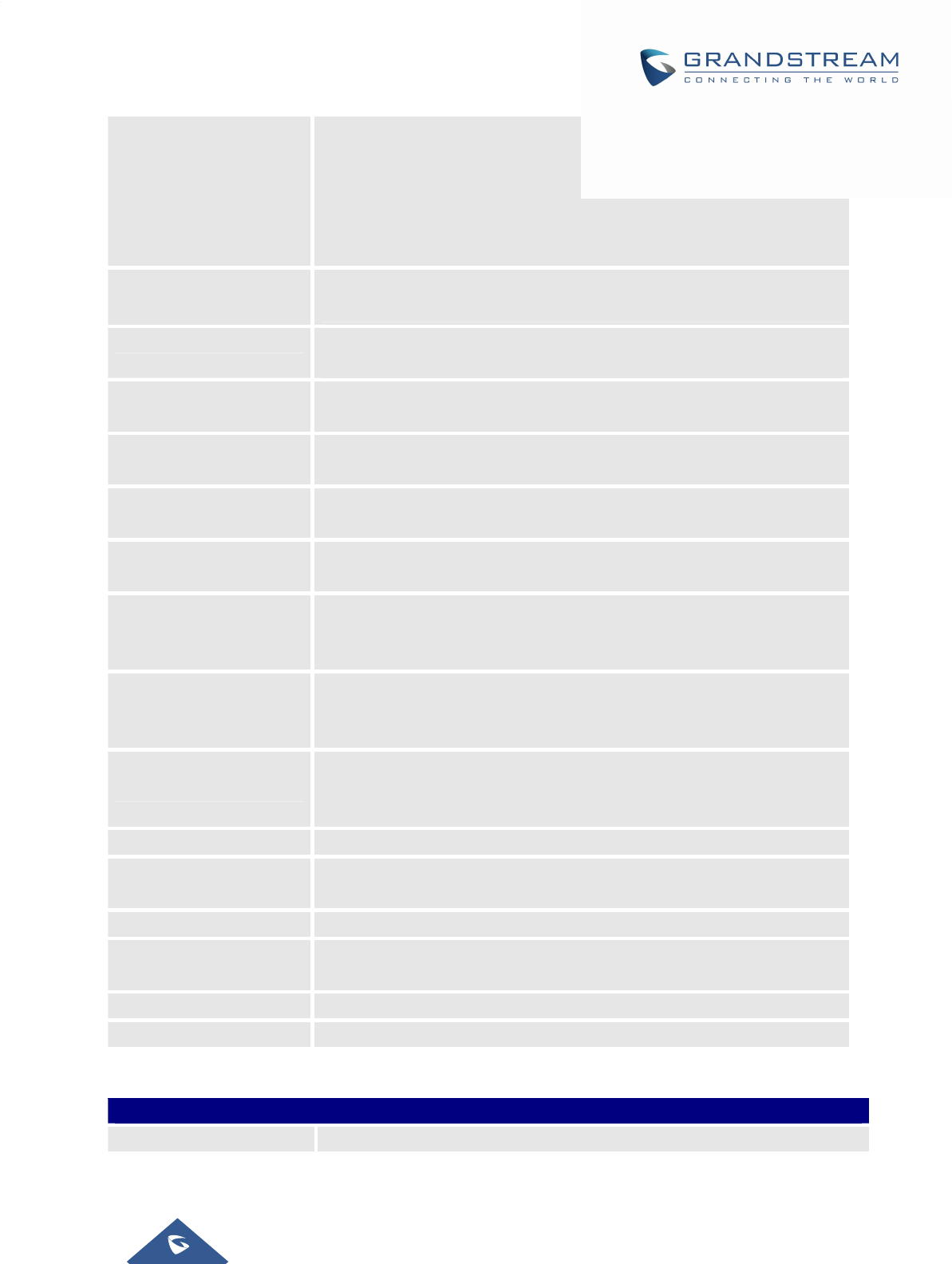
GXV3275 Administration Guide
Version 1.0.3.186
Page |75
802.1x mode Enables and selects the 802.1x mode for the phone system. The
supported 802.1x modes are:
EAP-MD5
EAP-TLS
EAP-PEAP
The default setting is "Disable".
802.1x Identity Enters the identity information for the selected 802.1x mode. (This setting
will be displayed only if 802.1 X mode is enabled).
802.1x Secret Enters the secret for the 802.1x mode. This option will appear when
802.1x mode is EAP-MD5 or EAP-PEAP.
802.1x Private Key
Password
Enters the password for the selected 802.1x mode. (This setting will be
displayed only if the 802.1 X mode is enabled).
CA Certificate Uploads the CA Certificate file to the phone. (This setting will be displayed
only if the 802.1 X mode is enabled)
Client Certificate Loads the Client Certificate file to the phone. (This setting will be displayed
only if the 802.1 X TLS mode is enabled)
Private Key Loads the private key file to the phone. (This setting will be displayed only
if the 802.1 X TLS mode is enabled)
HTTP/HTTPS Proxy
Hostname
Configures the HTTP/HTTPS proxy URI of the network. Some of networks
requires going through a proxy to access to the Internet. The default
setting is keeping this field blank.
HTTP/HTTPS Proxy Port Configures the HTTP/HTTPS proxy port number of the network. Some of
networks requires going through a proxy to access to the Internet. The
default setting is keeping this field blank.
Bypass Proxy For
Defines the specific URI that the phone can directly access to without
HTTP/HTTPS proxy. If it is filled, the phone will bypass the proxy to send
the packets to the specific URI. The default setting is filed blank.
IPv6 Address Specify whether to set IPv6 Statically or auto configured.
Static IPv6 Address When selecting Statically configured IPv6, user need to set the IPv6
address on this field.
IPv6 Prefix length Specify the Prefix length of the IPv6 address.
DNS Server 1 It is used to configure the primary DNS IPv6 address if IPv6 is statically
configured.
DNS Server 2 It is used to configure the secondary DNS IPv6 address.
Preferred DNS Server Set the Preferred DNS IPv6 URL.
Maintenance/Wi‐FiSettings
Wi-Fi Basics
Wi-Fi Function Enables/disables the WiFi feature. The default setting is "Disable".
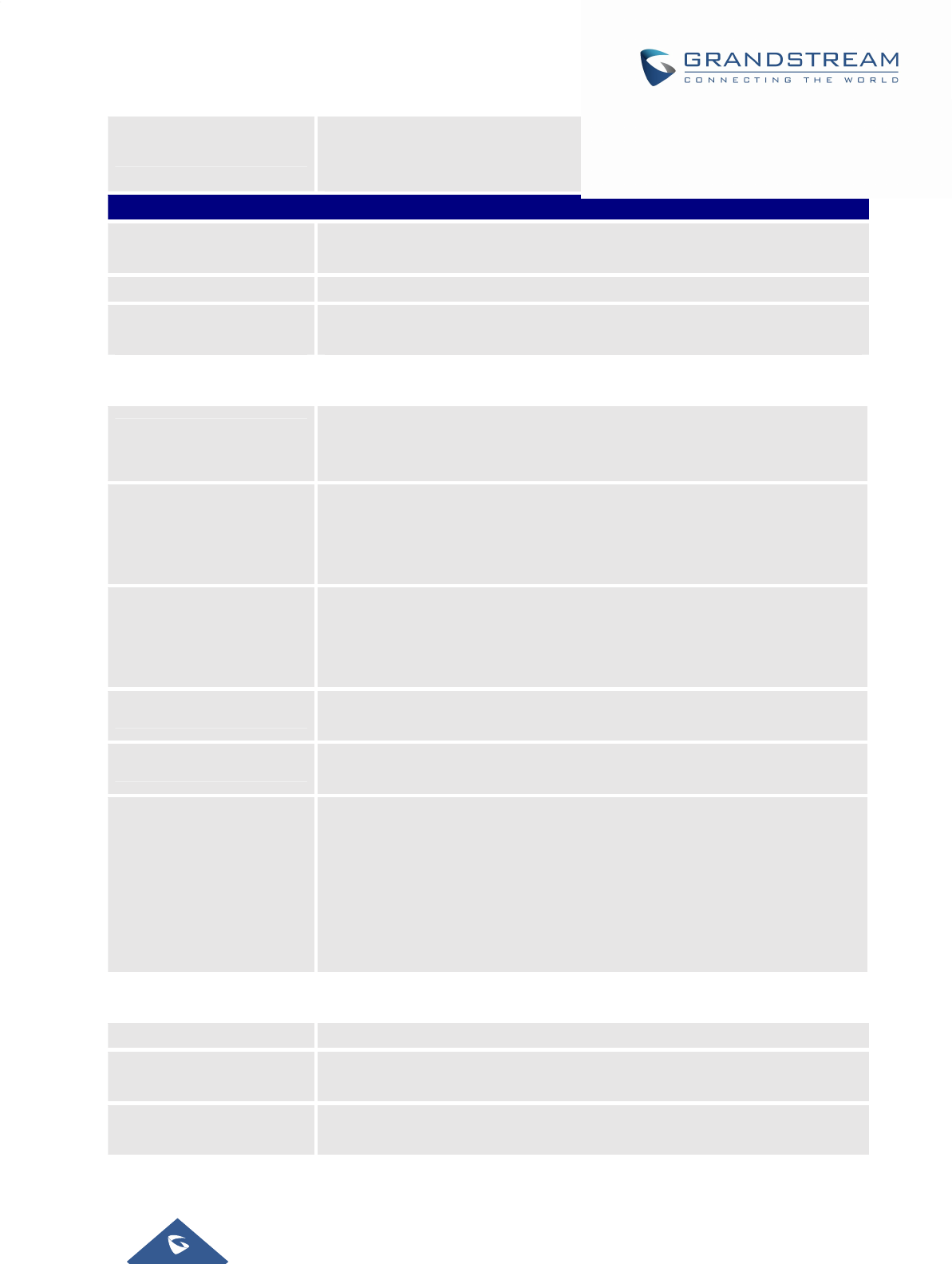
GXV3275 Administration Guide
Version 1.0.3.186
Page |76
ESSID
Permits to scan and select the available WiFi networks within the range if the
WiFi feature is enabled. Click on "Select" to select the Wi-Fi network to
connect to. The ESSID will be auto filled in the ESSID filed.
Wi-Fi Security
ESSID Determines the ESSID of the selected WiFi network. It can be auto filled by
clicking the select button on the web page.
Password Determines the password for the selected WiFi network.
Security Mode for Hidden
SSID
Defines the security mode used for the wireless network when the SSID is
hidden. Default is “None”.
Maintenance/TimeSettings
Assign NTP Server
Address
Defines the URL or IP address of the NTP server. The phone may obtain the
current date and time information from the server. The default setting is
“pool.ntp.org”.
DHCP Option 42 override
NTP server
Obtains NTP server address from a DHCP server using DHCP Option 42; it
will override configured NTP Server. If set to “No”, the phone will use
configured NTP server to synchronize time and date even if a NTP server is
provided by DHCP server. The default setting is "Yes".
DHCP Option 2 to
override Time Zone
setting
Obtains time zone setting (offset) from a DHCP server using DHCP Option
2; it will override selected time zone.
If set to “No”, the phone will use selected time zone even if provided by
DHCP server.Default setting is Yes.
Time Zone Specifies the local time zone for the phone. It covers the global time zones
and user can selected the specific one from the drop-down list.
Time Display Format Specifies which format will be used to display the time. It can be selected
from 12-hour and 24-hour format.
Date Display Format
Determines which format will be used to display the date.
It can be selected from the drop-down list.
Normal (M/DD/YYYY): 1/31/2012
YYYY/MM/DD: 2012/01/31
MM/DD/YYYY: 01/31/2012
DD/MM/YYYY: 31/01/2012
The default setting is MM/DD/YYYY.
Maintenance/Web/SSHAccess
Disable SSH Blocks any SSH access to the phone. The default setting is "No".
Disable Web GUI If set to "Yes", the phone will not allow any web access to the phone. The
default value is "No".
Access Method Determines which protocol will be used to access the phone ‘s Web GUI. It
can be selected from HTTP and HTTPS. The default setting is HTTP.

GXV3275 Administration Guide
Version 1.0.3.186
Page |77
Port Specifies which port to use to access the phone ‘s Web UI. By default, if
HTTP, the port number will be 80; if HTTPS is selected, the port number will
be 443.
Admin Password Configures the administrator password for Web GUI. It is case sensitive with
a maximum length of 32 characters.
The default password is "admin".
Confirm Admin
Password Confirms the new admin password.
User Password Configures the user password for Web GUI. It is case sensitive with a
maximum length of 32 characters.
The default password is "123".
Confirm User Password Confirms the new admin password.
Maintenance/Upgrade
Firmware Upgrade Via Allows users to choose the firmware upgrade method: TFTP, HTTP,
HTTPS or Manual Upload. The default setting is “HTTP”.
Firmware Server Path Sets IP address or domain name of firmware server. The URL of the
server that hosts the firmware release. Setting variables on the server
path is also supported, When the phone initiates the firmware request, the
device should automatically replace the variable between “%” with the
actual value. Default is fm.grandstream.com/gs.Supported Variable:
PN
MAC
HWVER
SWVER
HWMODEL
Firmware HTTP/HTTPS
User Name
Enters the user name for the firmware HTTP/HTTPS server.
Firmware HTTP/HTTPS
Password
Enters the password for the firmware HTTP/HTTPS server.
Firmware File Prefix Checks if firmware file is with matching prefix before downloading it. This
field enables user to store different versions of firmware files in one
directory on the firmware server.
Firmware File Postfix Checks if firmware file is with matching postfix before downloading it. This
field enables user to store different versions of firmware files in one
directory on the firmware server.
Use Grandstream GAPS When checked GAPS server will be used for provisioning redirection.
Config Upgrade Via Selects provisioning method: TFTP, HTTP or HTTPS. Default setting is
“HTTPS”.
Config Server Path Sets IP address or domain name of configuration server. The server hosts

GXV3275 Administration Guide
Version 1.0.3.186
Page |78
a copy of the configuration file to be installed on the phone. Setting
variables on the server path is also supported, When the phone initiates
the provisioning request, the device should automatically replace the
variable between “%” with the actual value. Default is
fm.grandstream.com/gs.
Supported Variable:
PN
MAC
HWVER
SWVER
HWMODEL
Config HTTP/HTTPS
User Name
Configures the user name for the config HTTP/HTTPS server.
Config HTTP/HTTPS
Password
Configures the password for the config HTTP/HTTPS server.
Config File Prefix Checks if configuration files are with matching prefix before downloading
them.
This field enables user to store different configuration files in one directory
on the provisioning server.
Config File Postfix Checks if configuration files are with matching postfix before downloading
them.
This field enables user to store different configuration files in one directory
on the provisioning server.
Authenticate Conf File Sets the phone system to authenticate configuration file before applying it.
When set to “Yes”, the configuration file must include value P1 with phone
system’s administration password. If it is missed or does not match the
password, the phone system will not apply it. Default setting is “No”.
XML Config File
Password
Decrypts XML configuration file when encrypted. The password used for
encrypting the XML configuration file is using OpenSSL.
Download Device
Configuration
Downloads the phone's configuration file in text format. The config file
includes all the P value parameters for phone's current settings except
password for security purpose. Users can use the Grandstream
configuration file generator to generate binary config file from this text file.
Upload Device
Configuration
Uploads configuration file to the phone.
Note: The GXV3275 supports the following config file format:
“cfgMAC.xml”, where MAC is the MAC Address.
“cfggvx3275.xml”, where GXV3275 is the Product Model.
GUI customization file
download mode
Selects download method: TFTP, HTTP or HTTPS. Default setting is
“HTTP”.
GUI customization file Sets IP address or domain name of the GUI customization file server. The

GXV3275 Administration Guide
Version 1.0.3.186
Page |79
URL server hosts a copy of the file to be installed on the phone. The Default
setting is fm.grandstream.com/gs.
GUI customization file
HTTP/HTTPS username
Enters the username for the firmware HTTP/HTTPS server.
GUI customization file
HTTP/HTTPS password
Enters the password for the firmware HTTP/HTTPS server.
Use Configurations of
Config File Server
Retrieve and download customization file with the configuration of the
config file.
Configuration via
Keypad Menu
Configures access control for keypad Menu settings on the Settings
interface of the phone.
Unrestricted: configure all settings on the Settings interface;
BasicSettingsOnly: The Advanced Settings option will not be
displayed;
ConstraintMode: users need to input admin user password to
configure Wireless &Network and Advanced Settings.
Note: When access control for keypad is limited to “Basic Settings Only”
or “Constraint Mode”, the Admin authentication will be mandatory to start
Factory Reset process.
Always send HTTP Basic
Authentication
Information
Includes configured user name and password in HTTP request before
receiving authentication challenge from the server. Default is “No”.
Validate Certification
Chain
Configures whether to validate the server certificate when download the
firmware/config file.
If it is set to "Yes", the phone will download the firmware/config file only
from the legitimate server. Default setting is "No".
mDNS Override Server Sets the phone system to broadcast the Multicast DNS (mDNS) message
during booting up to allow itself to be discovered and be configured by the
SIP platform. If it is set to “User Type A’, the phone system will broadcast
the MDNS message “A_grandstream-cfg.local”; if it is set to “Use Type
SRV”, the MDNS message will be “SRV_grandstream-cfg.local”.
The default setting is “Use Type A”.
Allow DHCP Option 43
and Option 66 to
Override Server
Obtains configuration and upgrade server’s information from DHCP
server using options 66 and 43.
Note: If DHCP Option 66 is enabled, the phone will attempt downloading
the firmware file from the server URL provided by DHCP, even though
Config Server Path is left blank. Default setting is “Yes”.
DHCP Option 120
Override SIP Server
Configures the phone system to allow the DHCP offer message to override
the Config Server Path via the Option 120 header.

GXV3275 Administration Guide
Version 1.0.3.186
Page |80
The default setting is "Yes".
Allow DHCP Option 242
(Avaya IP Phones)
Enables DHCP Option 242. Once enabled, the phone will use the
configuration info issued by the local DHCP in Option 242 to configure
proxy, transport protocol and server path.
The default setting is “Yes”.
Enable PNP Feature Enables the PNP (Plug and Play) feature on the device. If it is enabled,
the device will be set as a provision server to send SIP NOTIFY message
including the provision URL to response the client phone’s SIP
SUBSCRIBE request.
This feature will be enabled if the PNP URL is configured. If this setting is
enabled, the 3CX Auto provision will be disabled automatically.
PNP URL Configures the URL to provision another client phone’s config server path.
The URL will be included in the SIP NOTIFY message.
PnP(3CX) Auto
Provision
Sets the phone system to broadcast the SIP SUBSCRIBE message
during booting up to allow itself to be discovered and be configured by the
SIP platform.
The default setting is "Yes".
Automatic Upgrade Specifies when the firmware upgrade process will be initiated; there are 4
options:
No: The phone will only do upgrade once at boot up.
Check every X minutes: User needs to specify a period in
minutes.
Check every day: User needs to specify “Hour of the day (0-23)”.
Check every week: User needs to specify “Hour of the day (0-23)”
and “Day of the week (0-6)”.
Check at a period Time: User needs to specify “Hour of the day
(0-23)”
Note: Day of week is starting from Sunday.The default setting is “No”.
Enable Randomized
Automatic Upgrade
Configures how the GXV3275 will check the server for new firmware and
configuration file downloading. It only valid if the user selects “Check at a
period of time” in the “Automatic Upgrade”. If enabled, GXV3275 upgrade
automatically at random time point in the setting period. This option is
mainly used for multiple devices upgrade at the same time.
Automatic Upgrade
Check Interval (m)
Configures how the phone system will check the server for new firmware
and configuration file downloading.
It only valid if the user selects “Check at a period of time” in the “Automatic
Upgrade”. Default setting is 10080 (namely 7 days).
Hour of the Day (0-23) Defines at which hour of the day they phone system will check the
HTTP/HTTPS/TFTP server for firmware upgrades or configuration files
changes.

GXV3275 Administration Guide
Version 1.0.3.186
Page |81
Day of the Week (0-6) Defines which day of the week the phone system will check the
HTTP/HTTPS/TFTP server for firmware upgrades or configuration files
changes.
Firmware Upgrade and
Provisioning
Defines the phone system’s rules for automatic upgrade. It can be
selected from:
Always Check at bootup
Always Check at bootup, when F/W pre/suffix changes,
Skip the Firmware Check.
The default setting is “Always Check at bootup”.
Disable SIP NOTIFY
Authentication
Disables the SIP NOTIFY Authentication on the phone. If set to “Yes”, the
phone will not challenge NOTIFY with 401. The default setting is “No”.
Auto Reboot to Upgrade
Without Prompt
Configures the phone system to pop up a notification message before
upgrading new firmware.
If set to "Yes", the phone will automatically start upgrading after
downloading the firmware file.
Otherwise, users would need to confirm in the prompted message on the
LCD screen to start upgrading process. The default setting is "Yes".
Factory Reset Resets the phone system to the default factory setting mode.
If the “Clear the SD card” is checked, the SD card storage mounted on the
phone will be format as well.
Maintenance/Syslog
Syslog Protocol Select the transport protocol over which log messages will be carried.
UDP: Syslog messages will be sent over UDP.
SSL/TLS: Syslog messages will be sent securely over TLS
connection. To upload server CA certificate follow below steps:
Copy CA file in SD card and plug it to the phone.
Go to LCD menu
SettingsSecuritySettingsInstallfromSDcard to install the
CA file.
Syslog Server Configures the URI which the phone system will send the syslog
messages to.The default setting is "log.ipvideotalk.com".
Syslog Level
Selects the level of logging for syslog. The default setting is "None". There
are 4 levels from the dropdown list: DEBUG, INFO, WARNING and
ERROR. The following information will be included in the syslog packet:
DEBUG (Sent or received SIP messages).
INFO (Product model/version on boot up, NAT related info, SIP
message summary, Inbound and outbound calls, Registration
status change, negotiated codec, Ethernet link up).
WARNING (SLIC chip exception).

GXV3275 Administration Guide
Version 1.0.3.186
Page |82
ERROR (SLIC chip exception, Memory exception).
Note: Changing syslog level does not require a reboot to take effect.
Syslog Keyword Filter Only send the syslog with keyword, multiple keywords are separated by
comma. Example: set the filter keyword to “SIP” to filter SIP log.
Maintenance/Logcat
Clear Log Clears the log files saved in the phone system.
Log Tag Configures the filter to display the specified process log file.
Log Priority
Selects the log priority to display. It can be selected from list below:
Verbose (Default Setting)
Debug
Info
Warn
Error
Fatal
Silent (suppress all output)
Get Log Displays the log file on the web page.
Maintenance/Debug
Capture Trace Press START to start capturing a trace, and press STOP to stop the
capture process.
Trace List Lists the captured files in the drop-down box. Click the "Delete" button to
delete the selected trace.
View Trace Enters the phone system’s directory to view the captured trace files from
the web browser. In the directory, click on the name of the file to
download.
Note: The trace files are saved in phone’s internal storage. Users can
access or delete the trace files from LCDFileManagerInternal
Storageppp directory.
Enable Core Dump
Generation
Configures whether to generate and save the core dump file when the
program crashes. The default setting is “No”.
Core Dump List Selects the existing core dump file in the drop-down box. Users could
delete the file by pressing on “Delete” button.
View Core Dump Press “List” button to view all existing core dump files. The files are listed
in chronological order, users could click the file name to download the file
to the local computer.
Maintenance/Language
Language Sets the language to display on the phone's LCD.

GXV3275 Administration Guide
Version 1.0.3.186
Page |83
Maintenance/EventNotification
Set the URL for events on phone web GUI, and when the corresponding event occurs on the phone, the
phone will send the configured URL to SIP server. The dynamic variables in the URL will be replaced by
the actual values of the phone before sending to SIP server, in order to achieve the purpose of events
notification. Here are the standards:
1. The IP address of the SIP server needs to be added at the beginning, and separate the dynamic
variables with a "/".
2. The dynamic variables need to have a "$" at the beginning. For example: local=$local
3. If users need to add multiple dynamic variables in the same event, users could use "&" to connect with
different dynamic variables.For example: 192.168.40.207/mac=$mac&local=$local
4. When the corresponding event occurs on the phone, the phone will send the MAC address and phone
number to server address 192.168.40.207.
On Boot Completed Configures the event URL when phone boots up.
Incoming Call Configures the event URL when phone has an incoming call.
Outgoing Call Configures the event URL when phone has an outgoing call.
On Off-hook Configures the event URL when the phone is off-hook.
On On-hook Configures the event URL when the phone is on-hook.
Missed Call Configures the event URL when the phone has new a missed call.
On Connected Configures the event URL when a call is established.
On Disconnected Configures the event URL when a call is disconnected.
DND On Configures the event URL when DND is enabled.
DND Off Configures the event URL when DND is disabled.
Forward On Configures the event URL when the forward feature is enabled on the
phone.
Forward Off Configures the event URL when the forward feature is disabled on the
phone.
On Blind Transfer Configures the event URL when users transfer a call with blind transfer on
the phone.
On Attended Transfer Configures the event URL when users transfer a call with attended
transfer on the phone.
On Hold Configures the event URL when users hold a call on the phone.
On UnHold Configures the event URL when users resume a call on the phone.
Log On Configures the event URL when users log on the phone successfully.
Log Off Configures the event URL when users log off the phone.
On Register Configures the event URL when an account in the phone is registered
successfully.
On Unregister Configures the event URL when an account in the phone is unregistered.
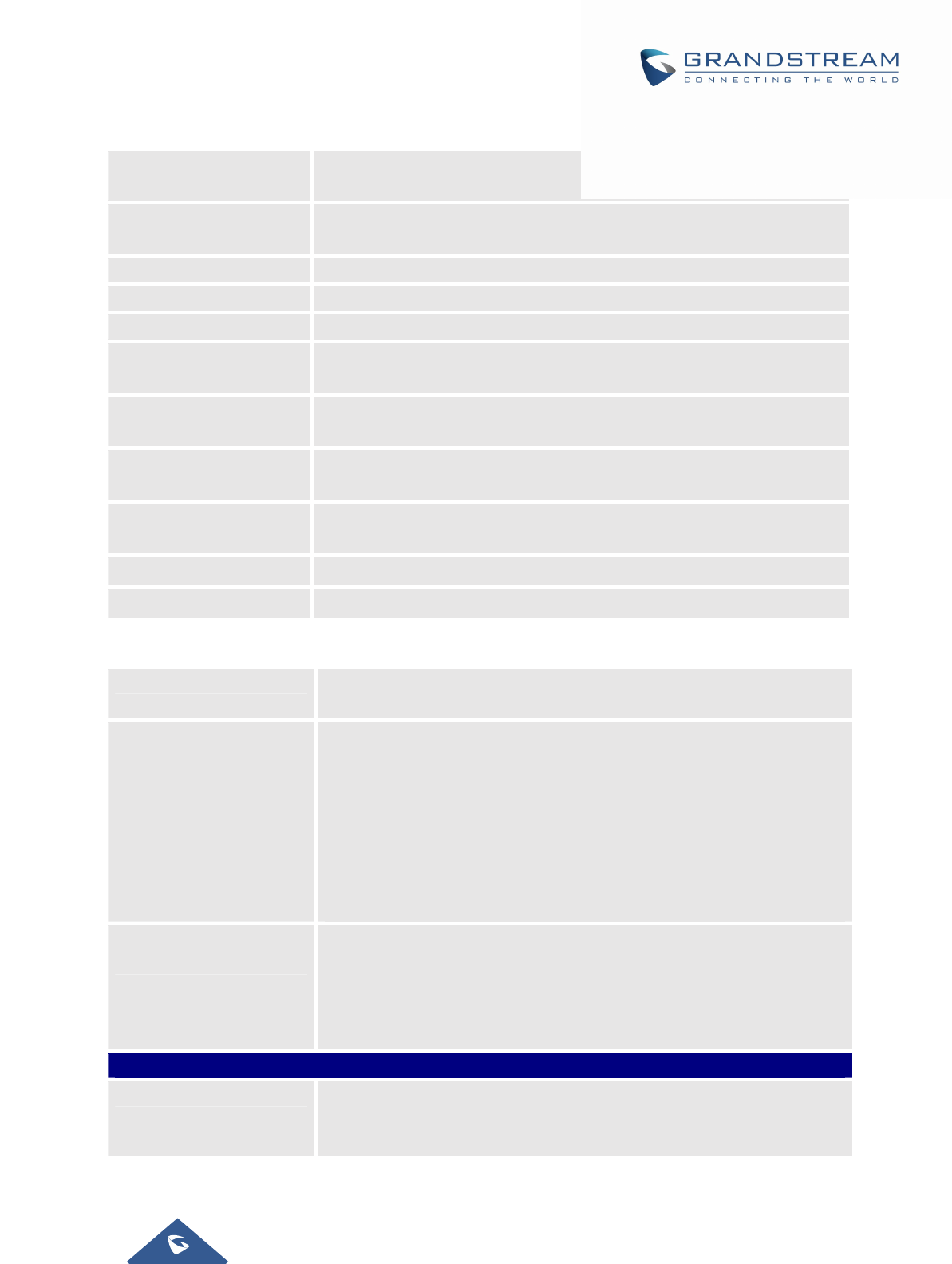
GXV3275 Administration Guide
Version 1.0.3.186
Page |84
Maintenance/TR‐069
Enable TR-069 Sets the phone system to enable the “CPE WAN Management Protocol”
(TR-069). The default setting is "No".
ACS URL Specifies URL of TR-069 ACS (e.g.,http://acs.mycompany.com), or IP
address.
ACS Username Enters username to authenticate to ACS.
ACS Password Enters password to authenticate to ACS.
Periodic Inform Enable Sends periodic inform packets to ACS. Default is “No”.
Periodic Inform Interval
(s)
Configures to sends periodic “Inform” packets to ACS based on specified
interval.
Connection Request
Username
Enters user name for the ACS to connect to the phone.
Connection Request
Password
Enters password for the ACS to connect to the phone.
Connection Request
Port
Enters the port for the ACS to connect to the phone.
CPE Cert File Uploads Cert File for the phone to connect to the ACS via SSL.
CPE Cert Key Uploads Cert Key for the phone to connect to the ACS via SSL.
Maintenance/Contacts
Sort Phonebook by Sets which part of name, first name or last name, will be sorted in
alphabetical order to display.
Phonebook Key Function Controls the behaviors of the phonebook key. It could be set to:
Default
LDAP Search
Local Phonebook
Local Group
BroadSoft Phonebook
The default setting is “Default”, which set the phonebook key to the
Contacts menu.
Emergency Call
Numbers
Configures the emergency contact in logout mode. If the system is logout,
guest users can dial the configured emergency contacts.
Input the number in the input box and click "Add" to add the number to the
contacts list. To delete the existing ICE number, select the number in the
contacts list and click "Delete".
Import/Export
File Encoding Specifies the encoding format for phonebook file importing or exporting. It
can be selected from the dropdown list:
UTF-8
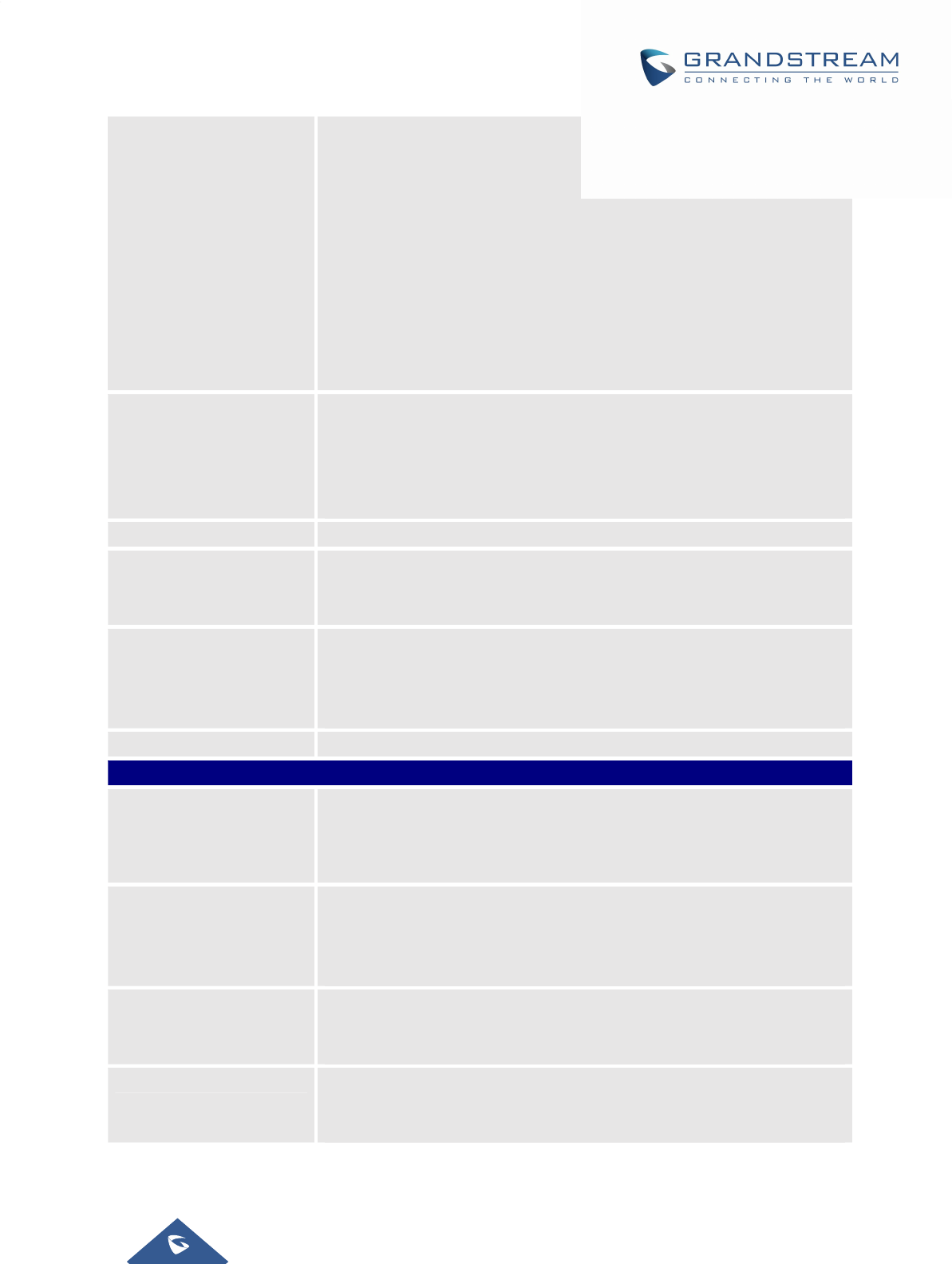
GXV3275 Administration Guide
Version 1.0.3.186
Page |85
GBK
UTF-16
UTF-32
Big5
Big5-HKSCS
Shift-JIS
ISO8859-1
ISO8859-15
Windows-1251
EUC-KR
The default setting is UTF-8.
File Type Sets the type format for phonebook file importing or exporting. It can be
selected from the dropdown list. The default setting is "XML".
XML
VCard
CSV
Save Phonebook to PC Downloads the phonebook file from the phone system to PC.
Clear The Old List Determines if the phone system will delete the previous contacts when a
new contact file is imported. If set to "Yes", the previous contacts will be
removed. The default setting is "No".
Replace Duplicate Items Configures the phone system to keep the original contact entries when
duplicated contact entries are included in the contact file. If set to "Yes",
the phone will replace the original entries to the new one. Otherwise, the
phone system will save both contact entries. The default setting is "No".
Local File Uploads the contact files from PC to the phone system.
Download (XML Phonebook)
Clear The Old List Sets the phone system to delete the previous contacts when a new
contact file is downloaded. If set to "Yes", the previous contacts will be
removed. The default setting is "No".
Replace Duplicate Items Keeps the original contact entries when duplicated contact entries are
included in the contact file. If set to "Yes", the phone will replace the
original entries to the new one. Otherwise, the phone system will save
both contact entries. The default setting is "No".
Download Mode Enables the phone system to download phonebook file and select the
server and protocol to download the phonebook file. It can be selected
from TFTP, HTTP, and HTTPS. The default setting is “OFF”.
File Encoding Selects the encoding format for phonebook file download. It can be
selected from the dropdown list:
UTF-8
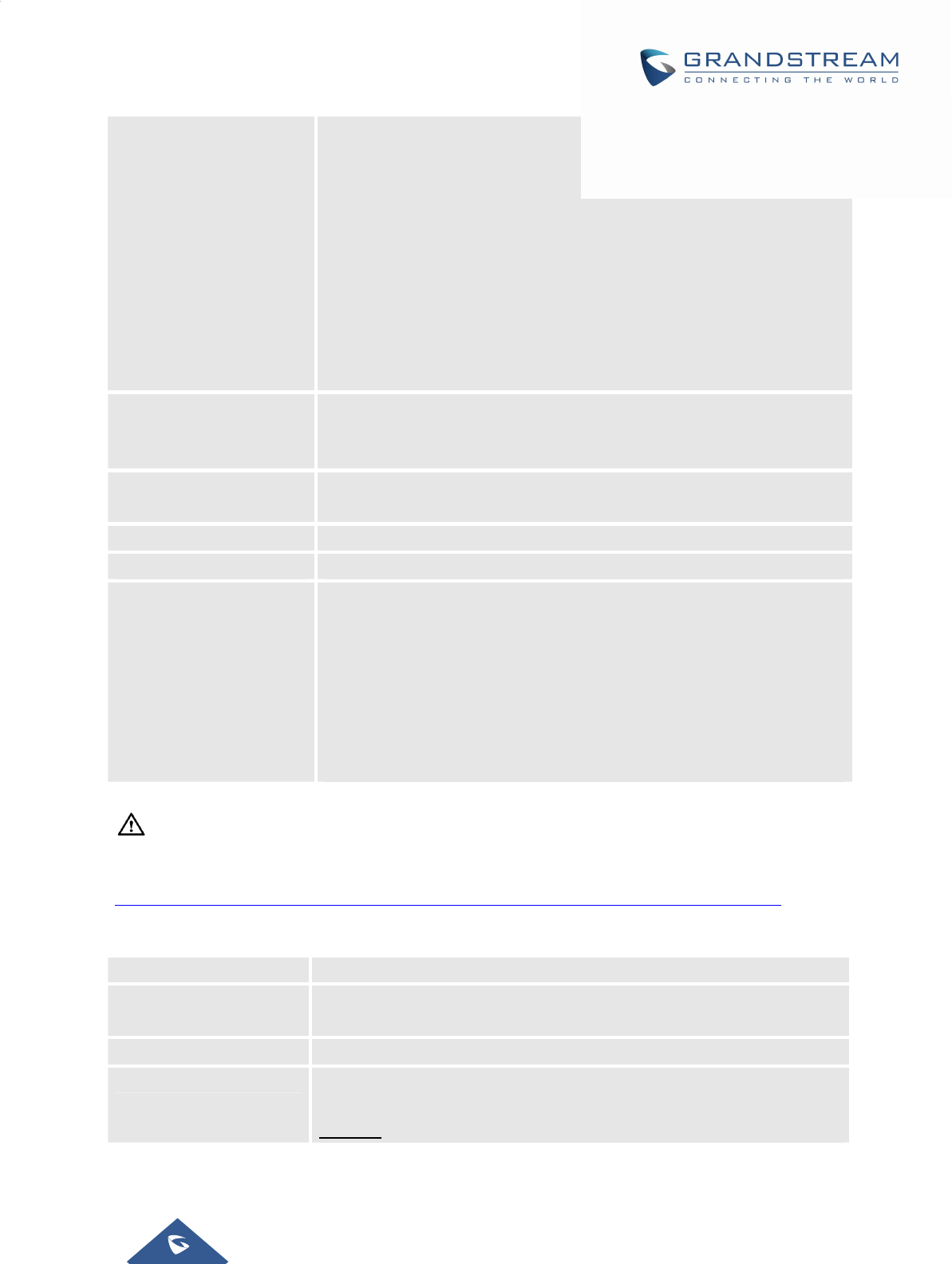
GXV3275 Administration Guide
Version 1.0.3.186
Page |86
GBK
UTF-16
UTF-32
Big5
Big5-HKSCS
Shift-JIS
ISO8859-1
ISO8859-15
Windows-1251
EUC-KR
The default setting is UTF-8.
Download Server Configures the server URL to download the phonebook file.
The phone system will send a request to the server to download the
phonebook file with filename phonebook.xml.
HTTP/HTTPS User Name Configures user name for HTTP/HTTPS server to download the
phonebook file.
HTTP/HTTPS Password Specifies password for HTTP/HTTPS server to download phonebook file.
Download Now Starts downloading the XML phonebook to the phone immediately.
Download Interval Determines how the phone system to send the request to the server to
download the phonebook file.It can be selected from the dropdown list:
None
2 Hour
4 Hour
6 Hour
8 Hour
12 Hour
Note:
For more information on XML Based Downloadable Phonebook on GXV3275, please refer to the
GXV3275 XML Phonebook Guide in the following link:
http://www.grandstream.com/sites/default/files/Resources/gxv3275_xml_phonebook_guide.pdf
Maintenance/LDAPBook
Connection Mode Selects which protocol will be used for LDAP searching, LDAP or LDAPS.
Server Address Configures the URI of the LDAP (Lightweight Directory Access Protocol)
server.
Port Configures the LDAP server port. The default LDAP port number is 389.
Base DN Determines the LDAP search base. This is the location in the directory
where the search is requested to begin.
Example:
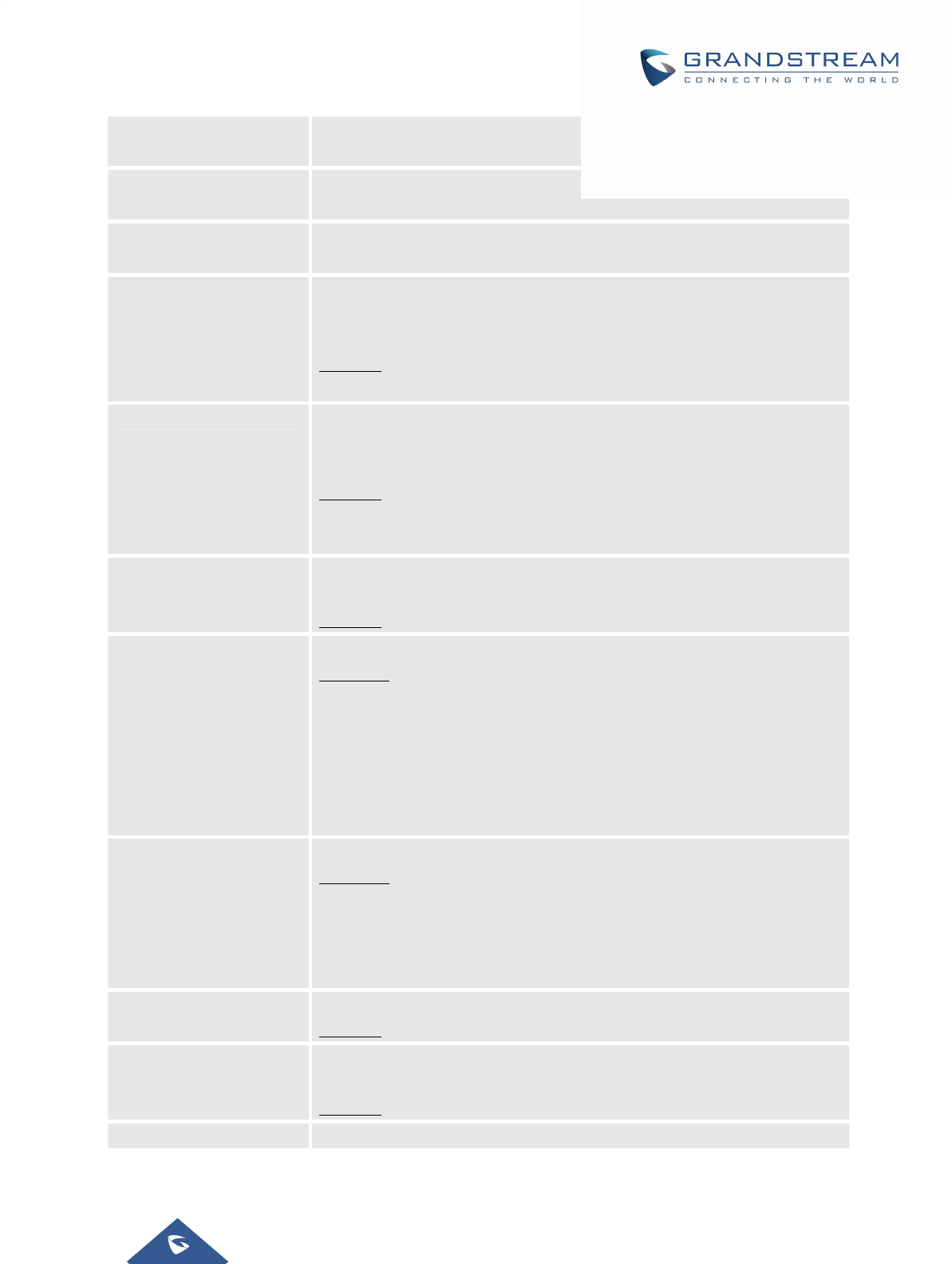
GXV3275 Administration Guide
Version 1.0.3.186
Page |87
dc=grandstream, dc=com
ou=Boston, dc=grandstream, dc=com
User Name Configures the bind "Username" for querying LDAP servers. Some LDAP
servers allow anonymous binds in which case the setting can be left blank.
Password Specifies the bind "Password" for querying LDAP servers. The field can be
left blank if the LDAP server allows anonymous binds.
LDAP Name Attributes Configures the "name" attributes of each record which are returned in the
LDAP search result. This field allows the users to configure multiple space
separated name attributes.
Example:
cn sn description
LDAP Number Attributes Configures the "number" attributes of each record which are returned in
the LDAP search result. This field allows the users to configure multiple
space separated number attributes.
Example:
telephoneNumber
telephoneNumber Mobile
LDAP Mail Attributes Determines the "mail" attributes of each record which are returned in the
LDAP search result.
Example:mail
LDAP Name Filter Configures the filter used for name lookups.
Examples:
(|(cn=%)(sn=%)) returns all records which has the "cn" or "sn" field starting
with the entered prefix;
(!(sn=%)) returns all the records which do not have the "sn" field starting
with the entered prefix;
(&(cn=%) (telephoneNumber=*)) returns all the records with the "cn" field
starting with the entered prefix and "telephoneNumber" field set.
LDAP Number Filter Defines the filter used for number lookups.
Examples:
(|(telephoneNumber=%)(Mobile=%) returns all records which has the
"telephoneNumber" or "Mobile" field starting with the entered prefix;
(&(telephoneNumber=%) (cn=*)) returns all the records with the
"telephoneNumber" field starting with the entered prefix and "cn" field set.
LDAP Mail Filter Determines the filter used for mail lookups.
Example:(mail=%)
LDAP Displaying Name
Attributes
Configures the entry information to be shown on phone's LCD. Up to 3
fields can be displayed.
Example:%cn %sn %telephoneNumber
Max Hits Specifies the maximum number of results to be returned by the LDAP
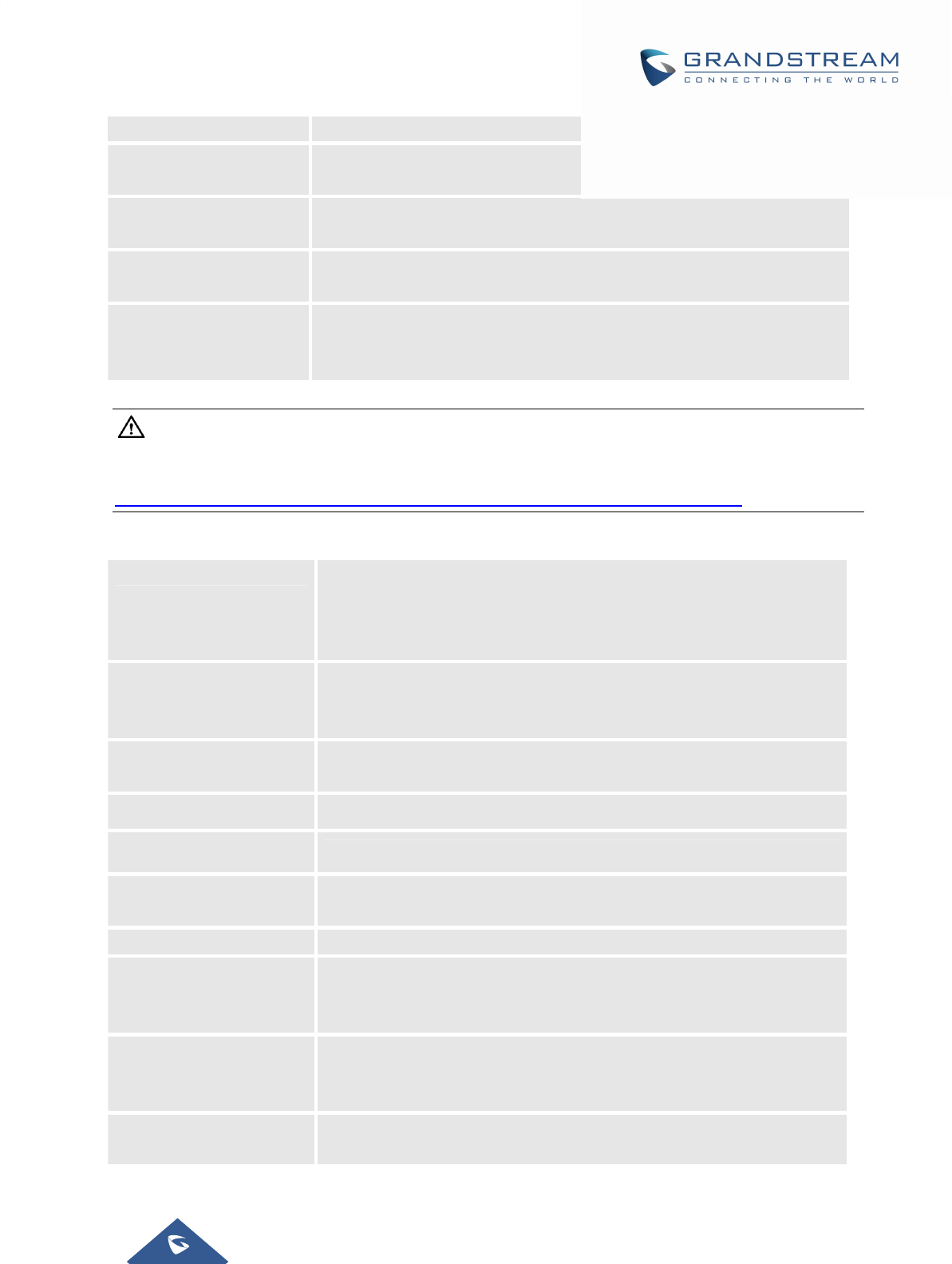
GXV3275 Administration Guide
Version 1.0.3.186
Page |88
server. If set to 0, server will return all search results. Default setting is 50.
Search Timeout (ms) Configures the interval (in seconds) for the server to process the request
and client waits for server to return. The default setting is 4000 seconds.
LDAP Lookup For Dial Sets the phone system to do the LDAP number searching when making
outgoing calls. The default setting is "No".
LDAP Lookup For
Incoming Call
Sets the phone system to do LDAP number searching for incoming calls.
The default setting is "No".
LDAP Dialing Default
Account
Configures the default account that being used when dialing LDAP
contact. Users may choose the Account 1-6, the default setting is
“Default”.
Note:
For more information on how to configure LDAP on GXV3275, please refer to the GXV3275 LDAP
Configuration Guide in the following link:
http://www.grandstream.com/sites/default/files/Resources/gxv3275_ldap_book_guide.pdf
Maintenance/BroadsoftDirectories
Authentication Type Defines the authentication type in way of login or use SIP. If set to "Login
Credentials", please fill in Username and Password in the following
options; if set to "SIP Credentials", please fill in Username, User ID, and
Password. The default setting is "SIP Credentials".
Server Configures the BroadWorks Xsi server URI. If the server uses HTTPS,
please add the header “HTTPS” ahead of the Server URI. For instance,
“https://SERVER_URI”.
Port Configures the BroadWorks Xsi server port. The default port is 80. If the
server uses HTTPS, set to 443.
BroadWorksUser ID Determines the User ID for Broadsoft XSI server.
SIP Authentication ID Determines username for Broadsoft XSI server.
SIP Authentication
Password Determines password for Broadsoft XSI server.
Login Password Specifies the password for the BroadWorks Xsi query.
Group Directory Enables/disables the BroadWorks Xsi Group Directory features on the
phone. The name filed is used to name the directory. If it keeps blank, the
phone system will use the default name “Group” for it.
Enterprise Directory Enables/disables the BroadWorks Xsi Enterprise Directory features on
the phone. The name filed is used to name the directory. If it keeps blank,
the phone system will use the default name “Enterprise” for it.
Group Common Enables/disables the BroadWorks Xsi Group Common features on the
phone. The name filed is used to name the directory. If it keeps blank, the

GXV3275 Administration Guide
Version 1.0.3.186
Page |89
phone system will use the default name “Group Common” for it.
Enterprise Common Enables/disables the BroadWorks Xsi Enterprise Common features on
the phone. The name filed is used to name the directory. If it keeps blank,
the phone system will use the default name “Enterprise Common” for it.
Personal Directory Enables/disables the BroadWorks Xsi Personal Directory features on the
phone. The name filed is used to name the directory. If it keeps blank, the
phone system will use the default name “Personal Directory” for it.
Polycom Phonebook Enables/disables the BroadWorks Xsi Polycom Phonebook features on
the phone. The name filed is used to name the directory. If it keeps blank,
the phone system will use the default name “Polycom Phonebook” for it.
Missed Call Log Enables/disables the BroadWorks Xsi Missed Call Log features on the
phone. The name filed is used to name the directory. If it keeps blank, the
phone system will use the default name “Missed” for it.
Placed Call Log Enables/disables the BroadWorks Xsi Placed Call Log features on the
phone. The name filed used to name the directory. If it keeps blank, the
phone system will use the default name “Outgoing” for it.
Received Call Log Enables/disables the BroadWorks Xsi Received Call Log features on the
phone. The name filed used to name the directory. If it keeps blank, the
phone system will use the default name “Incoming” for it.
Broadsoft Directory &
Call Logs Update Interval
(s)
Specifies how often the phone system sends HTTP/HTTPS query to the
BroadWorks Xsp server to update the BroadWorks Call History. The
default setting is 1800 seconds.
Broadsoft Directory Hits Determines how many entry results will be showed in each query. If it is
configured, the phone system will add the header to the HTTP query. The
valid range is from 1 to 1000.
The default setting is blank, which means to use the server's default
value.
Broadsoft Directory
Order
Configures the BS contact order on the LCD. The order of contact
categories on the Web GUI from top to bottom is same as the order from
left to right on the BS contact app.
Select one item and click the Up/Down arrow to adjust the order.
Maintenance/BroadsoftIM&P
Server Configures the Broadsoft XMPP server URI.
Port Specifies the Broadsoft XMPP server port. The default port is 5222.
Username Determines the Username for the Broadsoft XMPP query.
Password Determines the password for the Broadsoft XMPP query.
Enable Broadsoft IM&P Enables the Broadsoft XMPP feature.
Associated Broadsoft
Account Binds the SIP account for dialing the XMPP client contacts.

GXV3275 Administration Guide
Version 1.0.3.186
Page |90
Auto Login Sets the client to be logged automatically if the application is started.
Display Non XMPP
Contacts Determines if the client app will show the non-XMPP contacts.
Maintenance/DeviceManager
HDMI Control Enables the HDMI output and selects the HDMI mode if it is activated.
It can be selected from the dropdown list.
Close HDMI Output: The phone system will shut down the HDMI
port.
HDMI Display Synchronization with LCD: The connected HDMI
device will mirror the LCD display.
Show Opposite Screen: The connected HDMI device will play the
remote party’s video during a video call. The rest displays are mirror
the LCD screen.
The default setting is "HDMI Display Synchronization with LCD".
AE Mode Selects AE mode (Automatic Exposure). AE mode has two options "Dark
Environment" and "Bright Environment". Users could select the mode
according to the actual environment (dark or bright) where the camera is
being used. The phone's camera settings including exposure, brightness,
contrast and Gamma value will be automatically adjusted to achieve
better visual effect under the selected environment. The default setting is
"Bright Environment".
Disable Missed Call
Backlight
Keeps LCD screen turned on after screen timeout when there is
unchecked missed call on the phone if set to “Yes”.Default setting is "No".
Key Backlight Configures the backlight for the touch keys on the GXV3275. Users can
select "Change with LCD brightness", "Always Bright" or "Always Dark".
The default setting is "Change with LCD brightness", which mean it will
turns off if the LCD is off and turns on if the LCD is back on.
Disable Missed Call
Indicator
Turns off the LCD backlight when there are new missed call logs on the
phone. If it set to “Yes”, the LCD backlight will be turned off if the phone
system has new missed call log. Otherwise, the LCD backlight will keep
on. The default setting is "No".
Disable MWI Indicator Turns on the LED indicator at device’s upper right corner when there are
unread Voice Mails. If it set to “Yes”, the LED indicator will keep off if the
phone system receives SIP NOTIFY message about unread voice mail.
Otherwise, the LED indicator will be turned on. The default setting is "No".
Disable New Message
Indicator
Turns on the LED indicator at device’s upper right corner when there are
unread Messages. If it set to “Yes”, the LED indicator will keep off if the
phone system has new messages. Otherwise, the LED indicator will be
turned on. The default setting is "No".

GXV3275 Administration Guide
Version 1.0.3.186
Page |91
Disable Contact Full
Indicator
Sets the phone system to turn on the LED indicator at device’s upper right
corner when the internal contact storage or message storage is full. If it
set to “Yes”, the LED indicator will keep off if the phone system has new
messages. Otherwise, the LED indicator will be turned on. The default
setting is "No".
Disable Indicator When
LCD is Off
Configures the phone system to turn on the LED indicator at device’s
upper right corner when the LCD screen is turned off. If it set to “Yes”, the
LED indicator will keep off when the LCD screen is off. Otherwise, the
LED indicator will be turned on. The default setting is "No".
RJ9 Headset TX Gain
(dB)
Configures the Transmission Gain in RJ9 headset channel. It can be
selected from the dropdown list:
-24
-18
-12
-6
0
+6
+12
+18
+24
The default setting is 0dB.
RJ9 Headset RX Gain
(dB)
Configures the Receive Gain in RJ9 headset channel. It can be selected
from the dropdown list. The default setting is 0dB:
-9
-6
0
+6
+9
3.5mm Earphone TX
Gain (dB)
Set the Transmission Gain in 3.5mm earphone headset channel. It can be
selected from the dropdown list. The default setting is 0dB:
-24
-18
-12
-6
0
+6
+12
+18
+24
3.5mm Earphone RX Set the Receive Gain in 3.5mm earphone headset channel. It can be

GXV3275 Administration Guide
Version 1.0.3.186
Page |92
Gain (dB) selected from the dropdown list. The default setting is 0dB.
-9
-6
0
+6
+9
Headset Type Specifies which type of headset will be connected to the phone system. It
can be selected from the dropdown list:
Normal Headset
Plantronics EHS
If a normal RJ11 headset is connected, it should set to “Normal Headset”.
If a Plantronics EHS headset is used, it should set to “Plantronics EHS”.
Headset Key Mode When headset is connected to the phone, users could use the HEADSET
button in two different modes:
1. Default Mode
When the phone is in idle, press HEADSET button to off-hook the
phone and make calls by using headset. Headset icon will display
on the top of the call screen in dialing/talking status;
When there is an incoming call, press HEADSET button to pick
the call by using headset;
When there is an active call using headset, press HEADSET
button to hang up the call;
When Speaker/Handset is used in dialing/talking status, press
HEADSET button to switch to headset. Press it again to hang up
the call, or press Speaker/Handset to switch back to previous
mode.
2. Toggle Headset/Speaker
When the phone is in idle, press HEADSET button to switch to
Headset mode. The idle screen will display a Headset icon. In this
mode, if pressing Speaker button or entering digits, headset will
be used by default;
When there is an incoming call, press Answer icon on the screen
or Speaker button, headset will be used;
When there is an active call, press HEADSET button to toggle
between Headset and Speaker.
Enable 3.5mm Headset
Control
If set to "Yes", the headset can control the Onhook and Offhook. The
default setting is "No".
Handset TX Gain (dB) Configures the transmission gain of the handset.
0
-6
+6

GXV3275 Administration Guide
Version 1.0.3.186
Page |93
The default setting is “-6dB”.
Handset RX Gain (dB) Configures the handset volume, thus controls the received audio signal.
Note: When set to +6dB, the increasing handset volume may cause
irreversible damage to the hearing, please proceed with caution.
0
-6
+6
The default setting is “0dB”.
Virtual Sound Card TX
gain(dB)
Configures the transmission gain of the virtual sound card, it can be
selected from the dropdown list. The default setting is 0dB:
-18
-15
-12
-9
-6
-3
0
+3
+6
+12
+15
+18
Virtual Sound Card RX
gain(dB)
Configures the virtual sound card received audio signal, it can be selected
from the dropdown list. The default setting is “0dB”:
-18
-15
-12
-9
-6
-3
0
+3
+6
+9
+12
+15
+18
Handset Equalizer RX Specifies the handset equalizer RX, users could also set to "Gentle" or
"Fidelity".
Default
Gentle

GXV3275 Administration Guide
Version 1.0.3.186
Page |94
Fidelity
The default setting is “Fidelity”.
Disable RJ9 Headset
Auto Detect
If set to "Yes", the auto detection on RJ9 will be disabled automatically
and switch to plugin status.Users will need then to activate the RJ9
headset manually from the LCD screen. The default setting is "No".
Reboot
To reboot remotely your GXV3275, tap on "Reboot" button as displayed on following screenshot.
Figure 22: Reboot Button
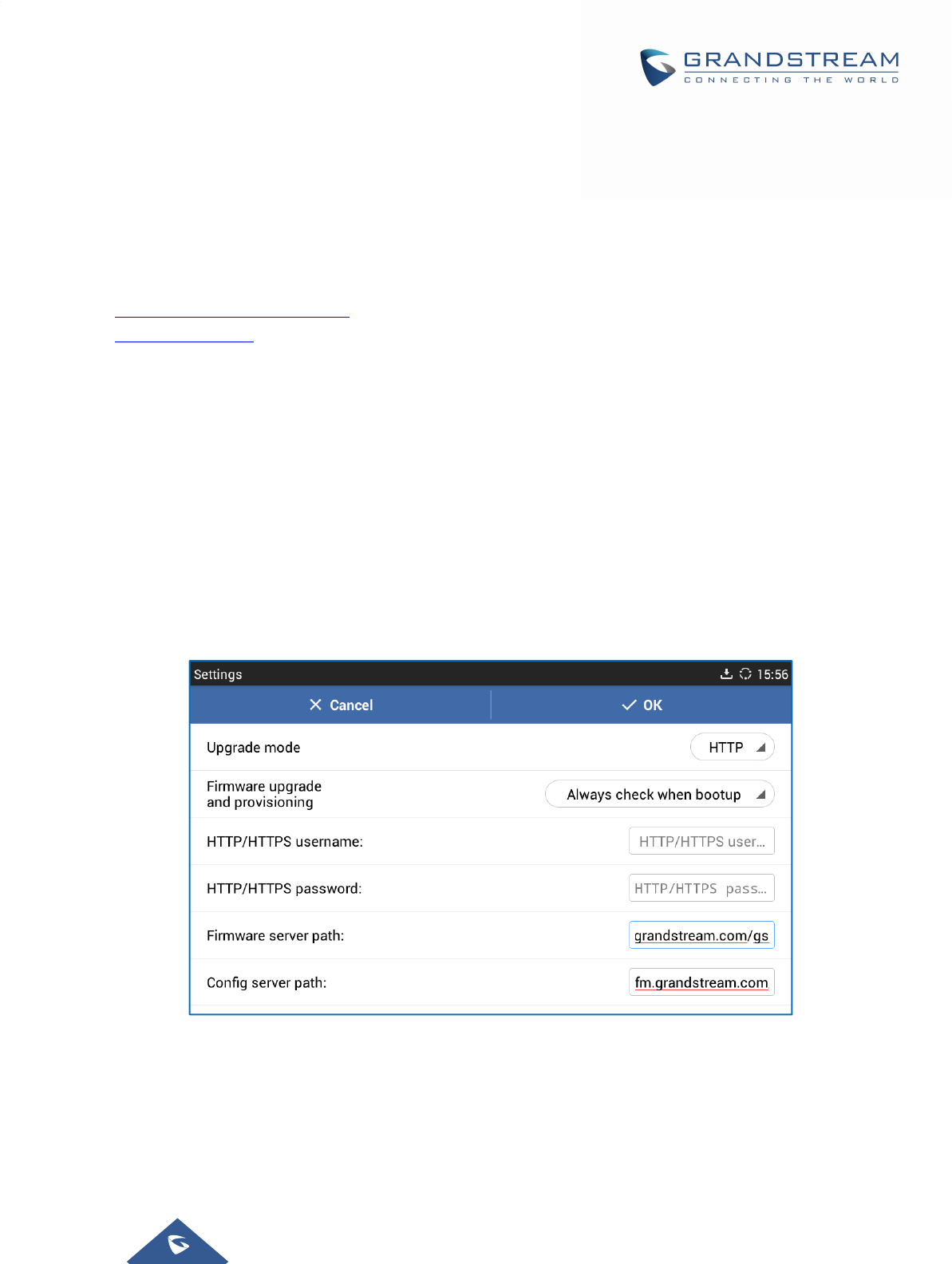
GXV3275 Administration Guide
Version 1.0.3.186
Page |95
UPGRADINGANDPROVISIONING
The GXV3275 can be upgraded via TFTP/HTTP/HTTPS by configuring the URL/IP Address for the
TFTP/HTTP/HTTPS server and selecting a download method.Configure a valid URL for TFTP, HTTP or
HTTPS; the server name can be FQDN or IP address.
Examples of valid URLs:
firmware.grandstream.com/BETA
fw.mycompany.com
UpgradeandProvisioningConfiguration
There are two ways to setup upgrade and provisioning on GXV3275. They are Keypad Menu and Web
GUI.
Configure via keypad Menu
In GXV3275 Settings, select Advanced SettingsUpgrade.Users may then select the upgrade
mode and enter the IP address or FQDN for the Firmware server and theConfig server. After making
the changes, tap Savebutton to save the change. Then reboot the phone.
Figure 23: GXV3275 Upgrade Configuration via LCD
Configure via Web GUI
Open a web browser on PC and enter the IP address for the GXV3275. Then login with the
administrator username and password.Go to Maintenance section, select Upgrade tab. In the
Upgrade web page, enter the IP address orthe FQDN for the upgrade server and choose to upgrade
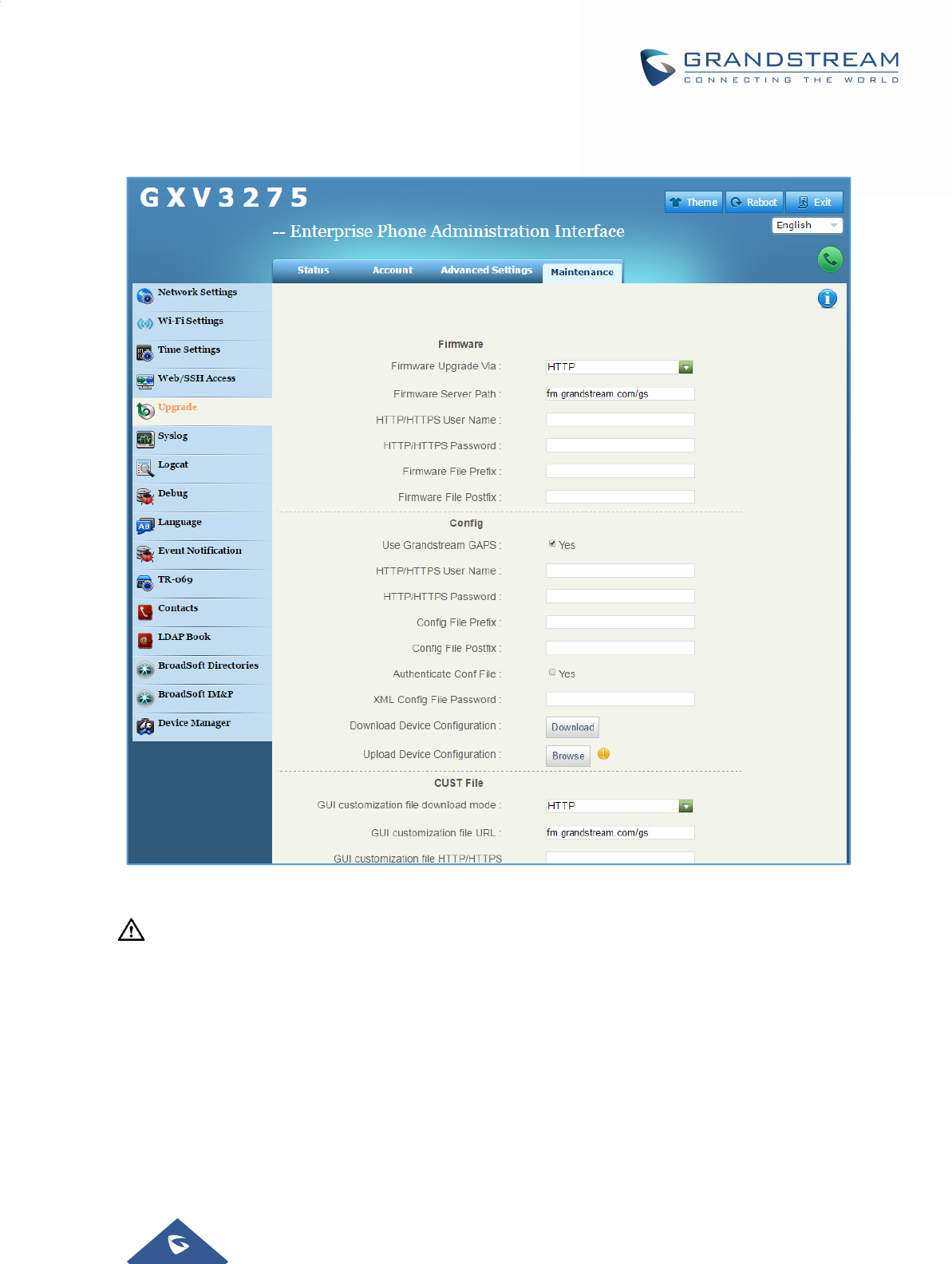
GXV3275 Administration Guide
Version 1.0.3.186
Page |96
via TFTP, HTTP or HTTPS (The default setting is HTTPS). Save and apply the changes, then reboot
the phone.
Figure 24: GXV3275 Upgrade Configuration via Web GUI
Note:
Please do not power off or unplug the GXV3275 when the upgrading process is on.
The GXV32xx supportsSNI (Server Name Indication) TLS extension when using provisioning via
HTTPS.
UploadFirmwareLocally
If there is no HTTP/TFTP server, users could also upload the firmware to the GXV3275 directly via Web
GUI. Please follow the steps below to upload firmware to GXV3275 locally.
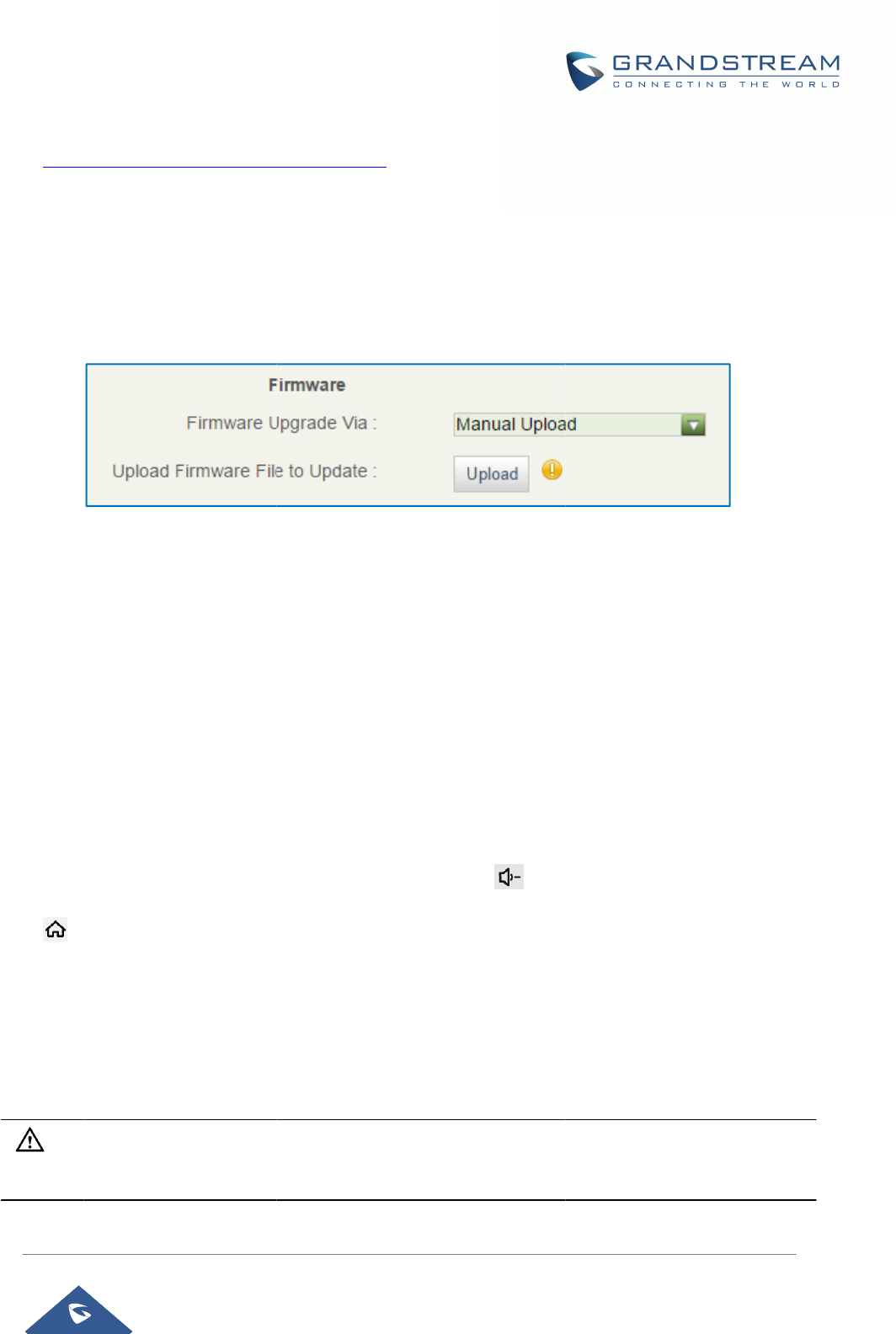
1. Dow
n
http:/
/
2. Log i
n
3. Go to
4. Click
5. Sele
c
"Uplo
6. Whe
n
7. The
p
Note: Th
e
Upgra
d
For users
upgradin
g
1. Dow
n
2. Inser
t
3. Pow
e
4. Wait
f
5. Once
(
t
6. Rele
a
7. The
G
8. Wait
u
9. The
G
10. Chec
k
Note
Upgradin
g
n
load the late
s
/
www.grands
t
n
the Web G
U
Web GUI
M
the "Upload"
c
t the firmwa
r
ad" in the ab
o
n
uploading i
s
p
hone will reb
e
previous up
d
eviaSD
C
that could n
o
g
via external
n
load the firm
w
t
the SD card
e
r cycle the G
X
f
or the LCD k
the light is
o
t
he third LC
D
a
se the keys
w
G
XV3275 will
u
ntil the upgr
a
G
XV3275 will
k
the firmwar
e
:
g
via USB st
o
s
t GXV3275
f
t
ream.com/s
u
U
I as adminis
t
M
aintenance
button, a wi
n
e file from y
o
o
ve step.
s
done, users
oot again wit
h
grade notific
a
C
ard
o
t use remote
SD card is a
n
w
are file to P
to GXV3275
X
V3275 and
eys light to t
u
o
ff, immediat
e
D
key from th
e
w
hen the LC
D
start upgradi
a
ding is don
e
reboot itself.
e
status and
r
o
rage device
i
GXV3275
A
Ver
s
f
irmware file
f
u
pport/firmwa
r
t
rator in the
P
Upgrade,
c
n
dow will be
p
o
ur PC. Then
can see the
u
h
the new fir
m
Figure 2
5
a
tion bar will
b
upgrade or
c
n
alternative.
C and save i
t
.
the 5 LCD k
e
u
rn off.
e
ly press and
e
left) at the s
a
D
screen dis
p
ng and displ
a
e
.
r
emove the
S
i
s not suppor
t
A
dministratio
n
s
ion 1.0.3.18
6
f
rom the follo
w
r
e
P
C.
c
onfigure Up
g
p
rompted to s
e
uploading p
r
u
pgrading pr
o
m
ware versio
n
5
: Firmware Up
g
b
e removed
w
c
ould not acc
e
Follow the st
e
t
in SD card.
e
ys on the bo
t
hold both ke
a
me time.
p
lays the upg
r
a
y the upgrad
S
D card.
t
ed on the G
X
n
Guide
6
w
ing link and
g
rade Via as
e
lect firmwar
e
r
ogress will
s
o
cess starts
o
n
upgraded.
g
rade
w
hen doing
m
e
ss the phon
e
e
ps below to
t
tom of the s
c
ys (the
r
ading bar.
ing process i
X
V3275.
save it in yo
u
"Manually U
p
e
file to uplo
a
s
how at the b
o
n the GXV3
2
m
anual uploa
d
e
's Web GUI
t
upgrade GX
V
c
reen will ligh
t
first LCD ke
y
n the screen.
Pa
g
u
r PC.
p
load".
a
d.
utton where
i
2
75 LCD.
d
upgrading.
t
o upload fir
m
V
3275 via SD
t
up.
y
from the lef
t
g
e |97
i
t was
m
ware,
card.
t
) and

GXV3275 Administration Guide
Version 1.0.3.186
Page |98
NoLocalFirmwareServers
Service providers should maintain their own firmware upgrade servers. For users who do not have a
TFTP/HTTP/HTTPS server, some free Windows version TFTP servers are available for download from:
http://www.solarwinds.com/free-tools/free-tftp-serverand http://tftpd32.jounin.net/.
Please check our web site athttp://www.grandstream.com/support/firmwareforlatestfirmware.
Instructions for local firmware upgrade via TFTP:
1. Unzip the firmware files and put all of them in the root directory of the TFTP server;
2. Connect the PC running the TFTP server and the GXV3275 device to the same LAN segment;
3. Launch the TFTP server and go to the File menuConfigureSecurity to change the TFTP server's
default setting from "Receive Only" to "Transmit Only" for the firmware upgrade;
4. Start the TFTP server and configure the TFTP server in the phone’s web configuration interface;
5. Configure the Firmware Server Path to the IP address of the PC;
6. Update the changes and reboot the GXV3275.
End users can also choose to download a free HTTPserver fromhttp://httpd.apache.org/or use Microsoft
IIS web server.
ProvisioningandConfigurationFileDownload
Grandstream SIP Devices can be configured via the Web Interface as well as via a Configuration File
(binary or XML) through TFTP or HTTP/HTTPS. The "Config Server Path" is the TFTP, HTTP or HTTPS
server path for the configuration file. It needs to be set to a valid URL, either in FQDN or IP address format.
The "Config Server Path" can be the same or different from the "Firmware Server Path".
A configuration parameter is associated with each particular field in the web configuration page. A
parameter consists of a Capital letter P and 2 to 3 (Could be extended to 4 in the future) digit numeric
numbers. i.e., P2 is associated with the “Admin Password” in the Web GUIMaintenanceWeb/SSH
Access page. For a detailed parameter list, please refer to the corresponding firmware release
configuration template in the following link:
http://www.grandstream.com/support/tools
When the GXV3275 boots up, it will issue TFTP or HTTP request to download a configuration XML file
named "cfgxxxxxxxxxxxx" followed by "cfgxxxxxxxxxxxx.xml", where"xxxxxxxxxxxx" is the MAC address of
the phone, i.e., "cfg000b820102ab" and "cfg000b820102ab.xml". If downloading "cfgxxxxxxxxxxxx.xml"
file is not successful, the provision program will download a generic cfg.xml file. The configuration file
name should be in lower case letters.
For more details on XML provisioning, please refer to the following document:
http://www.grandstream.com/sites/default/files/Resources/gs_provisioning_guide.pdf
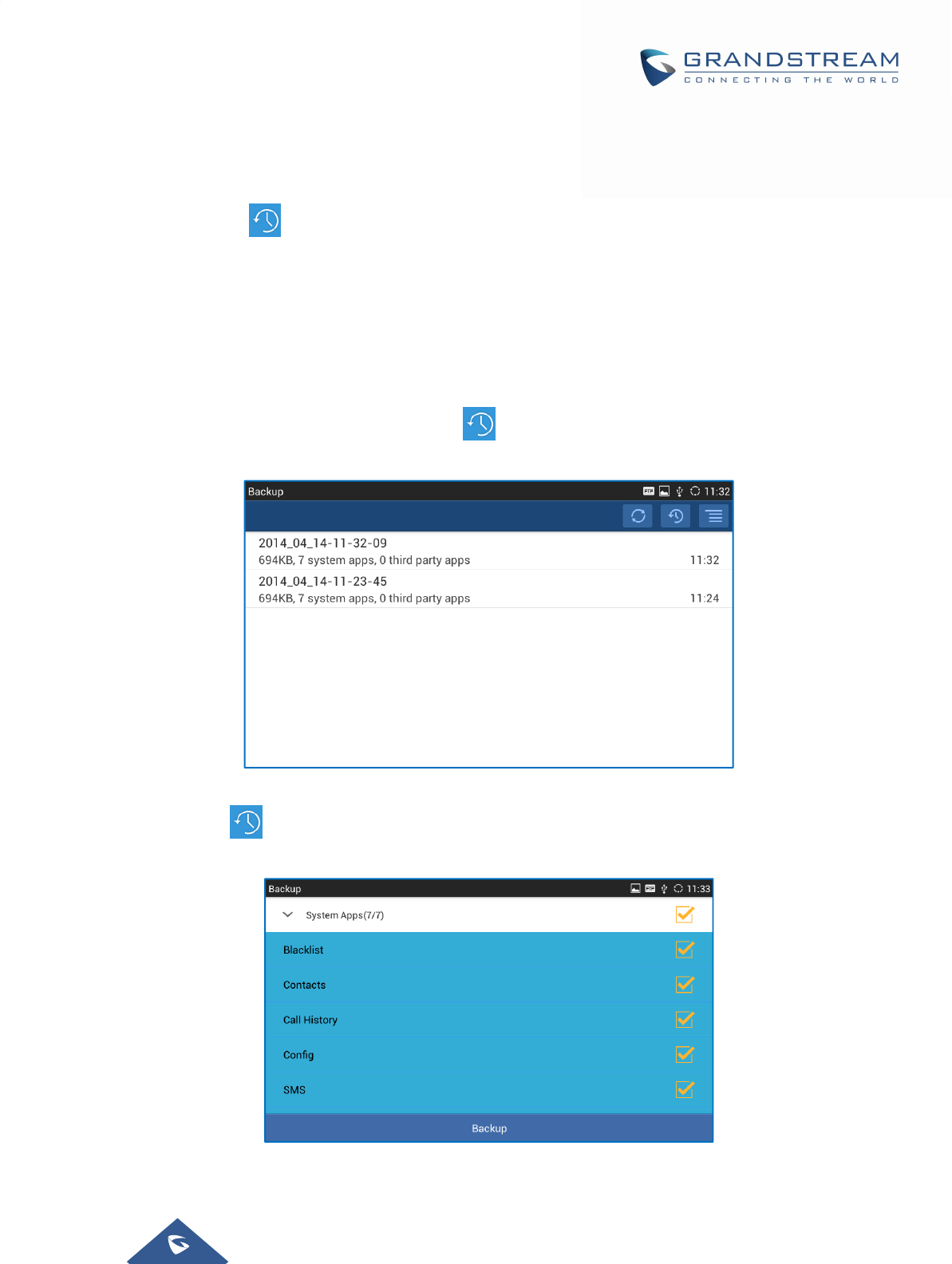
GXV3275 Administration Guide
Version 1.0.3.186
Page |99
BACKUP
The following data on the GXV3275 can be backed up and restored to the phone again using the built-in
Backup application .
System applications: Blacklist, Contacts, Call history, Config, SMS, Calendar and desktop settings
Third party applications
GenerateBackupFile
1. Open Backup application by tapping on icon from phone's menu or desktop.
2. A list the previous backup files will be displayed (if any).
Figure 26: GXV3275 Backup
3. Tap onicon to select the applications to be backed up.
Figure 27: Select Backup Applications
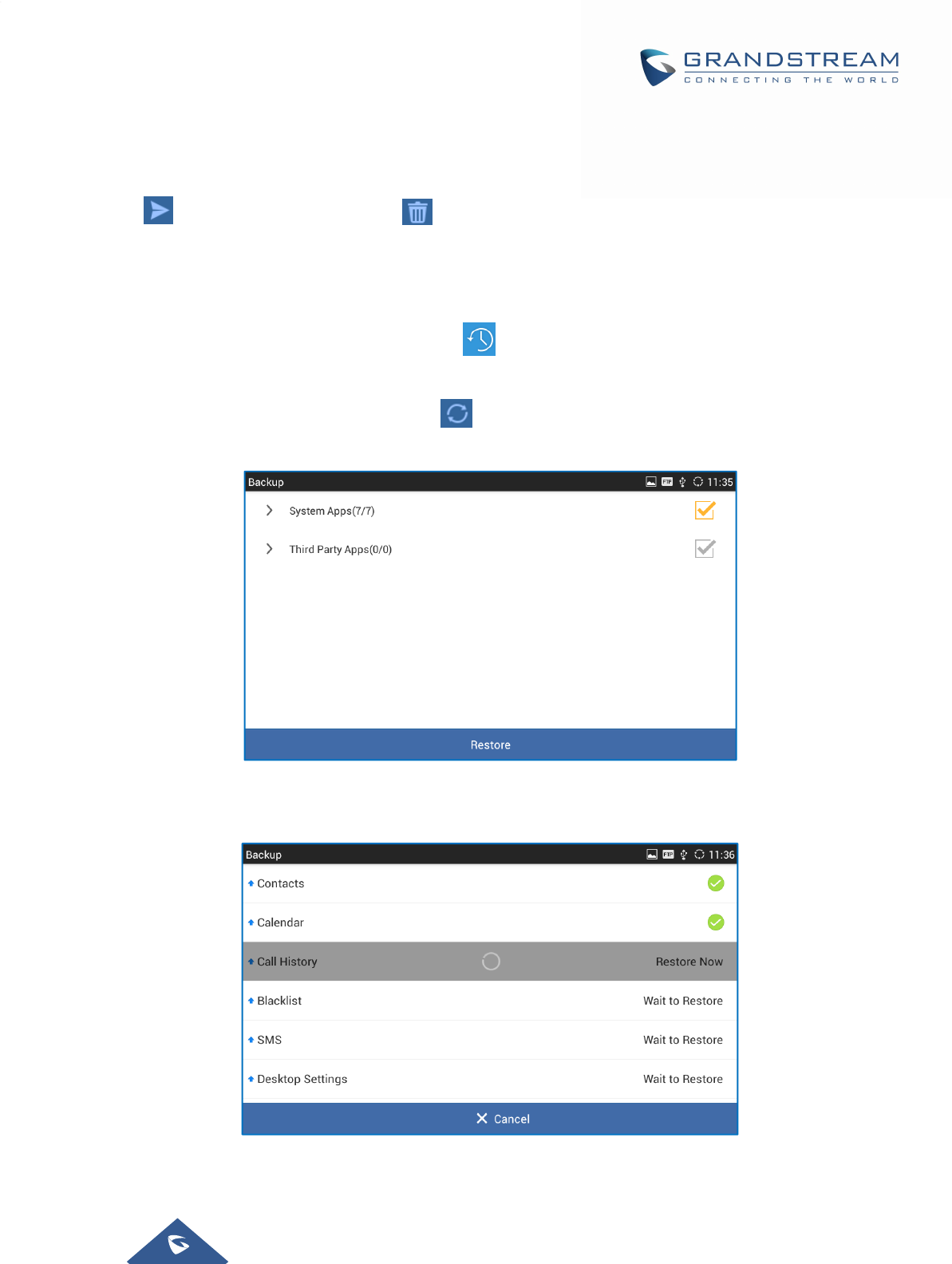
GXV3275 Administration Guide
Version 1.0.3.186
Page |100
4. Tap on "Backup" to start generating the backup file.
5. The backup file can be accessed from Backup application. If users touch and press on the backup file
for about 2 seconds until the checkbox displays, users can then share the backup file by tapping on
or delete the file by tapping on .
6. Or users can go to FileManagerInternal StorageBackup to retrieve the backup files.
RestorefromBackupFile
1. Open Backup application by tapping on icon from phone's menu or desktop.
2. A list the previous backup files will be displayed with backup date and time. If the backup file you would
like use is not displayed in the list, tap on to scan backup files from phone's storage.
3. Tap on one of the backup file to select the applications to be restored from this backup.
Figure 28: Select Backup Applications to Be Restored
4. Tap on "Restore" to start. The LCD will show restore status. Please wait until all the applications are
completed or tap on "Cancel" to abort the restore process.
Figure 29: Restore Process
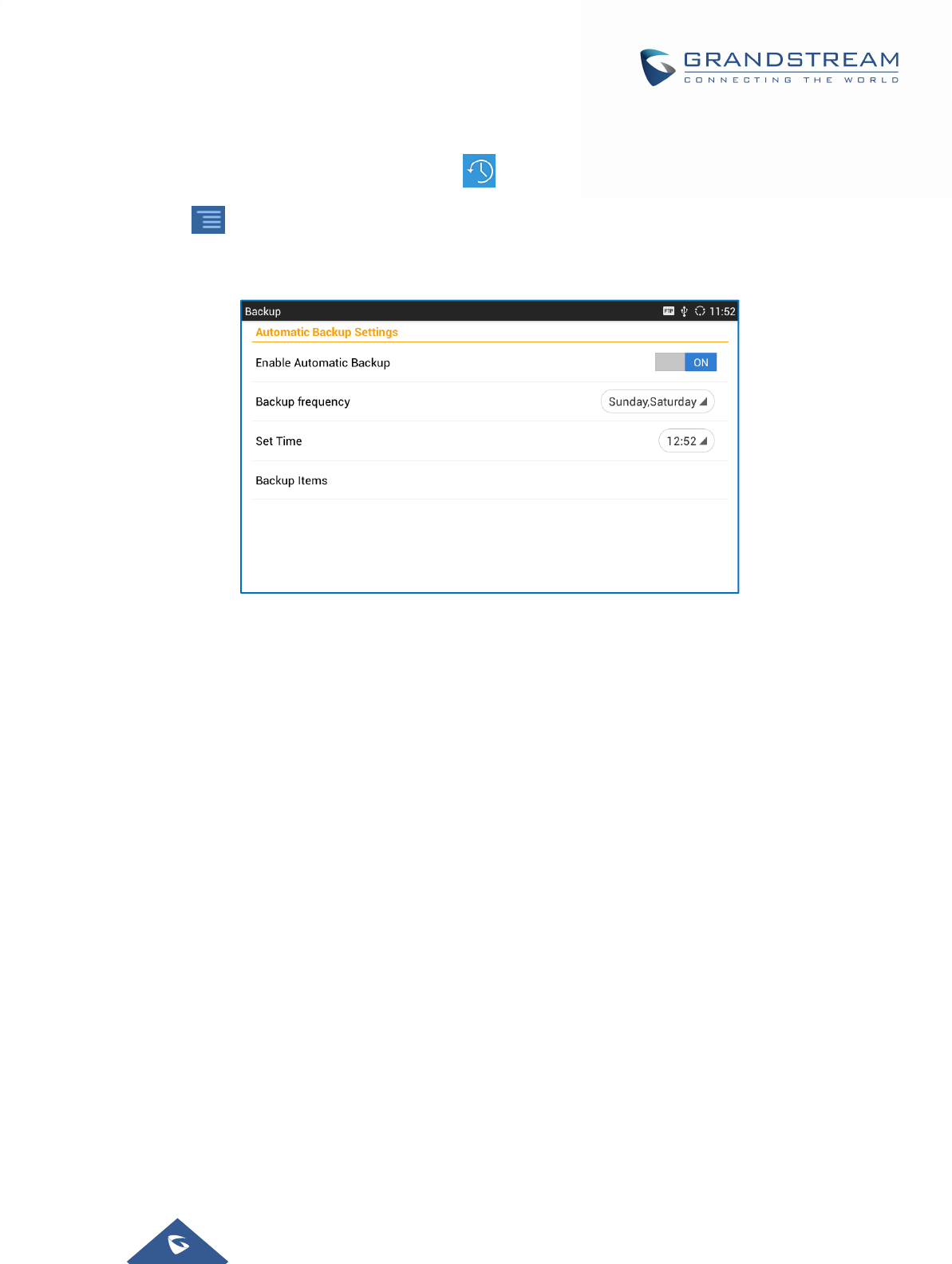
GXV3275 Administration Guide
Version 1.0.3.186
Page |101
AutomaticBackup
1. Open Backup application by tapping on icon from phone's menu or desktop.
2. Tap on and select "Auto Backup".
3. Configure the automatic backup settings.
Figure 30: Automatic Backup Settings
Enable Automatic Backup. Turn on the enable automatic backup on the phone.
Backup Frequency. Select the day of the week for the phone to automatically start backup.
Set Time. Select the hour and minute of the day for the phone to automatically start backup.
Backup Item. Tap to select the applications you would like to backup automatically.

GXV3275 Administration Guide
Version 1.0.3.186
Page |102
DATAWIPING
“Data Wiping” is available under LCD SettingsAdvanced Settings and itallows users to restore all
configuration settings on the phoneand reset P-values to default.
Warning:
Restoring the default settings using Data Wiping will delete all configuration information on the phone
including configuration settings and application installed.Please backup or print all the settings before you
restore to the factory default settings. Grandstream is not responsible for restoring lost parameters and
cannot connect your device to your VoIP service provider.
1. On GXV3275 idle screen, press MENU button and tap on System settings. Or go to onscreen
MENUSettings.
2. Tap onAdvanced SettingsData Wiping, the following figure will show.
Figure 31: Data Wiping
3. Tap on Ok button, a confirmation message will show and invite users to reboot the phone to apply the
default configuration settings as displayed on the following figure.
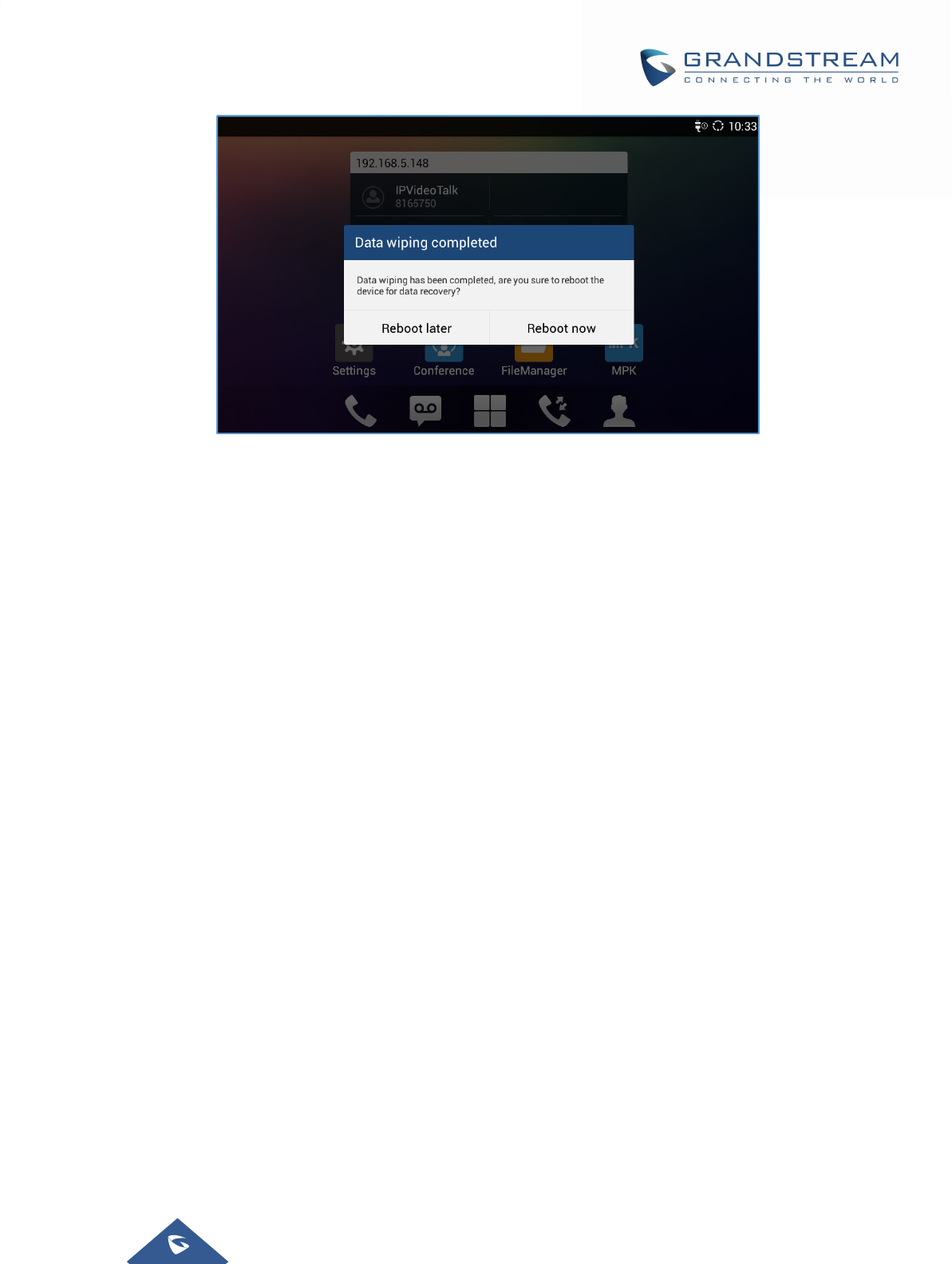
GXV3275 Administration Guide
Version 1.0.3.186
Page |103
Figure 32: Reboot Confirmation Message
4. Select “RebootNow” to reset the phone to defaultsettings or “RebootLater” to apply the default
settings later on.
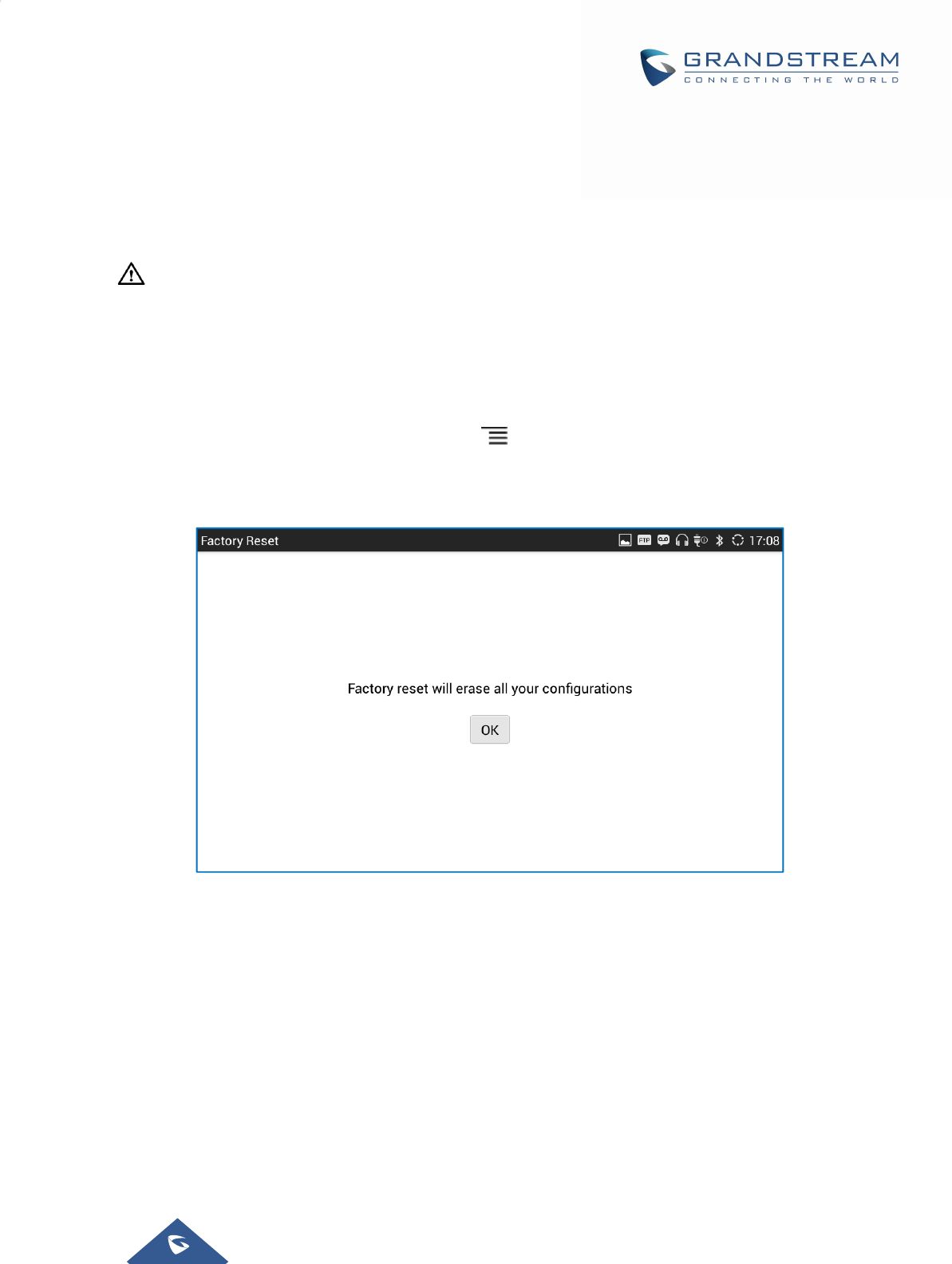
GXV3275 Administration Guide
Version 1.0.3.186
Page |104
FACTORYRESET
RestoretoFactoryDefaultviaLCDMenu
Warning:
Restoring the Factory Default Settings will delete all configuration information on the phone.Please backup
or print all the settings before you restore to the factory default settings. Grandstream is not responsible for
restoring lost parameters and cannot connect your device to your VoIP service provider.
There are two methods to restore the GXV3275 to the factory default settings.
1. On GXV3275 idle screen, press MENU button and tap on System settings. Or go to onscreen
MENUSettings.
2. Tap onAdvanced SettingsFactory Reset, the following figure will show.
3.
Figure 33: GXV3275 LCD - Factory Reset
4. Tap on Factory Reset, a confirmation message will show. Select "Clear the SD Card" if you would like
to delete all the picture, videos and other files from the SD card storage on the GXV3275.
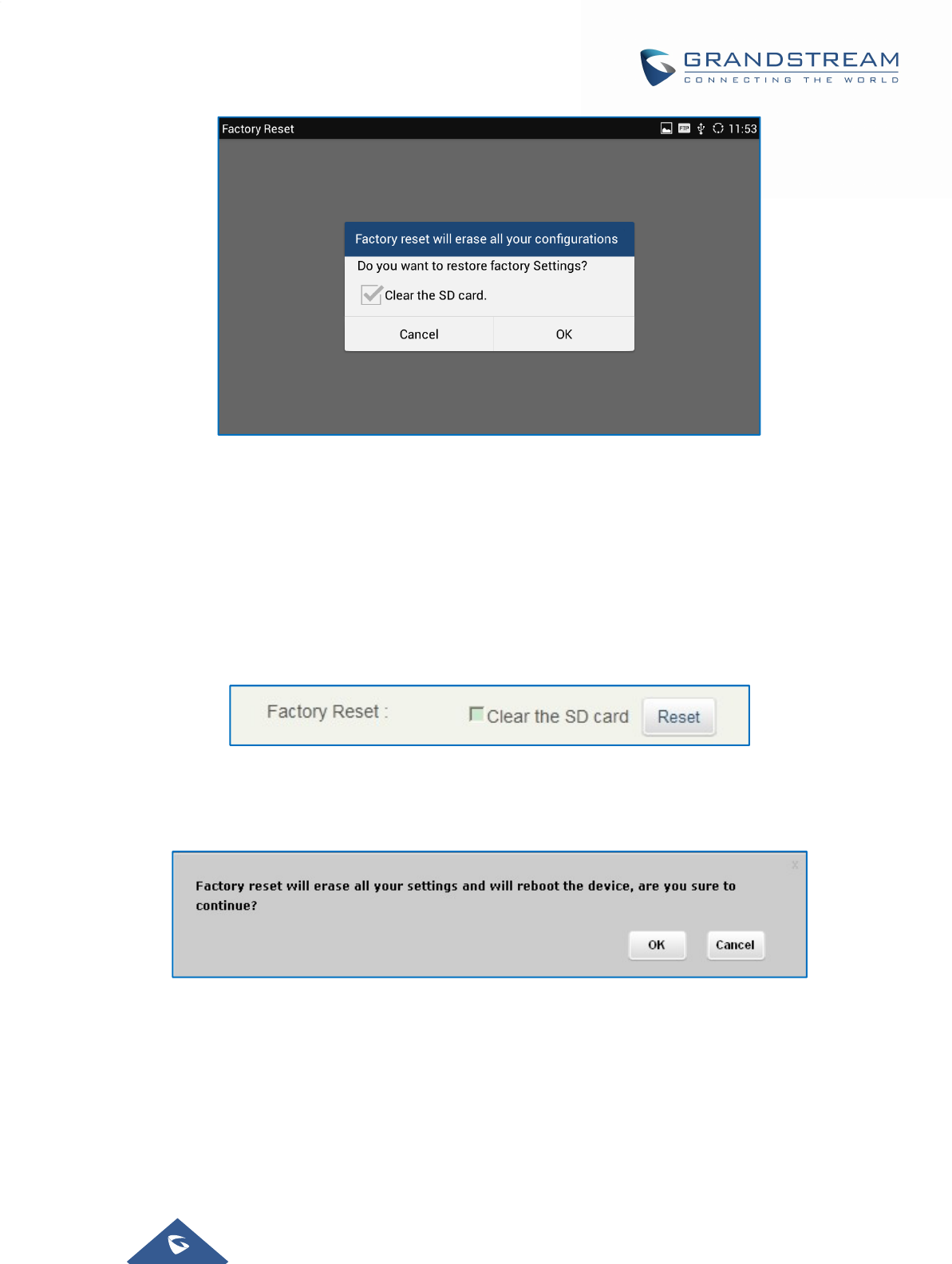
GXV3275 Administration Guide
Version 1.0.3.186
Page |105
Figure 34: GXV3275 LCD - Confirm Factory Reset
5. Tap on OK to confirm.
RestoretoFactoryDefaultviatheWebGUI
1. Login GXV3275 Web GUI and go toMaintenanceUpgrade page;
2. At the bottom of the page, click on the Reset button for Factory reset. Select "Clear the SD Card" if you
would like to delete all the picture, videos and other files from the SD card storage on the GXV3275.
Figure 35: GXV3275 Web GUI - Factory Reset
3. A dialog box will pop up to confirm factory reset;
4. Click OK to restore the phone to factory settings.
Figure 36: GXV3275 Web GUI - Confirm Factory Reset
RestoretoFactoryDefaultviaHardKeys
If users could not access web GUI for factory reset, or when the GXV3275 cannot bootup, follow the steps
below to reset the GXV3275 via LCD keys.
1. Power cycle the GXV3275 and the 5 LCD keys on the bottom of the screen will light up.

2. Wait
f
3. Once
and
4. Rele
a
5. The
G
f
or the LCD k
the light is
o
(the four
t
a
se the keys
w
G
XV3275 will
eys light to t
u
o
ff, immediat
e
t
h LCD key f
r
w
hen the LC
D
reboot with f
a
GXV3275
A
Ver
s
u
rn off.
e
ly press and
r
om the left)
a
D
screen dis
p
a
ctory defaul
t
A
dministratio
n
s
ion 1.0.3.18
6
hold both k
e
a
t the same ti
m
p
lay “Factory
r
t
settings.
n
Guide
6
e
ys (th
e
m
e.
r
eset, please
e
second LC
D
wait”.
Pag
e
D
key from th
e
|106
e left)

GXV3275 Administration Guide
Version 1.0.3.186
Page |107
SAFEMODE
The GXV3275 allows users to enter safe mode by pressing the Menu button during bootup. Before
entering the safe mode, please power cycle the phone and when the plain text “GRANDSTREAM” shows
up, immediately press and hold the Menu button until the phone completely boots up. Users will see
the phone boot up in safe mode.
Under safe mode, only the system applications will be up and running. Normally safe mode is not needed
unless the phone cannot function anymore caused by incompatible 3rd party applications. For example, if
a 3rd party application is downloaded and installed on the phone that cause the phone keep crashing or
freezing and users cannot operate on the phone's settings, users can enter safe mode to remove the 3rd
party application and boot up in normal mode again.

GXV3275 Administration Guide
Version 1.0.3.186
Page |108
EXPERIENCINGTHEGXV3275APPLICATIONPHONE
Please visit our website: http://www.grandstream.com to receive the most up- to-date updates on firmware
releases, additional features, FAQs, documentation and news on new products.
We encourage you to browse our product related documentation, FAQs and User and Developer Forum
for answers to your general questions. If you have purchased our products through a Grandstream
Certified Partner or Reseller, please contact them directly for immediate support.
Our technical support staff is trained and ready to answer all of your questions. Contact a technical support
member or submit a trouble ticket online to receive in-depth support.
Thank you again for purchasing Grandstream Enterprise Application phone, it willbe sure to bring
convenience and color to both your business and personal life.
Modulation mode:
Bluetooth: GFSK; π/4-DQPSK; 8DPSK
WiFi : DSSS/OFDM
Maximum of Antenna’s Gain:
Bluetooth/WIFI: 2.0dBi
* Android is a trademark of Google Inc.
*Skype and Lync are Registered Trademarks of Microsoft Corporation.
HDMI, the HDMI Logo, and High-Definition Multimedia Interface are trademarks or
registered trademarks of HDMI Licensing LLC in the United States and other countries.